Text Resize
buttons

|
Background
Although large numbers of commercial holsters were manufactured and sold, the commercially manufactured holsters for the pistols are difficult to find these days and the reasons for this are quite simple: most people who buy a pistol, even today, don’t plan on carrying it around with them, so they don’t buy a holster. Also, commercial holsters were generally not as well made as the military holsters, therefore they deteriorated rapidly.
The famous sporting goods house of Abercrombie and Fitch in New York reports that most holsters for the pistols they sold (including Lugers) were made to a customer’s individual requirements, so a great variety of A&F holsters were put out. Abercrombie and Fitch dealt with two firms who produced their holsters: Heiser of Denver, Colorado (out of business) and K. Leather products, Inc., of New York (still in business as of the printing of the mini-manual).1
E. Bender in Luger Holsters And Their Accessories2 additionally states that: A&F Lugers are a very rare collectors item. The surviving holsters are even more so.
Featured is a very rare Abercrombie & Fitch, a.k.a. A&F commercial holster for a pre-WWI Cal 9mm Luger. The holster was originally offered as part of a rig as evidenced in the retailer’s ad with accompanying Letter of Authenticity, initially pistol and holster being extolled as inseparable. However, apparently the retailer and/or the consigner had a change of heart regarding the pistol and holster staying together, thus separating the two, which was more than likely a monetary decision, taking higher importance or precedence over the collectible status of union.
The A&F Luger holster, identified as variation 1, started out as the primary subject of this article. However, as a result of additional research and acquisitions, the article has expanded to include many other equally interesting non-Luger A&F holster variations, A&F catalogs, the evolution of A&F Luger pistols, accessory advertising, and patent history information. The article layout is presented as information and items were located and identified. However, the main emphasis of the article still strives to focus on the A&F Luger holsters of several leather makers and A&F catalogs which are all part of the LOB collection unless otherwise noted. The A&F Luger holster variation designations used in this article are for identification purposes only and as such do not represent any specific chronological order of manufacture or style.
The retailer, in the above holster description, makes a curious statement or claim that: This holster was made for the 4" barrel pistols, not the later 4¾ inch barrel pistols. That the holster was made for a 4 inch barrel Luger is obvious. However, the claim that the 4¾ inch pistols came later is incorrect. Approximately 20,000+ old model 4¾ inch barrel, Cal 7.65 m/m Lugers, including approximately 12,000 old model American Eagle Lugers were made before the very limited production run of the 4 inch barrel, late old model Cal 9m/m FAT barrel Lugers in the 22,000 serial number range. What the retailer probably meant to say is that: This holster was made for the 4 inch barrel late old model FAT barrel Cal 9mm Luger and not the later new model 4 inch barrel Cal 9mm pistols or alternately, not for the later 1920s Abercrombie & Fitch special 100 gun order of Swiss chamber crested 4¾ inch barrel (51) 7.65mm and (49) 9mm Luger pistols.
Retailer’s “modified” ad for 1902 Cal 9mm American Eagle Fat Barrel Luger and A&F holster.
| |
DWM MODEL 1902 'FAT BARREL’; 9 mm; 99% blue, 99% straw, excellent bore, excellent grips, 3 7/8 inch barrel. This Luger is, with the exception of very minor wear ageing and a tiny chip on the lower front tip of the grip panel, in the same condition as it left the DWM factory in the 1902-1905 period. The finish, parts and markings are all original. The parts that were originally numbered are matching serial numbers. The magazine is the correct wood bottom stamped 'Cal. 9M/M'. Approximately 600-700 of this model were produced in the 22,000-23,000 serial number range. This pistol is one of the best examples of this model I have seen. This pistol came with an early Abercrombie & Fitch 4 inch holster which is being sold separately-our item number C12500, s/n 22606, Catalog Number AE-30
| |
The Letter of Authenticity states that …the holster should stay with the pistol as they may have been purchased together. This statement is based on information, hand written in ink on the back side of the holster body, to the left of the single (detached) belt loop, with the owners’ name, location and date: Walter Bertolette, Silver City, New Mexico. June 16, 1916. Note the owners’ handwriting was so small and illegible that the information was recovered by magnification and infrared imaging techniques. This is interesting, since the story was told to the retailer by the consigner, a Ph.D., who had the infrared equipment available. He also mentioned that the rig had been passed on for many years from doctor to doctor as some sort of reward or token of gratitude for services rendered. According to a personal conversation with the last owner, the rig can traced back through three owners to the end of WW2 or the early 1950s.
Also in the retailer’s sales ad were two additional pictures, one showing a period 1909 and 1910 A&F catalog on page 278 showing a similar holster, with an opposite page 279 text description for a 120 mm barrel 30 Cal commercial, right side belt-loop Luger holster and a second 1905 A&F catalog picture on page 180 showing an old model 30 Cal Luger with a text description for the pictured Luger and a text description only for a Cal 9 mm Luger.
Also described is a Luger Automatic Carbine. The seller, although giving no explanation for the additional pictures in the ad, seems to be attempting to link the variation 1 holster, time-wise, to the 1909 and 1910 A&F “No.7” right side belt-loop holster ad, and more importantly attempting to link the 1902 AE Cal 9 mm Fat Barrel with the 1905 A&F Cal 9mm Luger text description, thereby attempting to associate or imply the ad is describing the late old model Cal 9mm Fat Barrel Luger. The assumption or assertion being that the new model 30 Cal and 9mm Lugers weren’t introduced, at least in sales catalogs, until 1906 or possibly later, which is true.
Interestingly there are three other genuine identified examples. The first example being a period A&F holster, identified as No.6 has been identified on the same page 278 of the 1909 and 1910 A&F catalog with the identical A&F trademark logo with a single belt loop on the unmarked back side being for a Smith & Wesson 32 Cal revolver. The second example being a 1909 or earlier A&F trademark logo stamped Holster, made for A&F, holster maker unknown, for an unknown model of single-shot pistol or revolver, possibly a Colt. This identical holster is also pictured in the 1909 and 1910 A&F catalog on page 277, shown with a holstered revolver and is described on page 279 as: No. 9. Flap holster, with strap and snap-button fastener. Hand made of fine “Indian tan” leather. For single shot pistols, $1.50. For revolvers…..$2.25. The third, which is a very fine example, is the same style as the catalog pictured No. 9 example, except for a medium size revolver with a very distinct A&F circular logo, and made of heavy russet leather vs. “Indian tan” leather. Except for the accompanying No. 9 text description, there is no other catalog holster description for this medium size, heavy russet leather variation. The A&F embossed logo snap fastener assembly was made by the United States Fastener Company and is identical to all other circa 1909 and later A&F holster snap fasteners featured in this article.
This is an example of an advertised A&F holster style, in this case of No. 9, first advertised in the 1909 A&F catalog, being identified and offered in multiple sizes of basically the same style. The catalog pictures a large size, whereas the subject holster is of medium size, and interestingly of a different type of leather than described. A similar holster is pictured on page 278, identified a No. 6 and described on page 279 as: No.1. Heavy russet leather with embossed edge (border piping). Flap and stud fastener. For Colt automatic pistol….Price $1.00. The No.6 holster is basically the same style as the No.9, both with closed toe, except for the cover flap closure method of which the No.6 is a direct snap, whereas the subject holster utilizes a strap closure. The subject holster closed toe uses a leather plug vs. the Nos. 6 and 9 holster closed toes, which are stitched together, without using a leather plug. Pictured, side-by-side are two original A&F catalog holsters, No.9 and the subject holster. Also pictured together for comparison is the 1909 A&F catalog holster No.6 and the subject holster. Heiser catalog holsters offered closed toe holsters with an extra charge for a holster body toe leather plug, perhaps A&F catalog special order holsters had the same option.
In addition to the circular A&F leather stamped trademark logo on the 65 – 70 degree angled/sloped, pointed or tear drop style cover flap holster is a convex, circular brass snap button, featuring the well-known five-character set A&F trademark logo pictured in the 1909 and 1910 A&F catalogs on page 279 as holster No.9. The snap button closure and method and angle of strap attachment to the back side of the holster body of examples 2 and 3 above, is identical to the featured variation 1 A&F holster with rounded style cover flap for a 9 mm 4 inch barrel Luger, also shown in the 1909 and 1910 A&F catalog on page 278 as holster No. 7.
The 1906 A&F catalog on page 183 has an identical ad for a 30 Cal, 9mm Luger and Luger Carbine, as the 1905 page 180 A&F catalog. Interestingly, both the 1905 A&F catalog and the 1906 A&F catalog features the identical cover page, an owl and ax, also interestingly both catalog covers with different addresses. which supports the chronology or printing date of the 1905 catalog because, as of 1903 Abercrombie & Fitch was located at 314 and 316 Broadway, the address on the 1905 catalog, whereas, the May 1909 issue of Field & Stream shows Abercrombie & Fitch’s new address to be 57 Reade Street, being the 1906 catalog address, of which the move is explained on the introduction page of the 1906 catalog.
The descriptive text of both the 1905 and 1906 A&F catalog Luger ads make no distinction in their 9mm Luger descriptions as to old or new model, therefore, one can conclude they are for the same late old model American Eagle 9mm fat barrel Luger. Since there are no identified early Luger sales ads describing, also without any pictures, specifically of the late old model 1902 American Eagle Fat Barrel Luger, then both the May 1, 1905 and May 1, 1906 dated A&F catalogs are describing the late old model grip safety Cal 9 mm Luger, which is accurate, as the distinction, in period Luger sales ads, between the old and new model Lugers was not established until at least until 1907, at the earliest. Interestingly, the identical 1905 and 1906 A&F catalogs, although describing the late old model Cal 9 mm 4 inch barrel Luger, do not list 9mm ammunition for sale, which coincidently, prior to WWI, most Cal 9mm ammunition was imported.
Also there is no known (dated or undated) Hans Tauscher advertising literature with pictures or text describing the late old model American Eagle Fat barrel Luger. The earliest identified circa 1907 ads being for the new model Cal 9mm 4 inch barrel grip safety Lugers.
Since none of the identified pre-WWI A&F catalogs picture a 9 mm 4 inch barrel Luger, nor a Cal 9mm Luger holster, it is difficult to establish a date for the introduction of an A&F Cal 9mm 4 inch barrel holster. A possible reason that there were no A&F catalog ads being the very small number of 9mm Luger owners ordering a holster. The possible thinking by A&F was that an ad picturing a standard, to be worn on the right side, 30 Cal 4¾ inch barrel belt loop holster would be sufficient and any holster orders for the four inch barrel Luger, old or new model, would be treated, i.e. made on a one-on-one request. Regarding the 30 Cal 4¾ inch barrel version of the holster, pictured is one such "right-sided" holster, possibly sold by A&F with a 1923 A&F barrel marked 9mm Luger. Assuming A&F offered these standard right-sided holsters with their 1920s special import ordered and marked 30 Cal (51) and 9mm (49) Lugers, suggests that the, essentially same style, A&F 30 Cal 4¾ inch barrel holster has been around for at least 20 years, from around 1905 through 1925 and later and are more common, relatively speaking, than originally thought.
Regarding the second picture in the retailers’ ad showing an A&F catalog page with a similar holster, the association to the variation 1 holster is even more tenuous. E. Bender in Luger Holsters and Their Accessories states on page 458 that: Abercrombie & Fitch sold a variety of pistols other than Lugers, and most holsters were custom-ordered. With that said, an A&F holster “hand” made for a 30 Cal 120mm barrel commercial Luger, the appearance can vary slightly, from one holster to another which, in this case, only resembles the holster pictured in the A&F catalogs. For example, the early 1905 and 1906 A&F catalogs show renderings of their Luger holsters for sale, which only resemble the real holster, whereas the 1910 A&F catalog actually shows an, albeit poor quality photograph of the holster, interestingly highlighting the A&F circular logo.
This difficulty in identifying a specific style is illustrated by several actual real examples in this article. Not one A&F holster is exactly the same. Obviously handmade, special order holsters were ordered through Abercrombie and Fitch and were either made by Heiser of Denver, Colorado, K. Leather Products, Inc. of New York (as stated in a 1973 Guns and Ammo mini-manual publication entitled Lugers that was mentioned earlier) or other later identified leather makers as illustrated in the following four examples shown below.
The holsters pictured are all made for the 4¾ inch 30 Cal Luger and are all different; from the length of the strap and the location of the snap, to the location of the cover flap stamped A&F logo, with at least two different identified style of belt loops. All of these differences noted in only four examples supports the individual special order hand-made status of these holsters.
There is one detail of construction that ironically, is shown in the 1909 and 1910 A&F catalog, page 278 photograph picture of holster No. 7 for a 4¾ inch barrel Luger holster, that is consistent with this particular period variation 1 four inch barrel Luger holster.
This feature of construction cannot be seen in the 4¾ inch barrel actual A&F holster, black and white and color pictured examples, but can be seen on the variation 1, 9 mm A&F holster, by simply lifting the cover flap or looking at the rear. The difference is in the upper termination trailing edge of the holster body front leather piece which stops, not quite flush with the back side edge, but just inside. This feature, clearly seen in the 1909 and 1910 A&F catalog holster page of No. 7 at first was thought to be insignificant, or not even noticed, but does become apparent, with an actual example to compare, connect the 1909 and 1910 catalog No. 7 Luger holster style with the variation 1 holster, which has the identical feature as does, probably, some of the 4¾ inch barrel Cal 7.65 mm A&F holsters identified in this article.
Abercrombie & Fitch Cal 9 m/m Luger holster, variation 1
The dealers' description is fairly accurate as far as it goes. However, the following expanded, detailed description in text and high resolution pictures from an extensive and thorough, personal inspection shows the following characteristics. The rigid holster is very sturdy, made with a 4 – 5mm thick, rich Chestnut color, Russet leather with a total weight of 222 grams or 7.8 ounces. The length of the holster is approximately 9 inches x 6 inches wide x 2 inches deep. The holster body was made or formed/molded to meet the contour or shape, in profile (front to rear) and especially (left to right) of a 4 inch 9 mm Luger, 28 mm wide at the barrel end and 43 mm wide at the receiver/frame. Subtracting the front and rear holster wall body thickness at the bottom barrel end of 5 mm from the total 28 mm width, leaves an inside lower holster body oval cavity (leather plug), short width dimension of 23 mm for the barrel. With the barrel sight band outside diameter of a 9mm fat barrel Luger of 15.5 mm, leaves about 7.5 mm of free space around the barrel or 3.75 mm per side. The longer 29 mm inside dimension of the holster body oval cavity (leather plug) at the end or bottom is meant to accommodate or fit the barrel integral sight band, block and sight blade total height of 23 mm, again leaving about 6 mm of free space around the barrel end, height-wise or 3 mm per side. The “detached” belt loop dimensions are 37 mm wide (1.46”) x 100 mm (3.9”) long with two parallel lines of stitching, 2.8 mm apart, originally attached at the top through the inside surface of the belt loop, then folding over at the top and attaching at the lower end directly.
The cover flap leather securing strap is approximately 140 mm (5½ inches) long x 20 mm x 3.3 mm thick and is attached to the holster rear by stitching and wraps around the holster body to attach to the cover flap using a snap fastener method. The 15.6 mm diameter circular metal snap fastener surface is convex with a very stylized five-character set A&F Co logo stamped in relief (embossed). The cover flap leather is deeply stamped with a 24 mm diameter circular A&F logo with an upper case spelling of ABERCROMBIE & FITCH CO. - NEW YORK - stamped on the outer circumference of the logo also with a very stylized five-character set, similar to the metal fastener snap, stamped in the center. The cover flap metal fastener snap is a combination of steel, brass and copper with the top surface being steel. The stud attached to the holster cover flap is brass with three letters, U.S.F., probably the manufacturer’s or supplier’s name, stamped on the inside cover flap stud 12.7 mm diameter, circular retention flange.
As to what 9 mm 4 inch commercial Luger, late old model grip safety fat barrel, or new model grip safety with a P.08 style barrel was used with the variation 1 holster, there is no doubt that it was a late old model American Eagle fat barrel Luger. This is based on the impression left of the right side leading edge of a dished toggle in the holster body interior rear wall, even to the minute detail, partial impression of the old model toggle knob grasping surface fluting pattern. The long term storage is also confirmed by the deep impression of the rear frame cam edges left in the cover flap interior surface, along with a slight impression of the rear link lower protruding angled edge.
The holster itself can be dated to June 1916, however, trying to affix an earlier date to either the manufacture of the holster or when the holster was made by special order for a 1902 fat barrel Luger is more difficult, short of a dated “bill of sale”. Since the holster was indeed, a special order, hand-made for a Cal 9mm American Eagle Fat barrel Luger made in 1904-5, would place the manufacture of the holster to possibly, no earlier than 1905 or 1906, assuming the Luger was sold new, in the same time frame. Other possible scenarios is that the owner ordered the holster for his pre-owned 1902 fat barrel Luger in 1916 or that he bought the holster and pistol together in 1916 as a pre-owned rig, when he marked the holster, which is the most likely scenario as it is usually the immediate receipt of an item, new or used, when the new owner marks his new possession. Another consideration that puts one, and only one Luger with this holster, is the fact that, other than minor scuffing and normal wear, attributed solely to age, the holster is in good to excellent condition as is the originally retailer advertised, near mint condition of the Luger that was first offered with the holster.
In summary the variation 1 A&F holster, which is a classic example of a special order hand-made holster, is not only for a pre-WW1, late old model grip safety, Cal 9 m/m 4 inch American Eagle fat barrel Luger, which is much less common, relatively speaking, than a new model grip safety American Eagle Cal 9mm 4 inch barrel Luger and extremely less common, also relatively speaking, than an A&F holster for a 30 Cal, 4¾ inch barrel, old or new model commercial Luger is the fact, which ironically, wasn’t mentioned in the retailer’s ad description, is that the variation 1 belt-loop holster is left-handed, i.e. to be worn on the left side. In other words, an extremely rare and unique, early turn-of-the-century, special order Abercrombie & Fitch Cal 9mm 4 inch barrel Luger holster, a Luger collectors’ treasure, in any condition!
The variation 1 A&F holster is now part of an exceptional rig with another 1902 Cal 9mm American Eagle Fat Barrel Luger, of equal condition, and is within 21 serial numbers to the one originally offered with the holster.
Also featured herein is yet another, heretofore, unknown Abercrombie & Fitch custom order left-hand side holster variation for a 4 inch barrel Luger with an oval A&F Co stylized logo on the rear belt loop. The holster leather is thick, dark brown in appearance and in well used condition. The threads in the toe section are missing and there appears to be a metal clasp added at the seam to keep the toe together. The front "tear-drop" or “pointed” style cover flap, which is unusual for an American holster, has a snap button fastener closure with the circular, convex button surface sporting the well recognized A&F Co stylized trademark logo. An inspection mirror was inserted into the holster body cavity to reveal that the back side of the holster body male brass stud has the same U.S.F. stamping as the variation 1 holster, i.e. an identical A&F Co snap fastener assembly.
Curiously, to the right of the holster body cover flap snap button is a vertical slit, which appears to be for a slit-and-stud-like closure, yet there is no additional corresponding stud affixed to the holster body. The purpose of the added cover flap vertical slit was identified when inserting an old model American Eagle FAT barrel Luger into the holster body, which incidentally, fits perfectly. The problem occurs when attempting to close the cover flap and engage the snap fastener, which requires a slight pulling down force to snap shut, resulting from the left side facing cover flap contact with the Luger rear frame area.
Apparently one of the original owners of the holster, obviously not a collector, found that by rotating the cover flap slightly to the left, thereby resulting in the lifting the cover flap in the upper left corner, away from the rear Luger frame area released the slight tension, decided to add the slit in that position and use the holster body stud to secure the cover flap. Without a Luger inserted into the holster, the cover flap and snap fastener tends to center itself over the original holster body brass stud. Therefore, with a Luger inserted and the cover flap closed using the added slit and original holster body brass stud, a slight tension was created in the cover flap resulting in a slight left-side accentuated offset bulge in the cover flap leather slit.
Regarding the missing stitching threads at the holster body toe, this also appears to be deliberate action by the holster owner, in conjunction with the added holster cover flap slit described above, to allow the barrel tip more clearance by allowing the lower holster body toe extension to slightly expand to better seat or accommodate the barrel end and/or to provide for moisture relief. The several “threaded” loops of very fine wire placed at the holster toe to keep the seam from separating, after the small section of stitching was removed was done early on, supporting the theory that the stitching was deliberately removed and did not naturally separate, i.e. and not due to age and use.
There is no doubt of the authenticity of the holster being of A&F origin as the holster body was made using the same basic pattern as the variation 1 holster as evidenced by the identical seam termination as pictured in other A&F holster variations and in most importantly as pictured in the 1909 – 1911 A&F catalogs. The differences are:
- The entry shape of the holster body.
- The tear-drop or pointed shape of the cover holster flap vs. rounded.
- The oval shape of the outside upper case, full name of ABERCROMBIE & FITCH Co. – NEW YORK surrounding the center stylized A&F Co. logo stamping, being located on the holster back side belt loop.
- The closed holster body toe vs. the variation 1 toe plug. These features, combined, along with the different oval style logo tend to err toward a different leather maker or supplier to A&F, being possibly an earlier version, not pictured in any A&F catalog.
The following comments are purely speculative, based on scanty evidence and few examples extant, and are subject to individual interpretation.
The identity of another period holster with the same type oval style A&F Co. logo as on the variation 2 holster, of dark brown “Indian tan” leather construction with an identical stitching pattern, advertised with a model 1902 Colt semi-auto 38 ACP pistol, challenges the above number 4 assertion of another, earlier A&F leather maker supplier. Furthermore the similar holster body stitching pattern of variation 1 and 2 full cover flap four inch barrel Luger holsters, along with the pre-1905 made for A&F variation 1 Luger holster and the 1902 Colt semi-auto holster belt loop with a similar stitching pattern, links or A&F by the same leather maker.
The difficulty is in reconciling the two different style, oval and circular A&F Co. leather stamped logos with the same unidentified holster leather maker, except to say that the 120 mm barrel version variation 1, heavy Russet leather holster with the circular stamped logo on the cover flap is only seen on circa 1909 and later A&F holsters, first pictured on holsters advertised in the 1909 – 1911 A&F catalogs. Since the first stylized design, five-letter character set, stand-alone A&F Co. logo first appeared in the 1905 catalog, which is the center piece for all the later ensuing leather stamped holster logos; oval, circular or rectangular and it is the five-letter character set A&F Co. logo that is pictured, only in the catalogs, starting from 1905, coincidently not trade-mark registered until 1907, then the holsters with the added full company name in upper case letters ABERCROMBIE & FITCH Co. – NEW YORK, forming an outer oval cartouche style shaped logo, could have been made in the time frame of 1905 – 1908, which also supports the fact that both the variation 1 and 2 holsters sport the “circular” A&F Co. embossed logo push button snap fastener made by the United States Fastener Company or U.S.F. Also, as a matter of note, the stylized five-letter character set A&F Co. logo that first appears in the 1905 catalog and subsequently embossed on a snap fastener, was not introduced as a circular logo, nor within a circular cartouche. It is the curved shape of the letters, especially when placed on a circular button that creates the appearance of the logo being circular.
Since both variation 1 four inch Luger barrel holster (pictured in the 1909 – 1911 A&F catalogs as No.7 for a 4¾ inch barrel), variation 2, also for a four inch barrel Luger, and the A&F Co. oval shaped logo stamped holster, made for the 1902 Colt pistol share specific options, identified in period Heiser holster catalogs, such as “Heavy Russet leather”, “Indian Tan leather” and open holster body toe, with a leather plug option or closed holster body toe design, supports H.H. Heiser as the probable leather maker. Another commonality or feature that errs toward Heiser origins is that the United States Fastener Company or U.S.F. initial identification stamped snap fasteners was the supplier used with variation 1 and 2 holsters and whose initials has been identified, with varying snap fastener styles, on several period Heiser made holsters, examples being Heiser holster style 419, 421, 928, all having a U.S.F. identification stamped snap fasteners, plain surface or with the HHH Heiser embossed logo. There are other period company snap fasteners, used on Luger holsters, such as United Carr, but not as yet found on Heiser holsters.
Of the five A&F holster variations featured in this article, this is the only holster that can be identified to a specific leather maker, namely H. H. Heiser of Denver, Colorado. In fact the exact style No 428 is pictured in a rare 1920s H.H. Heiser catalog on page 16. The holster is part of a series of Heiser holsters described on page 16 as Automatic Belt Holsters made of Heavy Oak Tanned California skirting leather, all in one piece, wax thread stitched, unlined, open end, riveted at end of stitches. This particular style is additionally described as being; of fine, smooth finish of medium leather thickness.
This holster was originally part of the Mike Morris Collection featured in Luger Holsters and Their Accessories of the 20th Century by E. Bender on page 537. The holster is incorrectly identified as a 4¾ inch open-style holster being pictured with a 1920s A&F 4¾ inch 30 Cal Luger, one of 51 ordered by A&F fitted with a two line Abercrombie & Fitch Co.- New York – Made in Switzerland roll die stamped Hammerli barrel. With a 4¾ inch barrel Luger inserted, the barrel exits the toe end by 11 mm, whereas, with a 4 inch barrel Luger inserted the barrel properly seats 9 mm from the open toe exit. Also the Bender picture shows the wrong style A&F trademark logo, misleadingly stating that it is the: A&F Logo On Rear.
The fourth featured holster is a basic pre-1925 P.08 style holster with the following characteristics and features common to a commercial P.08 holster, consisting of a full bucket style cover flap, secured to the holster body with a metal buckle and leather strap with a parallelogram style stitching pattern. The cover flap of another commercial holster also has a non-standard attachment for the leather strap with an equally angled three-sided rectangular stitching pattern, quite different from the standard P.08 strap attachment with three parallel stitching lines. The twin bell loops are not stitched, but are attached with four steel, pan headed rivets as is the holster body short leather strap and metal buckle fitting. The method of securing the rivets is unusual. A separate magazine pouch is attached to the holster body spine. The holster body backing is made of two pieces of leather.
The dyed black holster is very professionally made with border piping on all individual leather parts, using leather all from one hide, i.e. this is not a made-up holster of different leather parts and has not been “enhanced” in any way and is configured, as originally made, with no repairs. The holster, though, is not as sturdy as a typical German P.08 commercial holster, using slightly thinner leather and it is totally non-military, lacking a holster body pull-up strap and a combination loading tool pouch under the cover flap. The method of securing the twin belt loops and the holster body metal buckle leather strap with blank-faced rivets is not used on military P.08 holsters. However, they are used on some German commercial holsters.
The overall stitching is very tight and even, similar to other observed German commercial P.08 style holsters. However, using the stitching pattern and style to identify either the holster manufacturer or the country of origin is tricky as the variation 1 holster stitching pattern compares favorably to some German made holsters, commercial and military and is, in some instances, better than others as shown in this pre-WWI commercial Luger holster. The hinge piece is attached differently from the typical P.08 holster, military or commercial, with the bottom section being sewn to the inside of the holster body wall. The lower portion of the leather hinge section is sewn to the inner surface of the holster body backing, whereas with the standard P.08 holster, the lower part of the leather hinge piece is sewn to the holster body outside surface, leaving a step, thus giving the variation 4 A&F holster a distinctly different, admittedly cleaner appearance to the back side.
The lightly stamped A&F logo trademark is unusually placed or located, on the holster body inside surface, at the entrance, normally concealed and can only be seen with the cover flap open. The logo is, however, the exact diameter of the variation 1 holster logo with identical upper case font size and style.
In conclusion, the pre-1925 manufacture origin of the holster errs toward Europe and Germany in particular, and does not appear to be from any recognized domestic A&F holster suppliers. This, in itself is not unusual as many early American retailers, in their catalogs offered foreign made Luger holsters and apparently A&F was no exception.
A&F Holster variation 5
One of the most recognized and coveted Abercrombie & Fitch holsters, pictured and discussed in this article, is a full cover flap variation with a snap fastener button cover flap strap closure with the A&F logo on the button, in addition to an A&F circular logo stamped on the cover flap front surface. This holster, which is for the grip safety 4¾ inch barrel, 30 Cal Luger, with several slight variations of this holster in existence, being pictured in this article and in various Luger books since 1973 to the present and with one of these holsters auctioned off as part of a purported 1921-22 A&F Swiss Luger rig.
However, pictured and discussed is another, recently identified and acquired, very unique style, Abercrombie & Fitch belt loop holster, also for a 4¾ inch barrel, old or new model 30 Cal grip safety Luger, possibly being earlier and rarer than the above described full cover flap A&F Luger holster. This particular style A&F Luger holster is not pictured in any A&F catalog or Luger publication. The holster is well constructed using nominal 0.147 inch or 3.80mm thick Russet leather, resulting in a very stiff, unyielding holster body that has maintained is original shape throughout its probable 100 year history.
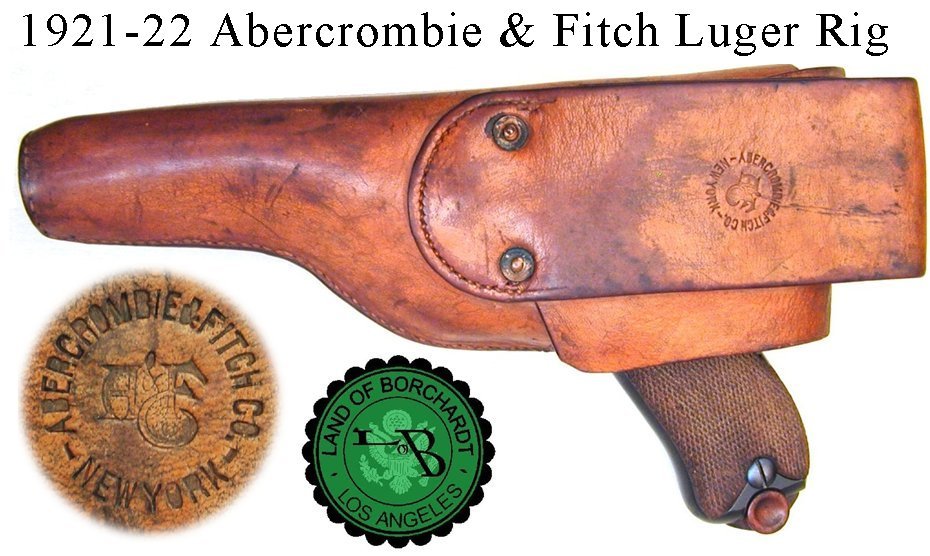
Mouse over image to see back side of LOB 1921-22 Abercrombie & Fitch Luger rig and click to see side view.
The holster is also a cover flap holster, although not full, being narrower at the top, but with a holster body brass stud and cover flap slit style closure. The A&F circular logo is deeply and evenly stamped on the rear belt loop showing all details of the design. The cover flap is narrower, as mentioned, covering the top rear of the gun, but leaving the Luger grip handle exposed. The rather large six inch long x 2½ inch wide belt loop, doubled over at the top, with the back side being of equal length, tapered at the lower end with both sides of the belt loop secured at the lower end, terminating in a semi-circle cut to the holster rear by stitching and two copper rivets and washers with three concealed additional reinforcing, flush-mount copper washers, through three layers, consisting of the holster backing, the holster cover flap back side and the belt loop. The holster body toe is closed with a leather plug with a drain hole. The cover flap slit for the holster body brass stud is not actually a slit in the leather, but more like a slot, specifically cut in the shape of a key hole. This method served well over the life of this holster with no degradation to the cover flap slot, in time, being opened and closed many times. The long term use of the holster for a Luger, of which a 4¾ inch barrel Luger fits snugly, is also verified by two impressions of a fluted grasping surface of the Thumb Safety lever in the holster body, in the Safe and Fire position.
A&F Holster variation 6

The variation 6 Abercrombie & Fitch belt loop holster is a curious, two flap holster design, most likely custom ordered. The probable purpose of the two flaps is the top cover, being the conventional method for insertion and withdrawal of the pistol, whereas the side-flap is for a speedy withdrawal of the weapon for immediate action. The holster has definitely been used but there are no internal impressions, leaving no clue as to what pistol or, possible accessory, was holstered.
A recent discovery of a similar Heiser style No. 139 holster is not for a pistol but is, in fact a leather case, rather than a holster for a Lyman All American 2½ X with Griffon & Howe QD double lever mount on scope, made to hold scope. There is another similar Heiser Zeiss Zeilklein scope case, style No.140, listed in a Heiser catalog, No. 23, page 44.
The variation 6 A&F holster or case is well constructed with heavy Russet leather and has two A&F logo, variation 2 snap fasteners, similar to the first variation 1 snap fasteners pictured on A&F logo leather stamped holsters in the 1909 A&F catalog. However the holster does not have the expected A&F leather stamped logo, nor any marks whatsoever on the holster. The holster rear has a 51 mm x 108 mm belt loop, folded over at the top, secured by two flush mount copper rivets and at the lower end also by copper rivets and washers.
The A&F holster/case is also quite sturdy with a nominal leather thickness of 0.2" (6mm) and weighing in at a hefty 13.2 ounces. Also attached to the holster rear with two lines of parallel stitching, is what appears to be a reinforcing strip of leather, 30 mm wide x 224 mm long that extends from the holster body toe to the top end of the holster. It goes under the belt loop and terminates just under the folded-over upper belt loop edge. This extra strip of leather makes for a very rigid holster body.
The holster/case dimensions are 10¾ inch x 4 inch. The length of holster body cavity from the toe to the entrance lip is 10¼". The holster could have been made for a large caliber revolver based on the holster toe leather plug dimensions of 1½ inches x 2 inches. However, it is difficult to envision what model pistol would fit, based on the small opening clearance for the exposed grip with both flaps closed and snapped shut. In addition, the straight line holster body entrance lip, with the top cover flap closed, extends to the top, acting like a partition, narrowing the opening even more. Even with no holstered weapon or accessory, it is difficult to snap the top cover and side-flap closed.
The most interesting feature of this holster is the A&F logo snap fastener, which is of a second A&F snap fastener logo design, albeit with minor changes, and with a different supplier or manufacturer, “CARR’S PAT.” The first design snap fastener and logo appearing, for the first time on A&F holsters pictured in the 1909 A&F sales catalog, was supplied and manufactured for A&F by U.S.F. or United States Fastener company. The second variation logo design is similar to the earlier circa 1909 with minor letter character size and placement differences with the most significant difference being a raised outer diameter outer edge ridge or border, lacking in the 1909 first variation. Also the second variation has a different style fastener attachment method.


A&F holster leather maker suppliers
As mentioned in the background information at the beginning of this article that as of 1973, published in a Guns and Ammo mini manual, stated that there were two known A&F holster suppliers, H. Heiser of Denver, Colorado and K-Leather Products, Inc., New York. As it turns out there are actually several leather makers that sport the A&F Co trademark logo. Ironically, with the most recognized A&F holsters discussed and pictured herein, only two holster makers, possibly three are identified, Audley, Heiser, Lawrence and, while the identity of the other, possibly several holster makers, remains a mystery.
Even with the rather straight forward association of the H.H. Heiser Holster Company with Abercrombie & Fitch there still exists holster maker identity issues, such as a variation 3 A&F trademark logo stamped Heiser holster model or style 435 pictured in a 2010 publication entitled Pistole Parabellum by Görtz/Sturgess. The accompanying Sturgess description for the Heiser Model or style 435 states basically that the identity of manufacturer is confirmed by the Heiser HHH logo stamped rivets securing the belt loop and the Heiser associated stamped model or style number 435, which, in this case is true.
However, pictured in this article is another A&F trademark logo stamped holster, identical in style, shape and stitching pattern to the above discussed style 435, except without the belt loop Heiser rivets and with a different model number style 935 that is essentially identical to 435. Both the 935 and 435 A&F trademark logo stamped belt loops are pictured side-by-side for comparison.
| |
The Heiser style numbers 435 and 935 for automatic pistols could be ordered in SMALL, MEDIUM, and LARGE.
Pictured are the 435 and 935 medium size A&F logo stamped holsters, made for the 4¾ inch barrel Luger, and the Heiser catalog representative large size 435 example holster.
Click on the 435 and 935 holsters to flip holster image.
|
|
Close section.
It is interesting to note that the style 935 holster has Luger hand written, deeply impressed on the belt loop, which is found on other Heiser made holsters, some in ink. Two example Heiser holsters are the Heiser holster model 420 for the 4¾ inch barrel Luger and the Heiser 435-4 stamped holster for a 4 inch barrel Luger4. Since all Heiser holsters identified to date are purportedly recognizable by the stamped three and four-digit Heiser catalog style number, with or without the HHH trademark rivets, could mean both holsters were made by Heiser but does not explain why, two essentially identical Heiser holsters, would have different style numbers. As stated earlier the theory is that a Heiser holster made for Abercrombie & Fitch, Heiser merely substituted the leather stamped Heiser trademark logo with the A&F trademark logo but kept the Heiser style number, with obvious exceptions.
This theory of style numbers is not valid in all cases as there exists two Heiser holsters for Lugers with the same 435 number stamped on the rear side belt loop, one on the above discussed A&F trademark logo stamped holster, made by Heiser for a 4¾ inch barrel Luger, based on the HHH logo stamped Heiser rivets, and the other on a Heiser holster made for a 4 inch barrel Luger, except with a Heiser trademark logo. Pictured in a 1920s Heiser catalog is the 435 identified holster with a below caption description stating it come in three sizes, small, medium and large. The catalog pictured No. 435 holster, apparently, represents the large size and does basically resemble the 435 holster, front and rear views, pictured herein4, with the same style holster body, cover flap and brown enamel painted cover flap Heiser • Denver stamped snap fastener. To confuse matters further, there are yet other Heiser holsters sporting the “style” No. 435, and not all Heiser made holsters that use rivets, as part of their construction, are stamped with the HHH logo.
Heiser model “No. 125” A&F logo stamped holster is an interesting variation, obviously being ordered through an Abercrombie & Fitch retail store outlet, suggesting that many other guns were sold through A&F or at least A&F customers could order a holster for any pistol or revolver they owned, and not necessarily purchased from A&F. Interestingly, the Herman H. Heiser Saddlery Company advertised this particular holster, identified in their 1920s catalog, described on page 24, curiously as “Half Breed Spring Shoulder Holster” No. 125, in this case substituting the Heiser logo with an A&F logo, yet keeping the Heiser holster model identification “No. 125”. Also the last line in the ad states: "Made to fit any revolver as well as every pattern of automatic, perfectly", which could be interpreted to mean “one size fits all.” Actually the last line should read: The model No. 125 is made in several shapes and sizes to fit any revolver as well as every pattern of automatic, perfectly, because as of this writing, there are at least, two different shapes or styles of this holster that sport the No. 125 A&F logo, and another A&F logo shoulder holster with an identification No. of 1774 – MP 4 (Military and Police) not pictured or listed in the catalog. There may be more holsters, like one for the Luger, as the Heiser catalog ad for the No. 125 states “for any automatic.”
- Audley Safety Holster Company.
| |
There is one example of an Audley holster stamped with the variation 3 A&F logo. This one example is very telling as it suggests that not all holsters with an A&F trademark logo were specifically custom ordered/made for A&F. As the Audley holster is a very well-known holster safety design, independently offered with patented Oct 13, 1914 trademark logo, the fact that it has an A&F logo means that it was an A&F retailer stock item sold through one of the several period A&F retail outlet stores with the added A&F trademark logo.
With the death of Frank Audley in 1916, the company was sold to Folsom with a subsequent change to the Audley safety holster trademark logo with the addition of Folsom’s Audley patented Oct 13, 1914 trademark logo. This dates the A&F logo on the Audley holster to no later than 1916 to no earlier than 1911, when prior to seeking patent protection the Audley logo on this particular style holster was Audley Safety Holster Company. The holster was additionally advertised in a Hans Tauscher sales catalog, circa 1911 with text description of (AUDLEY) Patent applied for.
The H and D Folsom/Audley Luger holster style No. A45 is pictured on page 89 of a 1920s H and D Folsom Arms Catalogue No. 13. Also pictured in the catalog on page 90, as style No. A501 is a Folsom’s Audley Safety holster for another popular pistol, the Colt Automatic, 45 Caliber Government Model commercial. Pictured is an original Colt Automatic, 45 Caliber Government Model commercial holster with the original leg strap, advertised in the catalog as style No. A500.
| |
|
Close section.
|
- Herman H. Heiser, Denver, Colorado.
| |
1958 Heiser-Keyston holster catalog
| CATALOG • 23 • | CATALOG • 30 • | CATALOG • 32 • |
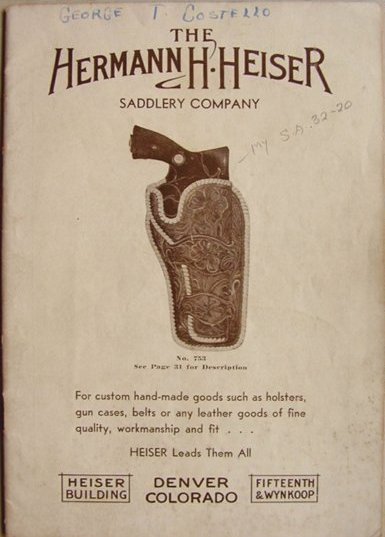 | 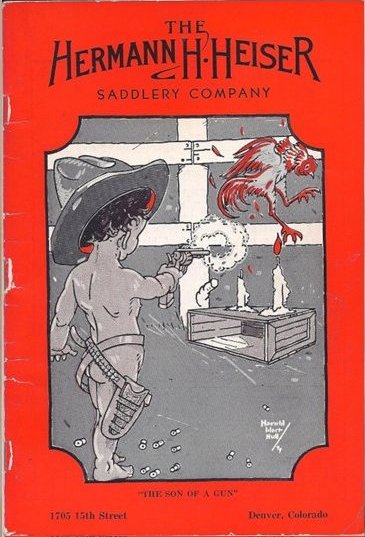 | 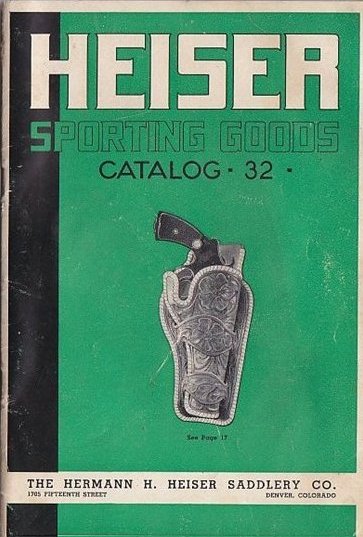 |
Shown above are several period, original Heiser catalogs that were used to explain and describe the Heiser holsters in this article.
Pictured here is a 1958 Heiser-Keyston holster catalog, No. 52 • which is not particularly rare or expensive when located, but also, conversely being 53 years old, not readily available either. The catalog was definitely published in the 1950s; with the specific 1958 date attributed to the dates in the cover page original “Heiser-Denver” logo, which appear to be 1958 – 1858 which, if correct, represents the centennial issue of the catalog and the company. The circular logo on the cover represents the original company and location and the circular logo on the rear of the 1958 catalog reflects the new company owners, and location. The 1960 H-K-L catalog logo indicates the company was established in 1868 which is contradictory to the 1920s Heiser catalog No. 23, page 49 titled HISTORICAL, first paragraph statement of 1858. The 1958 catalog shows a picture of a revolver and an automatic pistol, describing how to measure a barrel length, automatic or revolver, when ordering a holster, interestingly, using a Luger as an example of an automatic.
The 1958 catalog features three Luger pistol holster style numbers. Two of the styles, No. 420 closed toe, and No. 423 open toe on page 6 indicate that these two Heiser holster styles have been offered since the 1920s to at least 1958, a period of sixty years, through two owners of the company, being pictured and described on pages 12 and 13 in the 1920s Heiser Saddlery Company catalog No. 23. The third style, No. 415 in the 1958 catalog on page 4 is also identified as a Luger style. However, the one pictured is for a revolver and there is no corresponding No. 415 style in the 1920s Heiser Saddlery Company catalog No. 23 or the 1937-38 Heiser “THE SON OF A GUN” catalog No. 30 or the Heiser Sporting Goods catalog No. 32.
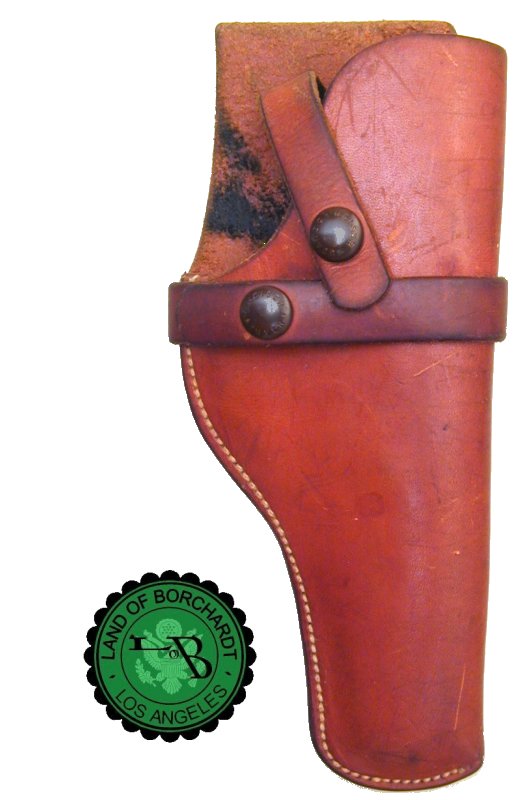 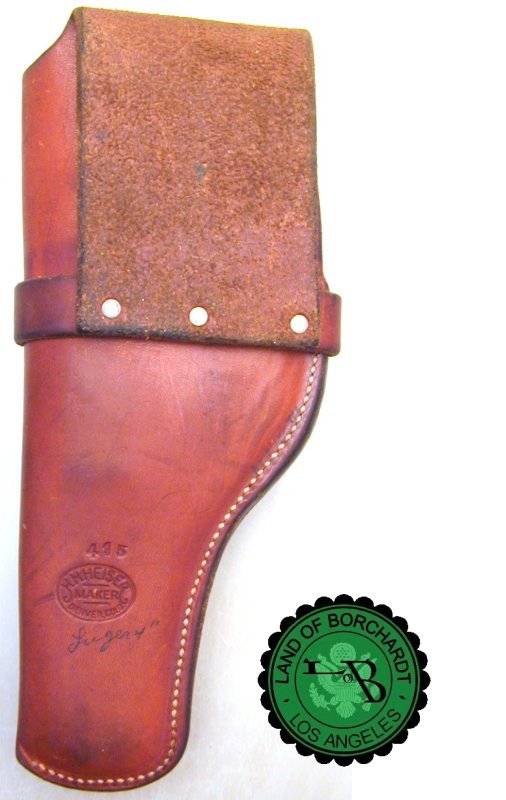
Click to view other images of the holster.
A Heiser style No. 415 holster, shown above, has been identified as being made specifically for a Luger as Luger 4” being hand written on the holster rear, under the belt loop and Heiser oval logo, using a blue ballpoint pen. Based on the H.H. Heiser – Denver logo in oval cartouche, the holster was made 1955 or earlier.1 The subject Heister-Keyston catalog publication date would also have to be pushed back from 1958 to 1955 or earlier or Keyston was selling off existing stock acquired from the acquisition of Heiser. The holster has two excellent condition snap fasteners made by •DOT•. Also, in conjunction with the 1958 Heiser catalog style No. 415 listing, this indicates a circa 1950s Heiser made holster. The style of the 415 holster does not look like the No. 415 holster pictured in the 1958 catalog which, is for a revolver, but does have the basic holster body style with the commonality of two straps with two brown enamel, HEISER - DENVER embossed snap fasteners. The Luger 4” marking, though, does agree with the 1958 holster listing for the Luger, pretty much associating the pictured holster with the subject Heiser-Keyston catalog.
The identity of the •DOT• made snap fastener for the Heiser style No. 415 holster, makes two identified Heiser snap fastener suppliers, DOT and UNITED CARR for the same, dimensionally identical, brown enamel • HEISER • DENVER • embossed strap snap fastener covers on 415 and 435-4, but using a United Carr snap fastener assembly on Heiser holster style 435-4 full flap holster for a 4-inch barrel commercial Luger. Coincidently, this fastener company has been found on an A&F logo embrossed snap fastener. It is possible that the snap fastener supplier changed when Heiser was bought by Keyston. To further isolate the 415 holster manufacturing time frame is that the Heiser Denver brown enamel embossed snap cover style has been identified to have been used by Heiser from the 1930s through the 1950s, which in turn makes both the Heiser style numbers 435-4 and the 415 Luger holsters made in the same time frame.2
CATALOG • 19 • CATALOG • 30 •
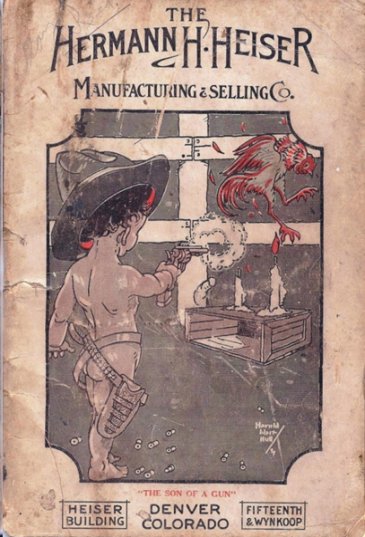

Click on image to view back side of catalog, then run mouse over image to go back to front cover.
Circa 1921 Heiser holster catalog No. 19 with 64 numbered pages. The catalog is in fair condition with all pages, some separated. Apparently, this is the 1st "Son of a Gun" catalog, except the rear cover kid, dressed up as a cowboy, is pictured in flesh tones; while the overall front cover and rear cover has hints of red. Interestingly, the rear cover shows a poster with a Bill Hart caption. Bill Hart was a 1920s period, silent movie cowboy star. The circa 1937, completely red colored front and rear cover "Son of a Gun" catalog has the same rear cover poster of Bill Hart, except without a caption, as by 1937 Bill Hart had faded into memory.
| |
|
Close section.
|
- Example 1, Heiser No. 419
- Example 2, Heiser No. 420
- Example 3, Heiser No. 421
| |
Heiser Holster No. 421 for a 6-inch barrel Luger
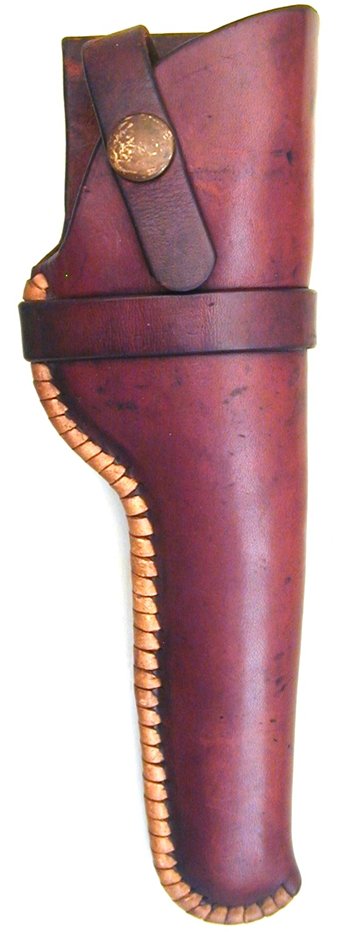 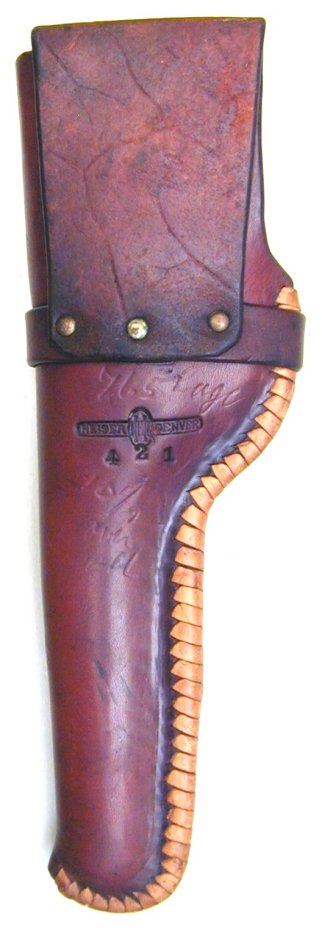
Pictured above is a rare H.H. Heiser holster No. 421, with a plain brass U.S.F. snap fastener assembly, made for a 6-inch barrel Luger with unusual hand written information on the backside, under the belt loop: 765 Luger 10½ overall meaning: for 7.65 mm Luger, holster length 10½ inches overall, which is the approximate length for a Luger with a 6-inch or 150mm, 7.65 mm or Cal 9mm barrel and was made in 1925 or earlier based on the triple-H Heiser logo.8 The hand writing was, no doubt, done by Heiser personnel, at manufacture, to identify this specific holster as made for a 6-inch barrel Luger. There are several Heiser holster examples with similar markings as apparently the style number was not sufficient identification, by itself, only representing a general Heiser style for pistols and revolvers, in this case an open top, closed toe holster. The “765” mark is not understood by Bender, as in Luger Holsters and Their Accessories9 on page 537 pictures a similar style 422 open toe Heiser Luger holster with a similar marking of 765 Luger 5” with a caption comment stating: The meaning of the three digit number above is not known. The Luger 5” is “Heiser-Speak” for a Luger pistol with a 4¾ inch barrel, and in this particular case, a 4¾ inch barrel is generally synonymous with 30 Cal or 7.65mm, therefore the 765 marking. There are Heiser made Luger holsters marked Luger 6”, also meaning for a 6-inch barrel.
The source of the “765 Luger” mark, used by Heiser becomes clearer or more apparent, when studying the Heiser catalog No. 23, page 3 “schedule” descriptions of holster categories of: LARGE, MEDIUM, and SMALL. The subject 421 style holster is categorized as LARGE “With 5½ inch to 7½ inch barrels” and 765 Luger or 9 M. M. Luger. It is especially significant that the catalog 765 Luger designation is the probable source for the holster marking, being a 3-digit consecutive number, also as on the holsters, lacking the delineating decimal point after the seven in (7) 65, i.e. 7.65. The 421 style holster is listed and further defined as for an automatic pistol, i.e. Luger on page 12 of the catalog with the general statement: Heiser’s Safety Strap Belt Holsters for Automatics Only and an additional reinforcing statement at the bottom of the page stating Holsters on this page are not made for revolvers. The 765 Luger marking appears to be deliberate, as Heiser could have marked the style 421 holster, or other Heiser style holsters 9 M. M. Luger, as the No.23 catalog also has a 9mm Luger holster designation.
The Heiser holster No. 421 with the 765 Luger 10½ inches overall marking and not simply marked as ”Luger 6” is found on other Heiser made Luger holsters is curious as the holster being 10½ inches long, being the approximate length of a Luger with a 6-inch barrel, does indeed fit a 6-inch barrel Luger perfectly, which, is in this case a model 1906 BUG proofed commercial grip safety navy Luger. A standard 4¾ inch barrel grip safety Luger also fits snugly, with room to spare in the holster body for a longer barrel, but significantly, with a 4¾ inch barrel, 30 Cal Luger inserted there is room or space at the holster entrance, above the integral, fixed rear link to accommodate the higher height of a 100-200 meter adjustable rear link sight of a navy Luger with a 6-inch barrel. Since the Heiser No. 421 holster body is of a very rigid, unyielding form, one can conclude that the holster cavity was specifically shaped to hold a 6-inch barrel navy Luger with a 100-200 meter adjustable rear link sight, based on the 765 Luger holster marking, a 30 Cal or 7.65mm commercial navy Luger. Pictured below is the subject Heiser Holster No. 421 with a rare 4-digit 7960 BUG proofed navy commercial Luger.
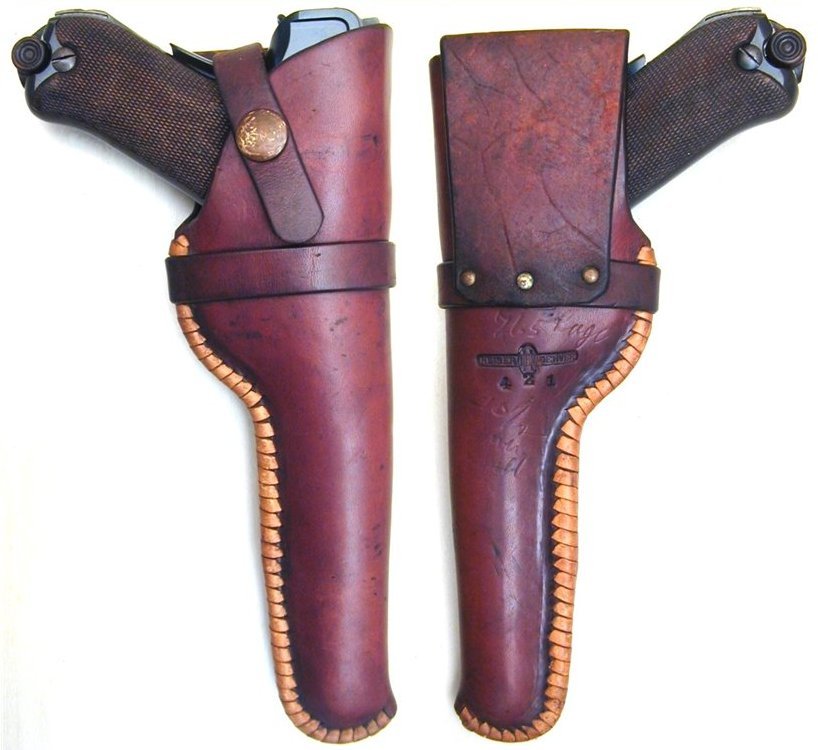
Also pictured is a file copy of another open top, closed toe Heiser No. 421 holster, except with an A&F circular logo. Also on the rear side, under the belt loop, is hand written, by pencil, pen, or stylus: Luger 6.
Note: When stating marked with a pen, the reference is not to a modern “ballpoint” pen or a fountain pen, but a very early version of the ballpoint pen as the ballpoint pen was not successfully marketed until WWII and any such Heiser marked holster so identified to be marked with a ballpoint ink pen is, post manufacture marked or at a minimum, the holster is of post WWII manufacture, a possible example being Heiser style holster 435-4. The most likely or probable device used to make the ink-less, hand applied Heiser holster markings (actually impressions in the leather) was invented by John Loud: The first patent on a ballpoint pen was issued on 30 October 1888, to John Loud a leather tanner, who was attempting to make a writing instrument that would be able to write on his leather products, which then-common fountain pens could not do. Loud's pen had a small rotating steel ball, held in place by a socket. Although it could be used to mark rough surfaces such as leather, as Loud intended, it proved to be too coarse for letter writing and was not commercially exploited.Wikipedia
The poorly marked Heiser holsters, although genuine and legitimate, are examples of the Loud or similar marking tool.
| |
|
Close section.
|
- Example 4, Heiser No. 422
| |
Heiser Holster No. 422 for 4 inch barrel Luger
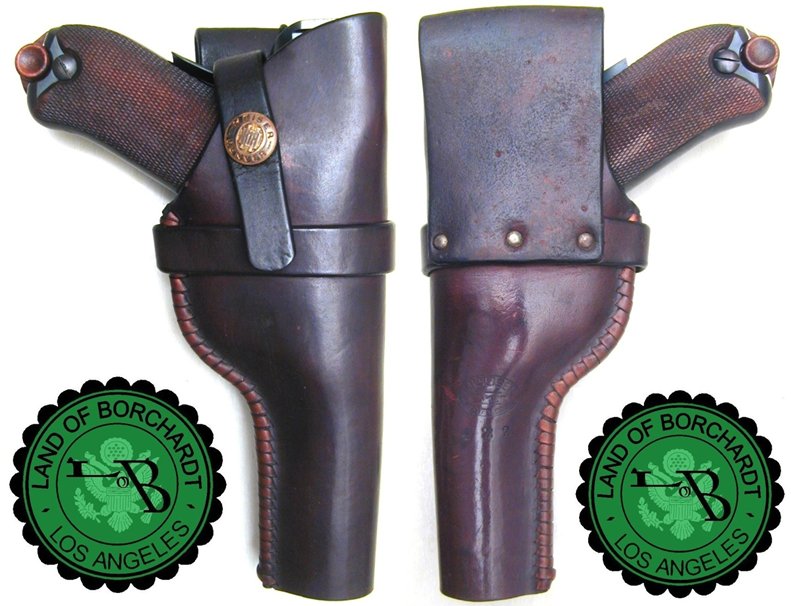
Click on image to see a comparison between the two 422 holster variations.
Pictured here are two Luger holster variations of the Heiser style No.422.
The first, shown above, is a Heiser style No. 422 open top, open toe holster made specifically for a four inch barrel Luger. Since the holster is an open toe design, a 4¾ inch barrel also fits snugly, with the muzzle face flush to the open toe exit. The holster is in excellent condition with a high luster, dark brown appearance. The holster is a molded holster, with Hand Thong Wrap Stitched Edge as defined by the Heiser catalogs, the holster being very rigid and unyielding, made with very thick leather, with a wall thickness measuring 4 mm typical, at the toe exit. The stiffness and unyielding characteristics of the leather could account for the very light, but sharp stamping of the holster rear located oval logo and the 422 style number stamping. The strap attached brass/steel combination convex surface brass snap button fastener has the embossed triple H center design logo with HEISER DENVER stamped around the circumference. The snap fastener assembly was made by the U.S. Fastener Company with the holster body fastener portion of the assembly being made of brass.
The holster is pictured in several Heiser catalogs, including catalog No. 20 on page 17, catalog No. 23 on page 13 and catalog No. 30, also on page 13, with both No. 23 and No.30 catalogs using a generic description and the earliest numbered catalog, Heiser catalog No.20, page 17, curiously, actually identifying the holster as for a Luger.
The second holster style No.422 is shown below and is for an 8 inch barrel Artillery Luger, a very scarce Heiser Luger holster. The holster dimensions are 13 inches long by 3½ inches wide. The open top, strap snap button fastener, open toe holster is made with fine russet leather with a dark chestnut brown appearance with a nominal thickness of 4 mm measured at the holster body toe exit. The all steel snap fastener button assembly is a very early style with no maker marks and the plain, shallow convex surface button is of an unusually small 13 mm diameter, basically flush to the strap surface with an assembled thickness of 5 mm vs. the 4 inch barrel style No. 422, featured herein, with a brass Heiser triple H HEISER•••DENVER embossed logo strap snap fastener, made by the U.S. Fastener Company with a 19 mm diameter and an assembled thickness of 7 mm. On the holster rear under the belt loop is a very light, barely visible hand scribed Luger 8 and under that, is a very deeply stamped Heiser triple H bar logo. The holster also has Hand Thong Wrap Stitched Edge as defined by the Heiser catalogs.
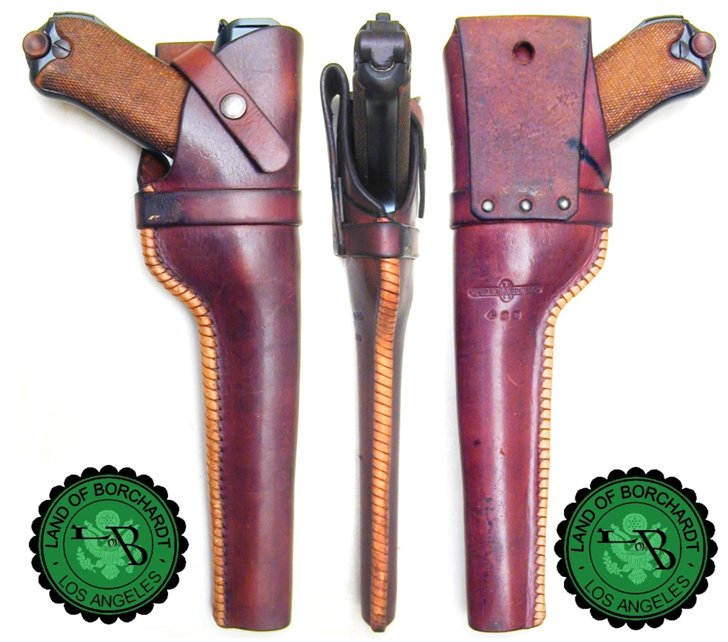
Click on image to see a comparison between the two 422 holster variations.
There is one other known and published Heiser Artillery Luger holster pictured in Luger Holsters and Their Accessories by E. Bender on page 571. The Bender pictured holster is equally rare, being Heiser style No. 435 full cover flap, closed toe variation.
| |
|
Close section.
|
- Example 5, Heiser No. 428
| |
Heiser Holster No. 428
| 4 inch | 4¾ inch |
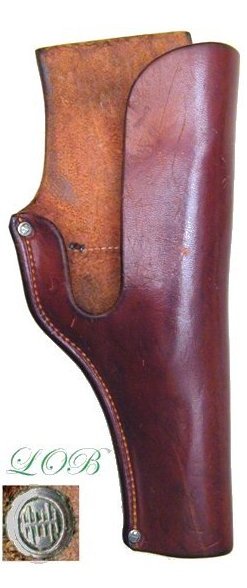
|
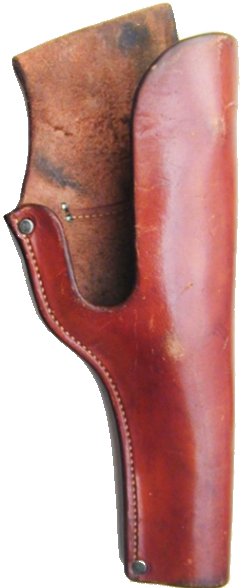
|
|
Click on image to see the back side of the holster then click here to see front.
|
Pictured above are two extremely rare, open top and holster body toe, circa 1920s Abercrombie & Fitch circular logo stamped, Heiser made holsters. Both holsters are stamped with the Heiser style number 428 and are assembled using a combination of stitching and triple H logo stamped Heiser rivets and stamped with the variation 3 circular A&F logo. The first example holster, shown on the left above, is for a 4 inch 30 Cal or 9 m/m barrel Luger and the second example, shown on the right above, of the same Heiser stamped 428 style number and additionally marked on the holster rear, under the belt loop is 765 Luger added by Heiser at manufacture, is for a 4¾ inch barrel Luger, 30 Cal or 9 m/m.
9 m/m is mentioned, in as much as the second Heiser A&F 428 style holster example, a 4¾ inch barrel Luger holster, also being made in the 1920s, despite the back side marking of 765 Luger, could have been ordered for the 9 m/m variation of the special 1921 – 1922 Abercrombie & Fitch Swiss chamber crested Lugers with A&F, one and two-lined roll die stamped barrels, being the only immediate post World War One special imported 4¾ inch barrel Lugers offered for sale by A&F exclusivey, through their retail stores only, and not through their catalogs, albeit only 100 total, 51 in 30 Cal and 49 in 9 m/m.
To give an example of the rarity of these two holsters is that the first variation is the identical holster pictured on page 537 in Luger Holsters and Accessories of the 20th Century by E. Bender in 199210, acquired for the collection in 1997, of which, no other identical example, either ordered from Heiser through A&F catalogs, bearing the A&F logo, or ordered directly from a Heiser catalog, with only the 428 style number and Heiser logo stamping, has been identified or published as of 2011, nineteen years later. The second A&F variation for a 4¾ inch barrel Luger shown just below has never been identified or published until this article.
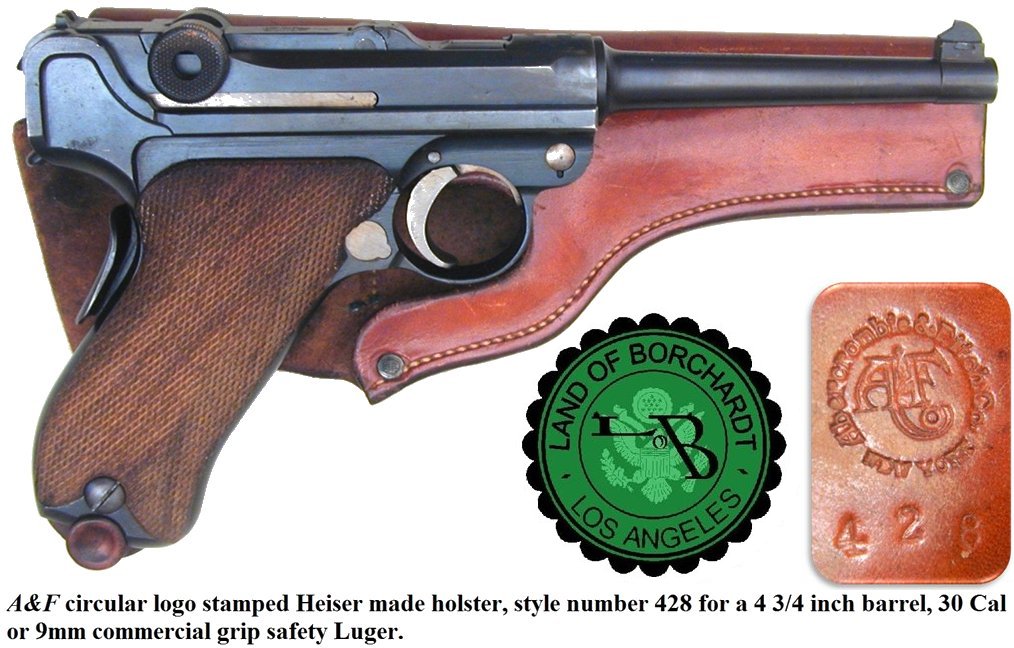
Ironically, it is the 4 inch Luger barrel variation pictured below which could be considered the more commonly special ordered holster, as literally thousands of 4 inch barrel Lugers or shorter, were imported in the 1920s whereas, as mentioned above, the demand for a holster for a 4¾ inch barrel Luger in the 1920s, with 1914 being the last pre-war commercial Lugers of any caliber or barrel length being exported by DWM to the United States, was extremely limited. In addition, an A&F or Heiser catalog customer with a 4, 4¾, 6, 8 inch barrel Luger, could custom order a Luger holster, expecially the Heiser customer, from an extensive selection of Heiser holster styles for automatics in the 1920s and 1930s Heiser catalogs, examples being Heiser style numbers 415, 420, 421, 422, 428, 435, 935 and many others, some featured in this article. As such, any one of a multitude of Heiser holster styles could be ordered for the very small number of 1921 – 1922 A&F, Swiss crested, imported 4¾ inch Hammerli installed barrel Lugers.
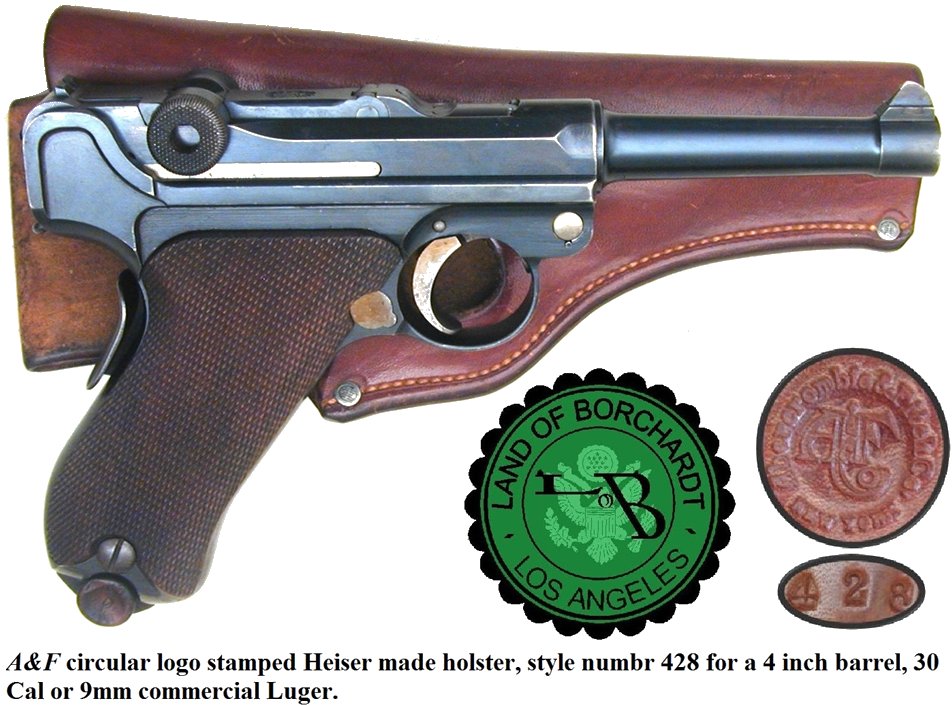
Incidently, although the Heiser, no safety strap and snap fastener, open top, style number 428, was prominently advertised in the Heiser catalogs, as to how the two subject A&F circular logo stamped holsters were ordered directly through an A&F catalog or through an A&F retail store is unknown, as the Heiser 428 style holster is not listed or pictured in any of the known 1920s A&F catalogs, not even the extensive 1930 A&F catalog, which features several Heiser holsters for Lugers, such as safety strap and snap fastener style numbers 419, 420 and 423.
| |
|
Close section.
|
- Example 6, Heiser No. 435-4
| |
Heiser Holster No. 435-4
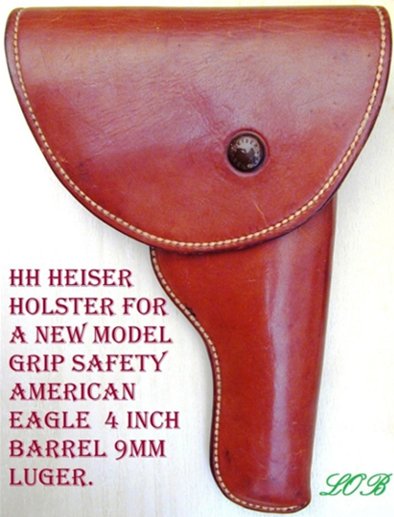 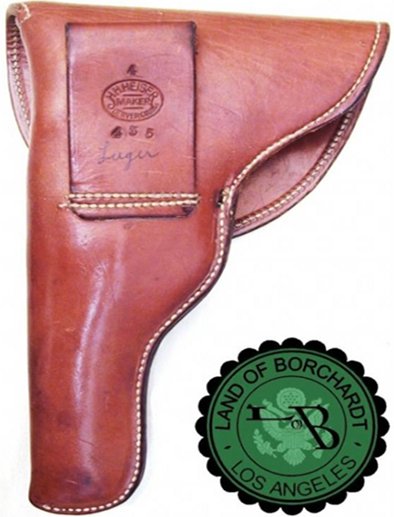
Pictured above is a pristine, barely used example of a Heiser No. 435-4 holster for a 4-inch 30 Cal or 9mm barrel Luger. The holster belt loop is stamped with the Heiser Logo and No. 435-4 and additionally is hand written Luger using a ballpoint ink pen (see Note below), suggesting the holster is of post WWII manufacture. Also in support of a later manufacture is the use of a different, simpler baked enamel type of Heiser style logo snap fastener, made by United Carr vs. the earlier more recognized Heiser embossed brass and black snap fastener, triple-H style logo, made by U.S.F. or the United States Fastener Company. The holster itself, is very well-made using a continuous piece, dual layer of leather, stitched together, with the inside cover flap and holster body interior surface identical to the outside.
The holster also has an interesting history, first being advertised by a well-known retailer, several years ago, at an apparently unrealistic high price as it subsequently reappeared several months later with a different inventory number, at a more moderate price listing and was subsequently acquired for the LOB collection. The identical holster is also pictured in a recent publication titled Pistole Parabellum, attributed to the retailer, with a text caption stating the holster is: ...from the middle period of production. The (exclusive) use of the oval Heiser logo suggested by Sturgess as: from the middle (Heiser) period of production is difficult to substantiate as a 1920s catalog on page one pictures and describes two different style of logos with the Heiser No. 435-4 holster logo pictured, stating: To get the Genuine, INSIST upon seeing either this.
Pictured here is another Heiser No. 435 style Luger holster, variation 2, without the “4” in the 435-4 designation. The holster has been post manufacture, crudely, but creatively modified from a full cover flap, originally similar to the variation 2 full cover flap holster, to an open top with a single strap and snap fastener. The conversion was done by cutting back the cover flap, except for a center strip of leather, used for the strap, keeping the original, no Heiser logo, plain surface, baked enamel brown color snap fastener. The unusual Heiser style No. 435 holster modification was done many years ago, based on the fading characteristics under the strap and surrounding holster body. The holster body style is identical to the subject full flap No. 435-4 style Heiser holster, except that it is not lined, making it a different No. 435 Heiser Luger holster variation. It is also marked on the back, below the belt loop, “3 5/8” using an earlier type leather marking tool with the 3 5/8 number meaning 3.625 inches or 93 mm, which is the shortest length, 30 Cal barrel made for the 1920s P.08 commercial Luger as pictured and advertised in an original 1922 dated No.26 Sloan’s Military Shop, Inc. catalog. Also note in the Sloan ad that the 9mm new model navy rig is referred to as 38 Caliber (9m/m).
This is yet another example of the many Heiser holster variations for different model pistols, revolver or automatic, under the same style No. 435. In this case, it is multiple style No. 435 variations or different special custom ordering options for the same pistol, the Luger, additionally with different Heiser added markings, Luger (variation 1) vs. 3 5/8 (variation 2).
Note: When stating marked with a pen, the reference is not to a modern “ballpoint” pen or a fountain pen, but a very early version of the ballpoint pen as the ballpoint pen was not successfully marketed until WWII and any such Heiser marked holster so identified to be marked with a ballpoint ink pen is, post manufacture marked or at a minimum, the holster is of post WWII manufacture, a possible example being Heiser style holster 435-4. The most likely or probable device used to make the ink-less, hand applied Heiser holster markings (actually impressions in the leather) was invented by John Loud: The first patent on a ballpoint pen was issued on 30 October 1888, to John Loud a leather tanner, who was attempting to make a writing instrument that would be able to write on his leather products, which then-common fountain pens could not do. Loud's pen had a small rotating steel ball, held in place by a socket. Although it could be used to mark rough surfaces such as leather, as Loud intended, it proved to be too coarse for letter writing and was not commercially exploited.Wikipedia
The poorly marked Heiser holsters, although genuine and legitimate, are examples of the Loud or similar marking tool.
| |
|
Close section.
|
- Example 7, Heiser No. 438
- Example 8, Heiser No. 531½
| |
Heiser Holster No. 531½ for a small revolver
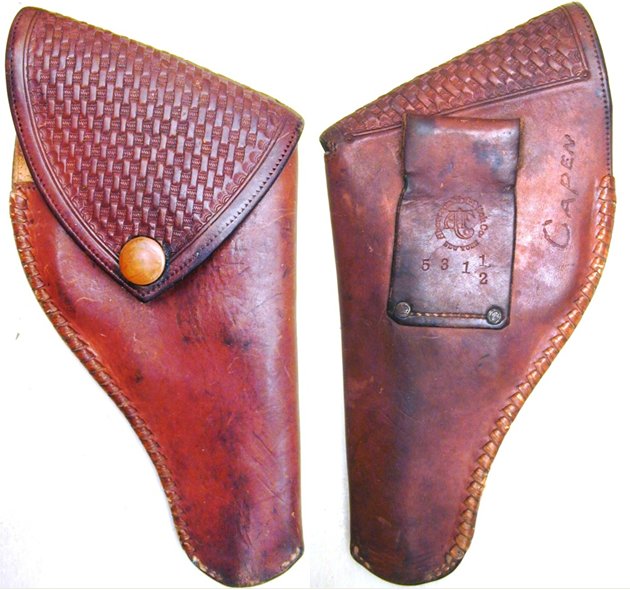
Pictured above is a Heiser style No 531½ A&F logo stamped, full cover flap holster for a small revolver. The cover flap has a plain, unmarked brown color baked enamel, U.S.F. made snap fastener, found on early made Heiser holsters. The holster, identified as Heiser made, by two triple-H marked Heiser rivets securing the belt loop. The holster interior is chamois skin lined, with some separation and water staining under the cover flap.
Although there is no Heiser catalog specific listing for the style No. 531½, there are several similar 5xx style No. listings, with and without the ½. The ½ designation indicates per Heiser catalog No.23 listing for a holster style No. 536½: Hand basket stamped flap only. The style designation 531 without the ½ would indicate: Hand basket stamped, meaning flap, and holster body. Interesting, that while the catalog text listing did have a ½ fraction font, there was not an equivalent numeric fraction holster punch, hence the vertical type application or placement of basically, the same font size numbers 1 and 2, separated by a Heiser hand-applied divider. The meaning of the CAPEN marking on the holster is not known and is too crude and unusually located to be done by Heiser, probably added by the owner.
The 1920s catalog No. 23 shows several examples of the style 5xx series holsters with varying descriptions, basically fitting the subject style no. 531½ with page 19, picturing style No. 534, most resembling 531½ and the best text statements describing 531, with and without the ½ designation, being on page 21, using examples style No. 536 and 536½.
| |
|
Close section.
|
- Example 9, Heiser No. 728
- Example 10, Heiser No. 738
- Example 11, Heiser No. 928
| |
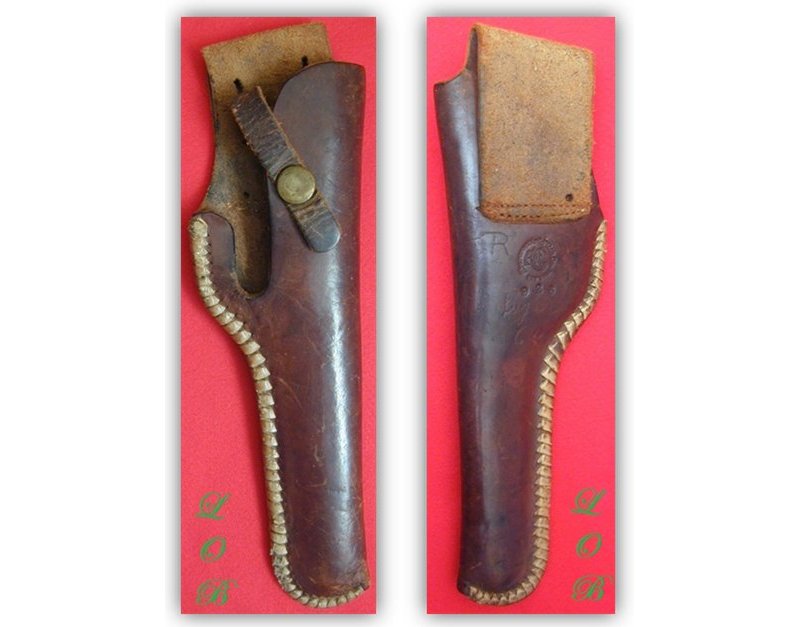
Pictured above is an Abercrombie & Fitch trademark logo stamped holster with a “style” number 928 stamped under the logo. The holster is possibly an early manufacture style, Heiser made holster. The A&F logo with the 928 number application is very similar to the Heiser number found under the (1910-1920) Triple-H Heiser/Denver trademark logo. The most interesting feature of the Heiser model 928 A&F holster is the hand written word "Luger" and 6” under the A&F logo and 928, meaning for a six inch barrel luger. This "Luger signature" is sometimes found on other Heiser holsters made specifically for a Luger. One example being 420 with the "signature" possibly added by Heiser or most likely by the retailer to identify the holster for sale as for a Luger and in this case with a five inch barrel, actually 4¾ inches or 120mm. A major Luger dealer, who has seen many of these additional descriptive, hand-written Heiser holsters, feels it was done by Heiser. It was least likely added by the holster owner. It is most certain that the owner knew at the time of purchase that the holster was for a Luger. The most interesting aspect of the 928 holster is that it was not made for a Luger as no model or barrel length of a Luger will fit. Also applied to the 928 holster rear is a large letter character R, current meaning unknown, but is possibly related to the actual pistol or revolver intended for this holster. Pictured below are other A&F trademark logo, Heiser made "Luger signature" holsters.
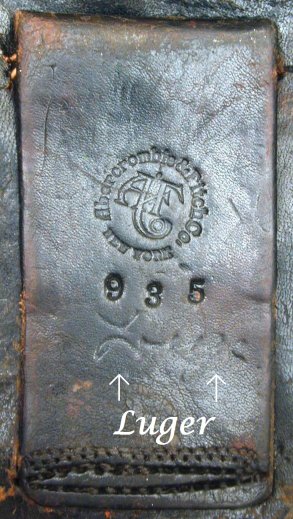
Heiser No. 935
| |
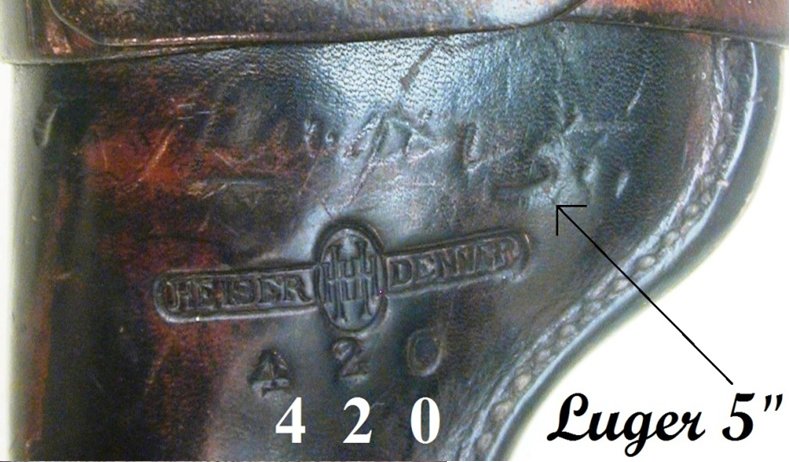
Heiser No. 420 |

Heiser No. 421
| |
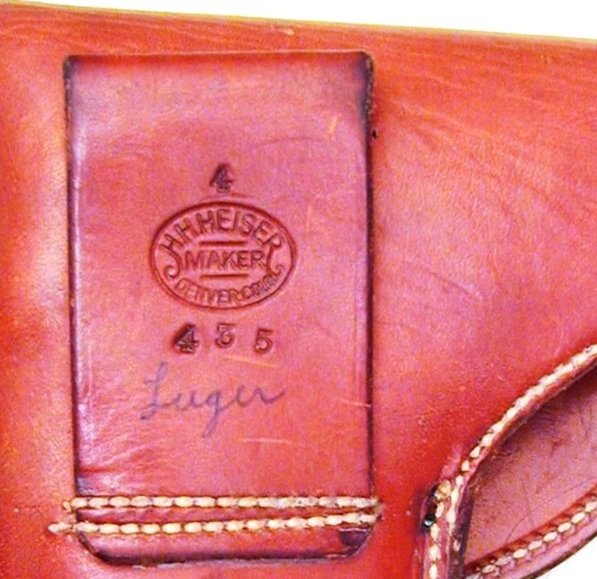
Heiser No. 435 |
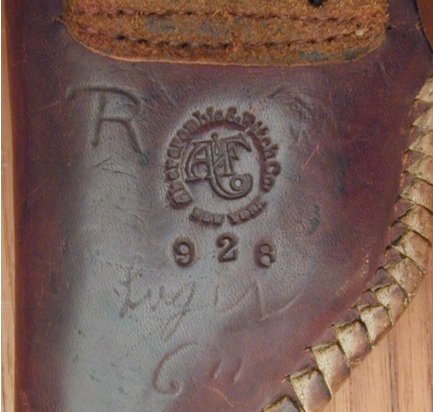
Heiser No. 928 |
| |
|
Close section.
|
- Example 12, Heiser No. 935
| |
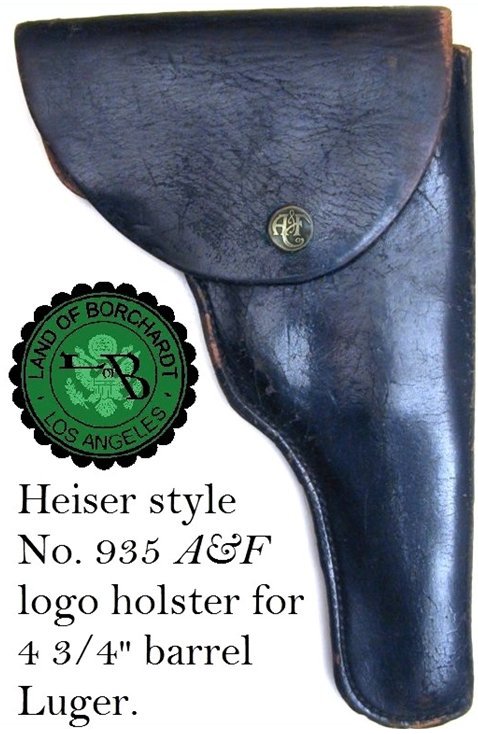
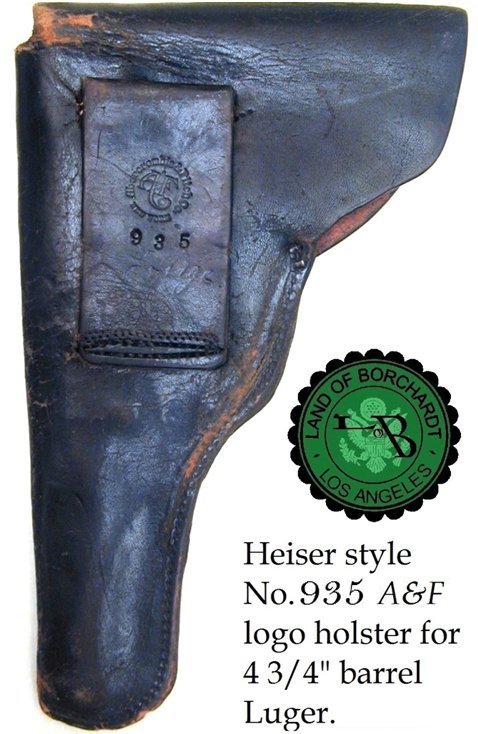
Click on images to see opened holster and mouseover to return to original picture.
Pictured above is a Heiser style No. 935 A&F logo, full cover flap, closed toe holster. This holster, dyed black by Heiser, is identified, and described in a 1920s Heiser catalog No. 23 and a 1937-8 Heiser catalog No. 30 as style No. 935. An identical holster is pictured in E. Bender’s Luger Holsters and Their Accessories on page 534, however, with only the front view and other than a general text statement of Heiser manufacture, based on the 1930 A&F catalog holster advertisement on page 168, there is no identification as to what style number, which is now known, with the identity of the subject holster to be 935, listed in several Heiser catalogs with the style No. being the ultimate identifier. As per the Heiser catalog text description, coincidently on the same page number 20 of both catalogs, the holster, in style is identical to Heiser holster style No. 435, except for the type of leather used, in this case: No. 935 – Made of medium weight leather; otherwise same as No.435. which is made of heavy Oak Tanned California skirting leather…
A Heiser style A&F logo holster No. 435 for a Luger is pictured in Pistole Parabellum by Görtz/Sturgess, volume III, page 1261, Fig. 1169. Bender claims this holster, now identified as Heiser style No. 935, as described in the 1930 A&F catalog as item No. 2F2310 is the holster used with the special 1921-22 imported Swiss crested, grip safety Lugers. This is also discussed in the 1930 A&F catalog description in the A&F catalogs section. Even though both the 435 and 935 Heiser holsters are listed in the same Heiser catalogs, it is possible that the pictured 935 style was made at a different time, based on the lack of the 3-H trademark logo stamped belt loop reinforcing rivets and the plain, left side holster seam rivet. The pictured 435 holster has the 3-H trademark logo rivets.
This the first instance of an A&F catalog featuring a holster manufacture by name, in this case Heiser, with entire sections of a Heiser catalog extracted, page for page, date and catalog number unknown, almost verbatim, to the 1930 A&F catalog, changing only the Heiser style number identity to the new A&F inventory numbering system. This suggests that A&F had a contract, at this point in time, with Heiser to supply holsters, not only for the Luger, but for all manner of revolvers and pistols offered by A&F in 1930 and earlier, including acquired VL&D gun inventory and their customer base resulting from the merger.
An attempt has been made, with the Luger holsters described and pictured in the 1930 A&F catalog, to identify or associate the new A&F assigned inventory numbers with the original Heiser equivalent style numbers. This effort was helped somewhat by the fact that Luger holsters made by Heiser for A&F have the A&F logo, along with the Heiser style number, stamped on the holsters. This applies only to Heiser/A&F Luger holsters, circa 1920 – 1940 with the later style A&F circular logo. Heiser, possibly, made Lugers holsters for A&F much earlier with an earlier pre-WW1 style logo, circular and/or oval, without a Heiser style number, and it may be that these holsters, lacking a style number, were not made by Heiser.
There are at least two Luger holster examples in this article with only the early pre-WW1 A&F circular logo and other A&F non-Luger holsters with the early oval A&F logo. It should be noted that Heiser made holsters for the Luger, sold directly through their Heiser logos and style numbers, in addition to the special Heiser/A&F logo stamped Luger holsters and probably sold more Luger holsters than A&F.
Per the 1930 A&F catalog there are at least four advertised Holsters for the Luger, all described as made of heavy Oak tanned California skirting leather, with one identified by Heiser as style No. 435 and the Bender referenced Holster, made either of; a) medium weight leather or, b) fine plain finish only, identified by Heiser as style No. 935, coincidently not mentioned in the Heiser catalog descriptions as being dyed black.
Since the 1930 A&F catalog offers a multitude of Luger holster styles for a 4¾ inch or 4 inch barrel Luger, with a combination of features, it stands to reason that they were being offered to all manner of Luger pistol owners from 1930 back to pre-WW1 days, as attested by the period A&F catalogs, and it is therefore difficult to categorically state a that a particular Luger Holster offered in this catalog was specifically made for a specific group of Lugers, in this case the 1921-22 special A&F order Swiss crested Lugers, and without a specific period bill of sale or invoice, citing both a Luger and holster, can an association ever be made.
Pictured below are pages 166 and 168 descriptions of A&F advertised Luger holster offerings and pictures of the A&F holsters together, with their Heiser style number equivalents with the A&F inventory number holsters, located on pages 167 and 169 respectively.
1930 A&F catalog, page 166

The “second” holster identified for the Luger pistol in the 1930 A&F catalog as No. F2309 is described as similar to the No. F2308, which is also made of oak tanned oiled California skirting leather, in loop style construction, except for the following: Full Mexican hand carved, thong wrapped stitched edge closed end with snap button safety strap. The corresponding Heiser style No. cannot be identified, although it could be Heiser style No. 735, which is not pictured, but is in the same grouping as Heiser style Nos. 435 and 935. Both Heiser Luger holster offerings, possibly three, in the 1930 A&F catalog could be ordered for a 4¾ or 4 inch 30 Cal or 9mm Luger.
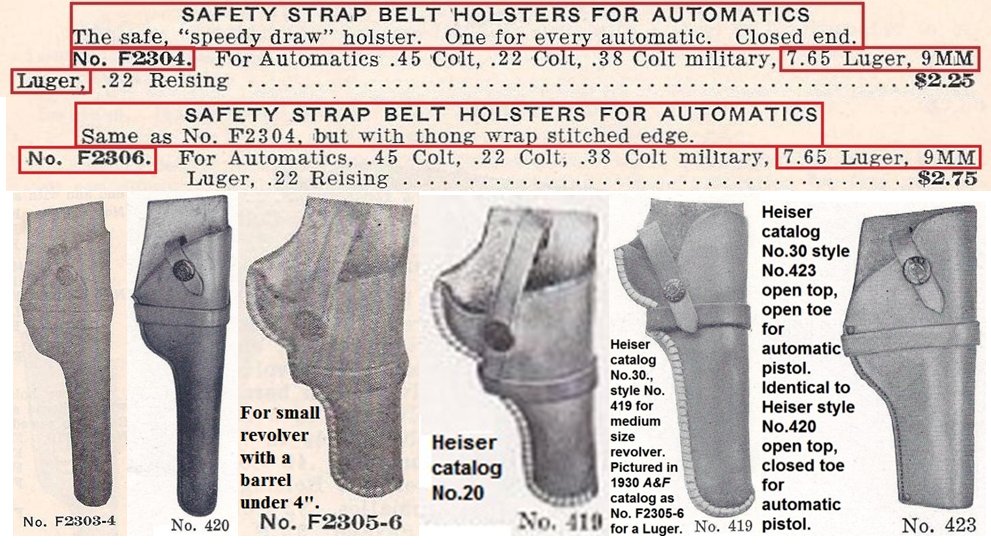
1930 A&F catalog, page 168
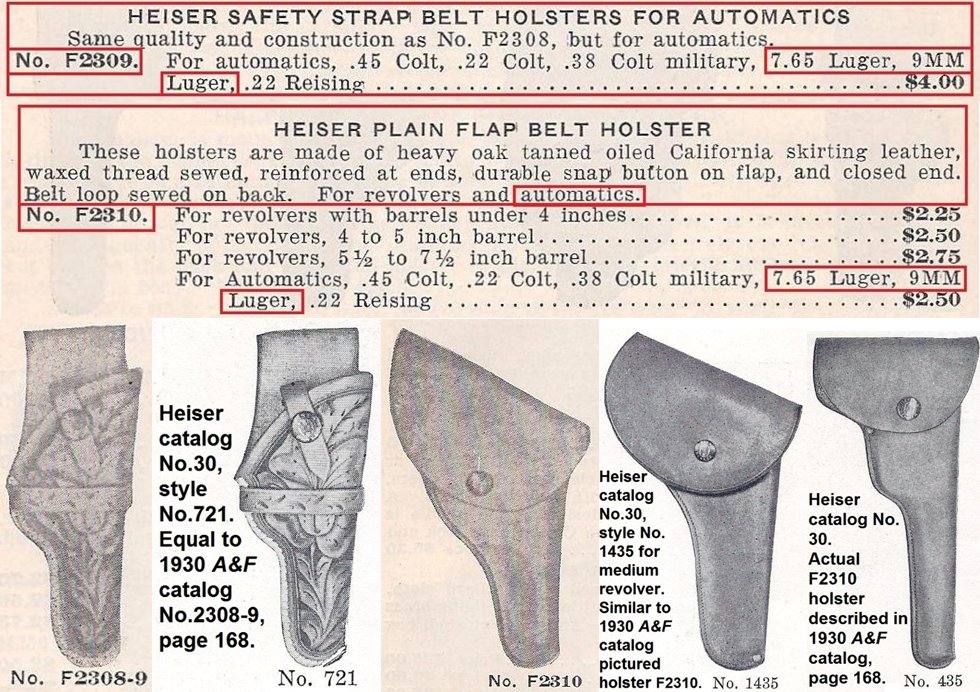
Heiser style number 935 holster - variation 2
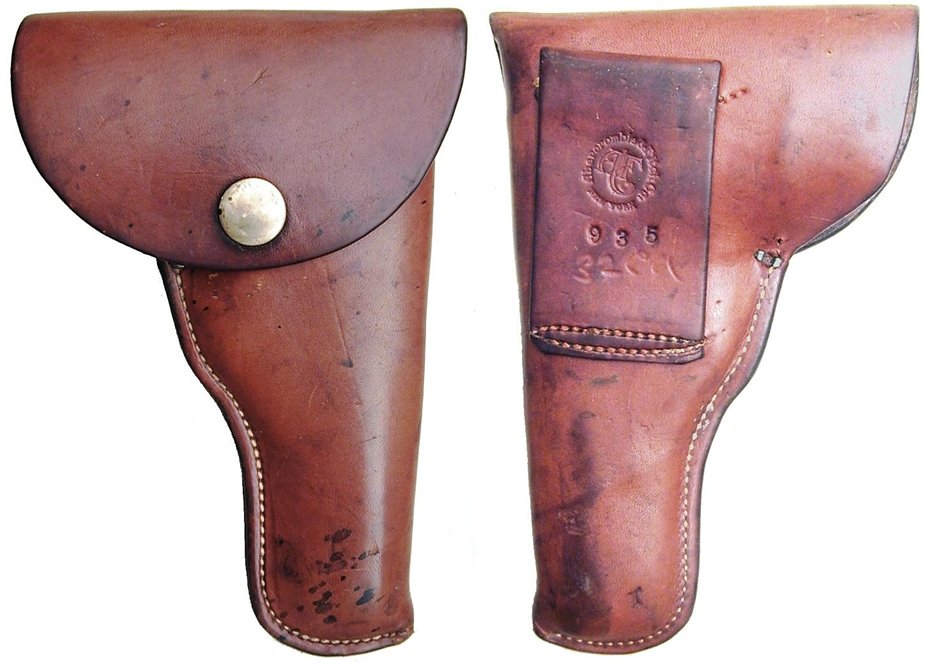
Pictured above is another interesting Heiser style number 935 with an A&F variation 3 circular logo. The holster was made for a .32 caliber automatic pistol as indicated by the Heiser added 32 ca pistol marking on the holster rear belt loop, under the A&F logo and Heiser style number. Per the previous owner, this holster was the home for a Colt 1908 for the past 50 years. The holster, with its small dimensions of 8 inches long by 5 inches wide, is categoriged by Heiser in its catalog listing on page 3 of their circa mid-1920s catalog No. 23 as MEDIUM. The plain surface brass colored, brass and steel snap fastener assembly, made by the U.S. Fastener Company, an eary manufacture fastener company, is rather large with a 19 mm diameter, considering the small size of the holster.
The 935 holster style is described on page 20 of the Heiser catalogs, numbers 20 and 23 as identical to the 435 style, except for being made of medium weight leather with a measured nominal leather thickness of 3mm, similar to the featured LARGE size 935 dyed black holster for a Luger. Per the Heiser catalogs the 935 is identical to the 435, except being made of medium weight leather and one has to assume Heiser is referring to the thickness of the leather. Using that assumption, both 935 style holsters, the LARGE size for the Luger and the MEDIUM size .32 Cal holster, have a nominal thickness of 3mm. The 435 is stated to be made of heavy weight leather. One 435 holster in the collection has a nominal thickness of 3.5mm and the 435-4 holster has a nominal thickness of 4mm, but has to be discounted, due to its layered construction. No conclusions can be reached without more samples.
The final difference is in the appearance of the 4¾ inch barrel Luger 435 LARGE style vs. the 935 LARGE style of which the Sturgess example is brown in appearance, described as; heavy oak tanned California skirting leather in the catalogs, whereas, the two examples of the 935 for the 4¾ barrel Luger are dyed black, identified on page 3 of the 1922 Heiser catalog, under SCHEDULE OF EXTRA CHARGES as an option. With the identity of a 935 MEDIUM style holster for a .32 Cal automatic pistol that is not dyed black, but whose leather is identical, in appearance, to the 435 Sturgess holster, making yet another 935 variation.
The conclusions being that one cannot categorically rely on the holster descriptions in the Heiser catalogs, as all holsters were custom ordered as demonstrated herein, and additionally throughout the many years Heiser holster offerings despite, in this case, maintaining the 435 and 935 style numbers, there are many variations encountered that deviate from the original offerings.
Further Heiser holster information
Holsters made by Heiser for Lugers, other pistols and revolvers, are described in their catalogs as being made of one kind of leather, heavy Oak Tanned California skirting leather with different style No. sub-variations being; Medium weight leather or Fine all plain finish only.
Holsters advertised in the A&F catalogs from 1909 through 1915 are described for Lugers (No. 7 in the 1909 through 1912 catalogs and as style No. 2F302 of fine russet leather and No. 2F303, heavy Reinback leather (unidentified) in the 1913 and 1915 A&F catalogs, also as made of fine russet leather, $1.50 and Heavy Reinback leather (unidentified) $2.00. Interestingly, the 1912 Abercrombie’s Camp catalog advertises and pictures a Luger holster No. 913, last pictured in the 1904 – 1906 A&F catalogs as No. 3, being made of; Heavy black harness leather, for Luger pistol. Price $1.25.
| |
|
Close section.
|
- Example 13, Heiser No. 935X 2
| |
 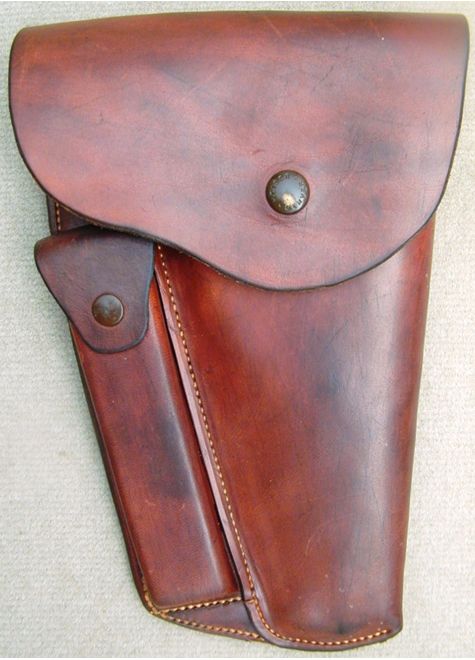
Mouse over image to see back side of holster.
Pictured is an HH Heiser holster style number 935X 2 for a 4-inch barrel Luger. This style number is listed and described in several 1940s Heiser catalogs. However, the subject holster, per the Heiser catalog description doesn’t exist, as the catalog description of style number 935X states: This holster is made of medium weight Oak Tanned California skirting leather, un-lined, closed end, snap button flap. Back is double stitched, with clip box sewed on. Made for 22 caliber Colts automatic only, not made for any other gun. The Heiser holster style No 935 designation series is quite divergent, from several sizes of full cover flap, belt-loop holsters without added/attached magazine pouches to the subject 935X 2, unique style belt loop holster with separate front facing magazine pouch combination. This makes the subject holster a rare classic, special HH Heiser order item.
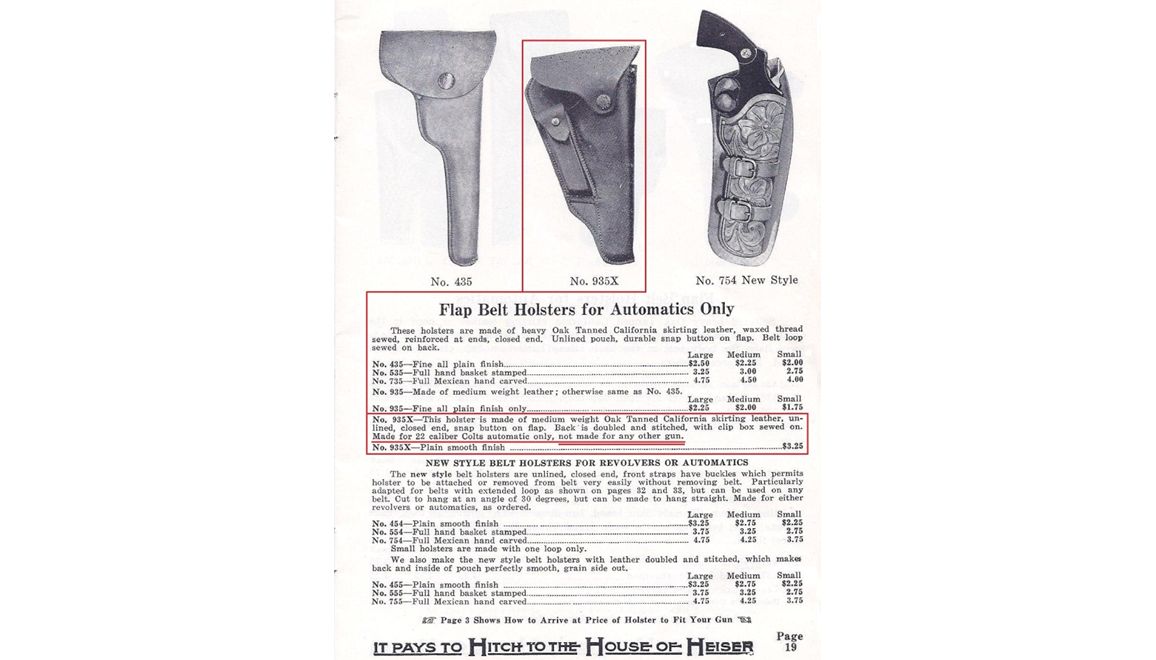
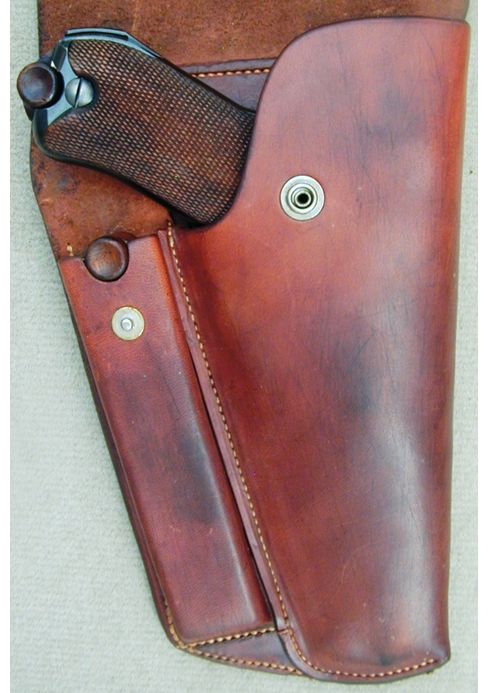
| |
|
Close section.
|
- Example 14, Heiser No. 1410
| |
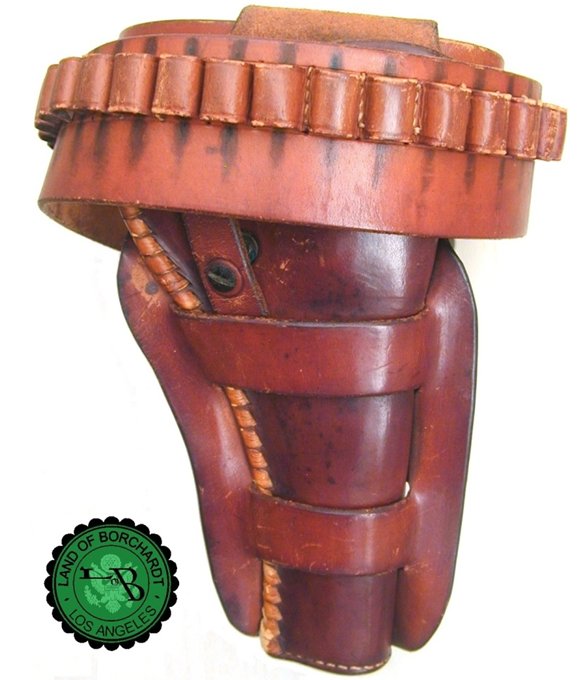
Pictured is an Abercrombie & Fitch holster and belt rig, consisting of an open top holster for a revolver with a safety strap closure and with a holster body closed toe plug. The holster, style number 1410 is made by Heiser. The leather safety strap is secured to the holster body by stitching and a single Heiser triple H embossed logo rivet. The holster rear is stamped, interestingly, with not one, but two variation 3 A&F circular logos, being the first documented instance of a double A&F logo stamping on a holster. The upper portion of the first logo with the 1410 is partially covered by the holster backing and the lower logo is completely covered by the lower backing strap and can be seen, only by moving the holster body backing strap out of the way. The holster is in overall excellent condition with the stitching intact, no stains, tears with the exception of the safety strap snap fastener button, which has been altered or possibly repaired, by adding a slotted, threaded screw through the top of the existing button.
This holster was advertised, listed and described in text, but not pictured, in Heiser catalogs as early as the 1922 catalog number 20, described on page 18. The 1410 holster style is also advertised on page 8 of the 1937 Heiser catalog, number 30 and in the 1938 catalog number 32, also on page 8. This would date the subject A&F holster from the early 1920s to the late 1930s, probably 1925 – 1935, the era of peak popularity for A&F products.
The holster belt, which is in excellent condition, is 2¼ inches wide x 45 inches long, and is stamped 38 and hand written 38 by Heiser, below the stamped number. The belt has 38 stitched cartridge loops for holding .38 caliber revolver ammunition and shows evidence of long term ammunition belt storage, in the form of a darkened area, above the loop and below, where the bullet protrudes through the bottom of the cartridge loop. The nickel “California” belt buckle is bright with no corrosion and is secured to the belt with a small 3½ long x 1¼ inch wide leather strip by stitching, terminating in a wedge pattern. The A&F variation 3 logo is stamped on the belt loop attaching leather strip, to the left of a two digit number stamping 38, which, apparently, is the Heiser style number. At the other end of the belt is a similar attached leather strip, except 10 inches long x 1¼ inch wide, attached by stitching with 5 belt adjusting holes.
The belt is advertised in a 1922 catalog 20 and a 1924-25 Heiser catalog, number 23 on page 27 as style number 38, and on page 28 of a 1937 Heiser red cover catalog number 30, also as style number 38. The belt dimensions, as stated in the catalog text description are identical to the actual belt dimensions. Only the stitching of the leather strips at each end of the belt, of which the pattern is not quite identical, but the difference can be attributed to the whims of the leather maker. The advertising time frame of the belt coincides with the holster and pretty much confirms that the holster and belt were ordered together, through A&F, either from an A&F catalog or a retail outlet.

There is another is another identified, almost identical 1410 holster, except with a Heiser Logo only, stamped on the rear, however, based on the later style of the Heiser Denver logo in oval cartouche, dates the holster to the 1940s or 1950s. The holster is described as for an S&W “K” frame, 6 inch barrel, 22 Cal revolver, whereas the subject, twice A&F logo stamped Heiser style 1410 was described by the seller as for a 5½ Colt SAA.
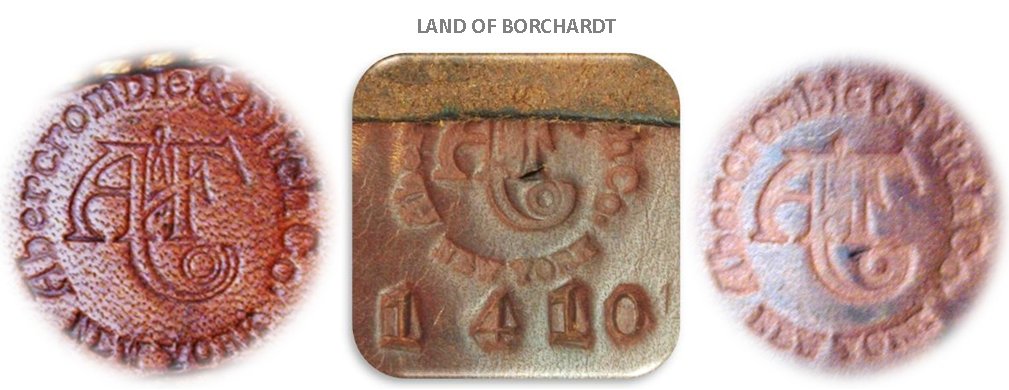
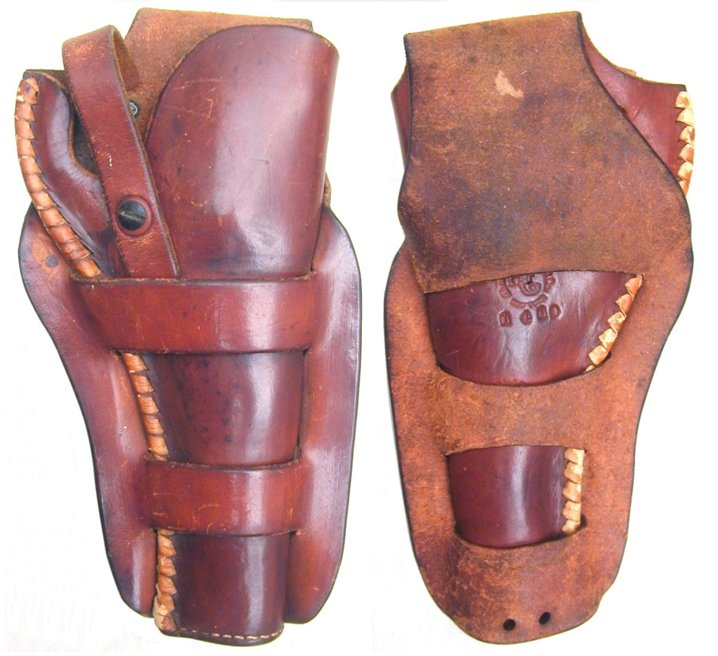
| |
|
Close section.
|
- Example 15, Heiser No. 1722
| |
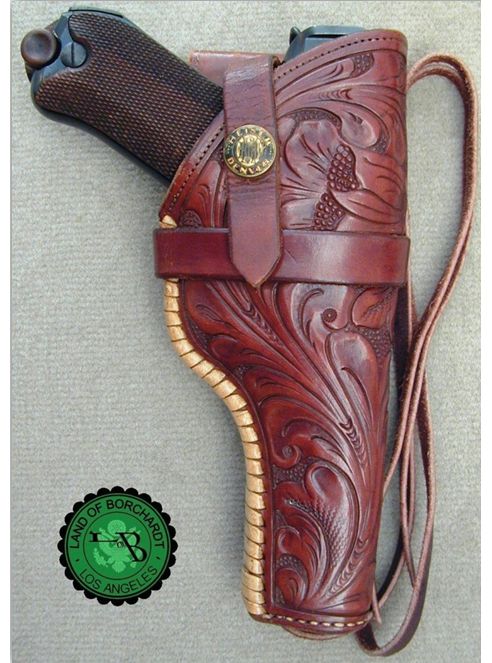
Mouse-over to see back side of holster.
The subject H.H. Heiser style No. 1722 Luger holster was one of Heiser’s deluxe holster offerings. The holster is in magnificent condition with the only flaw being the surface cracks on the safety strap. It is fully lined, with a very stylized Heiser logo safety strap snap fastener, with factory tie-down lace, sewn plug bottom and full floral carving or “Full Mexican hand carving” per the catalogs. Heiser did put a finish on their holsters and it is amazing how many still have their original finish. The "3H" Heiser logo rivets date the holster to no later than the early 1930's, as collectors believe Heiser started using plain rivets after that time.
The style No 1722 holster was first offered in the early 1920s Heiser catalogs, although not in the 1921 catalog 19, but the catalog 19 does advertise or introduce the style No. 722. Heiser style No. 1722 starts with identified catalog numbers 20, 23, ending in the 1940s with the 1942 catalog No. 36, listed on page 12, making the holster from 80 to 90 years old. Based on some collectors’ observations as stated above, Heiser went from plain stamped rivets to logo rivets in about 1930, therefore, the subject 1722 Heiser logo rivets would date it to about 1930 at the earliest.
Assuming, at least with this style No. 1722, one would expect to see post 1930 made style No. 1722 holsters, up to 1942, with or without the use of plain, no-logo rivets. Heiser probably started making holsters for the 1920s Stoeger Luger contract imports, however, Heiser holster ads are not seen in the Stoeger catalogs until the 1930s. As a matter of note, a pre-WW1 Heiser Luger holster has never identified. The Heiser catalog ads for the 1722 states that it is identical to the 722, except for the added leather lining and toe plug.
Since all Heiser holsters appear to be individual, special order items, as contrary to the catalog 20 specific page 18 statement of: No. 1722 is the same holster as No. 722 shown on page 17 with following additions: Leather Lined and Plug in Bottom. is not always the case, as the pictured Heiser style 722 for an Artillery Luger, while not being lined, does have the added toe plug and additionally the belt loop is stitched to the rear, whereas, the No.1722 belt loop is secured by three Heiser triple H logo rivets to a strap around the holster. Interestingly page 17 lists but does not show the No. 722.
| |
|
Close section.
|
- Colorado Saddlery Co. No authenticated examples noted with A&F logos.
| |
There is scant information published about the Colorado Saddlery Company of Denver Colorado, only that it was founded in 1945 by “four young saddle makers” in Denver, Colorado. These young men had been working for the world famous, Denver based H. H. Heiser Saddle Co.
That Colorado Saddlery made holsters for the Luger is certain, as pictured is a rare, period Colorado Saddlery holster for a four-inch barrel Luger. The word rare is not over used in this case, as Colorado Saddlery holsters, especially for the Luger are hard to come by, but even they are common compared to locating an original Colorado Saddlery catalog, which are practically non-existent, never being offered for sale.
The first holster is an open top, closed toe, with a safety strap closure, and the leather is dark brown. The four-inch barrel Luger holster is believed to be an early Colorado Saddlery offering, based on a
different, earlier style logo stamped on the rear and three digit holster style number. The logo is in the form of a small, simple design, 19mm wide x 10mm high oval cartouche, enclosing a three-line upper case text character stamping: COLORADO – DENVER – SADDLERY and below the logo is stamped with the holster style or catalog number 605. The snap fastener assembly has no markings that identify the maker and has no logo or markings on the originally black enamel painted brass cover snap.
The next pictured holster is an extremely rare, excellent condition, with a beautifully Mexican hand carved floral design, whip stitched, leather-lined holster for a 3-5/8-inch barrel Luger, signifying being made for a 1920s commercial, 30 Cal Luger. The holster is an open top, closed toe, safety strap, with a United Carr made snap fastener assembly. The logo on the holster backside is very stylized, stating in three lines:Colorado – Saddlery – Denver with the style or catalog number 1914, and hand written Luger 3 ⅝ on the back, using a ballpoint style pen, invented specifically for marking leather. It is this specific marking that associates of makes the connection to the H.H. Heiser practice of marking many of their Luger holsters, as the style of the word Luger is similar to some marked Heiser/Abercrombie & Fitch Luger holster markings. One of the former Heiser employees who formed Colorado Saddlery in 1945 could have made the markings. Additionally, the use of an apparently new four-digit style number places this holster to a later time, probably the 1960 – 1970 period.
Also pictured below is a special order, equally rare, beautifully stylized, Mexican hand carved Colorado Saddlery holster for an Artillery Luger or LP.08, also circa 1960s – 1970s. The logo on the holster backside is very stylized, identical to the above-described holster, stating in three lines: Colorado – Saddlery – Denver with the style or catalog number 1917.
Pictured is another beautifully Mexican “Hand Carved” Colorado Saddlery holster, style number 1906 and although for a revolver and not a Luger, is shown for its very unique logo, which literally, graphically states “Hand Carved”.

| |
|
Close section.
|
- George Lawrence Company, Portland Oregon.
| |
There are no identified, published George Lawrence holsters made for a Luger with an A&F circular logo. There is, however, a tenuous connection between Lawrence holsters and Abercrombie & Fitch discussed in a 2009 Colt Forum commentary.
Pictured are two mailer type Lawrence holster catalogs, a 1945-1946 edition, and a 1953 U.S. Post Office date stamped Lawrence catalog. The 1945-1946 lists two of the three pictured Lawrence holsters discussed below. Page 5 pictures and describes the No. 25 30L 3-5/8 style and additionally there is a 1939 American Rifleman magazine, page 64 ad for the pictured Lawrence holster for the Luger 3-5/8 inch barrel commercial Luger pistol, Lawrence holster No. 25, as stated in the 1939 ad, and stamped on the subject, pictured holster.
Interestingly, the 1945-1946 Lawrence holster catalog is the only catalog that actually identifies the holsters specifically made for the Luger, with no mention of any other manufacture, whereas the 1953 Lawrence mailer catalog does list and describe, for example, the style number 25 holster on page 4, but with no reference to the Luger or any other specific manufacture. Fortunately for the Luger holster collector, the 1945-1946 catalog does identify several Holster styles for the Luger, such as style No. 9 on page 7 and styles No. 5, 6 and 10 on page 8.

First example holster for a 30 Cal 3-5/8 inch barrel Luger pistol.
Pictured are three Lawrence holsters for a Luger. The first example shown above is for a 30 Cal 3-5/8 inch barrel Luger pistol open toe, style number 25 30L 3-5/8 and the second one shown below is a full flap holster, style No. 14L for a 4-inch barrel Luger, which is believed to be made between 1930 and 1940, based on the Lawrence oval style logo on the holster rear, below the belt loop, and on information obtained from Vintage Gun Leather, and is pictured and described on page 7 of the 1945-1946 Lawrence mailer catalog. Another factor of the Lawrence cover flap holster style 14L that errs toward earlier manufacture, rather than later, is the use of an older style snap button fastener assembly that resembles certain pre-WW1 made holster snap fasteners, except that it is steel vs. brass.

Second example holster is a full flap holster, style No. 14L for a 4-inch barrel Luger.
The third holster shown below is an unusual, special order left-handed, open toe Lawrence Holster, style number X52 - LU 8, made for an Artillery Luger or LP08, which is not pictured in the featured Lawrence catalogs.

Third example holster is an open toe Lawrence Holster, style number X52 - LU 8, made for an Artillery Luger or LP08.
The 3-5/8 inch barrel Luger holster could be 1939 or earlier based on a 1939 Lawrence ad mentioned above, whereas the Artillery Luger holster, based on the logo style was made in the 1940-1980 time frame although, probably made in the late 1940s, early 1950s.
George Lawrence holster number 4, Lawrence style No. 95L 4½
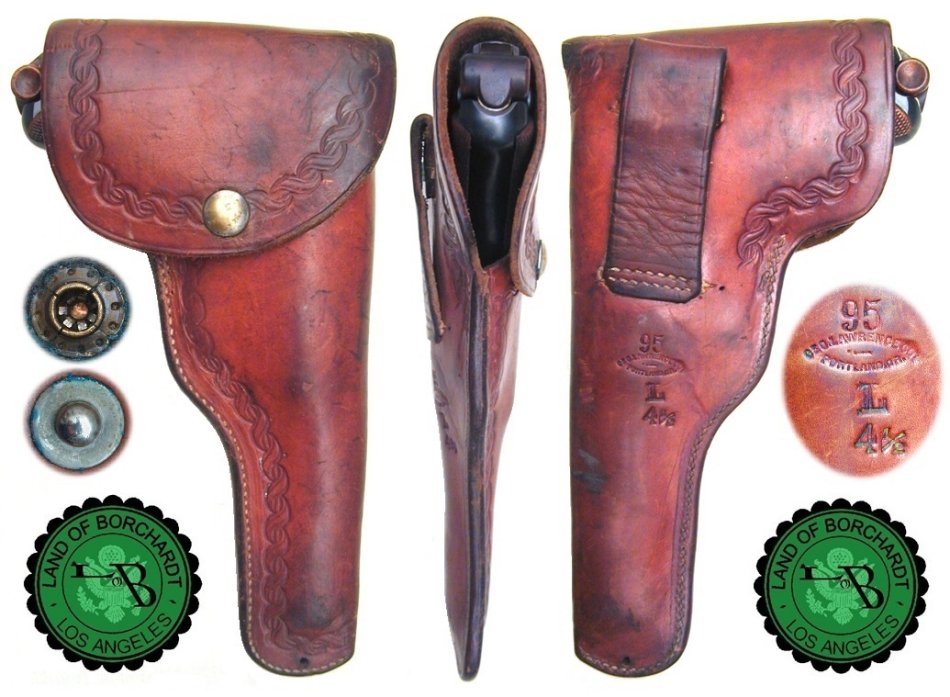
This is a beautifully made George Lawrence Company Model #95 Flap Side Holster constructed of Premium Skirting Leather. The Flap is secured like the Old Military Flap Holsters of World War I with a Single Brass Post so the Flap can be opened very quickly when necessary. This awesome George Lawrence Company Model #95 Flap Side Holster was made to carry a 4½" barrel length revolver for the Right Hand Shooter, and is so marked. Stitching is all intact and shows minimal wear for a holster of this age.
This great model #95 Flap Side Holster is properly marked with the George Lawrence Company, Portland, Oregon maker mark Football Style logo which would date this holster from 1893 to the 1940's12. Style and construction would suggest this particular holster was made in the 1910's to early 1930's, based on the early type snap, and rope style edge tooling that was popular during that time frame. A very nice antique Lawrence holster that would be a highpoint in any collection.
The above description is how the subject holster was advertised for sale and is reasonably accurate, except for the sellers statement that it was made for a revolver where, in fact, the full cover flap holster was made for a 4¾ inch barrel, 1906 new model grip safety Luger, of which the seller, apparently did not notice or recognize the tell-tale signs of holstering a Luger. This is evidenced externally, by the long term storage impression or bulge, left in the holster body of the right side forward edge frame/receiver/barrel interface. Internally by the left and right side upper edge serration impressions of the new model square face toggle knob grasping surface and impressions of the rear frame, left and right side rear frame edge. The final verification is the perfect fit of a 1906 new model Luger, conforming to all the existing impressions, which is the only pistol ever housed in this holster.
The George Lawrence catalogs, which are about as rare as the subject holster, especially the early ones, do advertise this holster as Lawrence style number 95 in their 1945-46 catalog on page 7 and in their 1953 catalog number 53 on page 4, and in an extremely rare 1932 Lawrence, 75 year anniversary edition jobbers13 catalog, number 13, on page 15. The holster is pictured and described in text as style number 9 with an additional text only description for the style number 95. The holster was made for a variety of revolvers and automatics of which the Luger is specifically listed in the 1945-46 catalog on page 7 as for: Lugers, 3-5/8 to 6-in. barrels for $2.20 each.
The 1953 Lawrence catalog is the only catalog to picture, both the number 9, and the subject number 95 full cover flap holster, which, based on the top angle of the cover flap of number 95 is not for an automatic pistol but for a revolver, yet does not describe any particular model pistol, simply stating: For Revolvers and Automatics. The 1932 catalog on page 15 has the same basic description as the 1945-46 catalog, although not specifically using the word Luger, but 30L, possibly meaning for a 30 caliber Luger, interestingly being a jobbers catalog, sold by the dozen for $24.00 or $2.00 each. The 30L listing, coincidently, is not listed on the 1945-46 catalog.
The holster could possibly be dated to pre-WWI manufacture based, partly, on the early style snap fastener assembly, the fact that it is for a 4¾ inch Luger barrel, and based on information obtained from Bill Lawrence, the great grandson of George Lawrence, that according to his files, the first Lawrence catalog to feature holsters was 1915, catalog number 7. The subject style No. 95 holster, pictured next to the No. 9 catalog pictured holster, shows the similarity of the holster body styling and of the rope style edge tooling.
Possible period manufacture candidate Lugers for this special custom order Lawrence holster could be a 1920s Abercrombie & Fitch Swiss chamber crested, 4¾ inch barrel, 30 Cal Luger or a 1930s A.F. Stoeger, Inc. American Eagle chamber crested, 4¾ inch barrel, 30 Cal Luger made by Mauser, of which, ironically the George Lawrence Company did have an arrangement to make holsters for A.F. Stoeger, Inc. in the 1920s, as attested by a rare example holster shown below, with both an early, seldom seen Stoeger Auerhahn logo and an early logo style George Lawrence Company snap fastener button embossed logo and rivets.

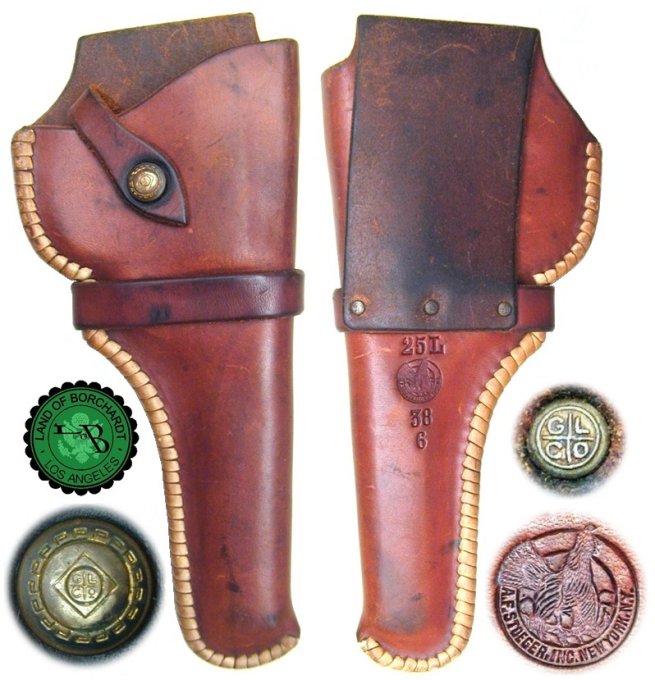

Regarding the Colt Forum comment on the Colorado Saddlery and A&F association that: Heiser & Colorado Saddlery made most of the holsters for Abercrombie & Fitch & their subsidiaries VL&A & VL&D. There is no doubt of the Heiser and A&F association, but to mention or imply an equal Colorado Saddlery and A&F association is doubtful vs. the many identified Heiser made A&F logo stamped holsters, whereas there are no positively identified Colorado Saddlery holsters with the A&F stamped circular logo, and as of this writing, no authenticated, published examples of a Colorado Saddlery holster made for a Luger with the A&F stamped circular logo. There are some holsters that have a stamped A&F logo in a rectangular form, but the holster manufacturer is uncertain.
| |
|
Close section.
|
- K-Leather Products, Inc, New York. No authenticated examples, possibly variation 4.
Three different style A&F leather stamped trademark logos are found on the several Luger holster variations discussed and pictured herein. Two circular logos are readily recognized and generally accepted as authentic. Variations 1 and 4 have the – ABERCROMBIE & FITCH Co. - NEW YORK in upper case letters around the logo circumference. Variation 3 is an identical circular logo, except only the first letters of the words are capitalized with the balance in lower case -Abercrombie & Fitch Co.-New York. Each of the logos have a very stylized five-character set center design. The A&F Co logo in the center consists the following characters; A, &, F, C, and o. Both variations 1 and 4 have the same style center logo with the variation 3 center logo being slightly larger. The variation 4 logo is unusual in that it is a rectangular design, with all the text in straight lines, yet with the same center stylized five letter character set positioned above the text. There is a variation 5 A&F logo on a non-Luger holster discussed below.
There are five, in total, A&F holster logo variations identified herein. The designs have all upper case full ABERCROMBIE & FITCH CO - NEW YORK spellings around the circumference, but with a four character set center design, except some variation 1 examples lacking the fifth character “o” within the C as in “A&F Co”. One being the variation 4 P.08 style holster, an Audley holster with the AUDLEY Patented OCT. 13, 1914 statement logo and added A&F logo, one on an A&F commercial Luger Artillery board stock5 and the other being a very rare ERMA manufactured sub caliber conversion unit with a small 11 mm diameter A&F logo on the forward link or breechblock. For more information regarding the ERMA manufactured A&F logo marked Sub Caliber Conversion Unit, click here.
Interestingly this four-character A&F logo is pictured in only one Luger publication, complete with an A&F upper cased spelling around the circumference in a line drawing format in World of Lugers6 by the late Sam Costanzo on pages 151 and 234 as item 271 along with item 271A stylized A&F five-character set logo, obviously depicting the A&F trademark logo, being the holster leather stamped logo centerpiece design and also on the early A&F holster snap fasteners.
The Variation 2 logo is new, never being pictured before. It has an oval style with the same variation 1, all uppercase - ABERCROMBIE & FITCH CO - NEW YORK around the periphery. Interestingly, the style of the five-character set center section is slightly different from the others. The first thought is to be suspect of an unknown A&F trademark logo, appearing after a hundred years, but it is undoubtedly genuine. This is based on another irrefutable A&F trademark logo on the variation 2 A&F Co marked holster, namely an original A&F metal snap fastener assembly, used with both variation 1 and 2 holsters. Both snap fasteners on the variation 1 and 2 holsters are identical, being genuine and authentic five-character set design A&F fastener assemblies, original to both holsters.
In support of the originality of the oval A&F logo there are, very seldom seen, rectangular logos and there could possibly be more A&F logos not pictured or recognized and not necessarily on holsters. A possible reason that could account for the different style leather stamped A&F logos is that perhaps the A&F Company gave certain artistic liberty to the various holster suppliers with regard to the leather stamped trademark logo as long as it basically represented the A&F company.
There was no such latitude with the very stylized A&F trademark logo embossed metal snap fasteners. The A&F company, no doubt, contracted with only one supplier, U.S.F., prior to 1920, as no other style snap fastener has ever been seen on an A&F holster before 1920. Actually the center, stylized five-character set A&F Co of all noted leather stamped logos remained, basically true to the original company logo. It is the logo outer periphery, full spelling character set that varies. The A&F Co. introduced their famous trademark logo sometime between 1903 and 1906 as a solitary, no fanfare example, pictured on the rear cover of the 1905 and 1906 catalog, at the bottom of page 301 of the 1905 catalog and on page 319 at the end of the 1906 catalog. However, it prominently does appear on the 1907 A&F catalog cover , except for the, one time 1907 catalog only addition of the two words; TRADE-MARK under the A of A&F. The basic design stays the same, but without the TRADE-MARK statement, at least to 1919 when the same stylized A&F trademark logo is pictured on the cover of the 1919 A&F, 27 page revised price list. It is basically identical to the snap fastener A&F logo, meaning it could have been used on holsters as early as 1905.
There is one instance only, of the 1907 catalog unique A&F cover logo, identified herein as variation 5, appearing on a holster and that has been identified on only one style holster, being a special order holster for the Model 1911 U.S. Army .45 Colt automatic pistol.11 These holsters were ordered by U.S. Army officers, privately, through A&F, circa 1912 – 1916, some of who preferred civilian or private made holsters over U.S. Army military issue. There are several other examples of these particular swivel or mounted style M1912 holsters, some possibly made by Heiser and some marked A.F. Stoeger, Inc. No variation 5 A&F logo has ever been seen on a Luger holster.
Various early original A&F catalogs from 1903 through 1941
The information presented here is not completely related to the subject of the article being A&F holsters made specifically for the Luger Automatic Pistol, but is interesting material to the collector of these early, rare, and valuable A&F catalogs.
| Original/Original |
Original/Original |
Copy |
Original/Copy |
Original |
Original |
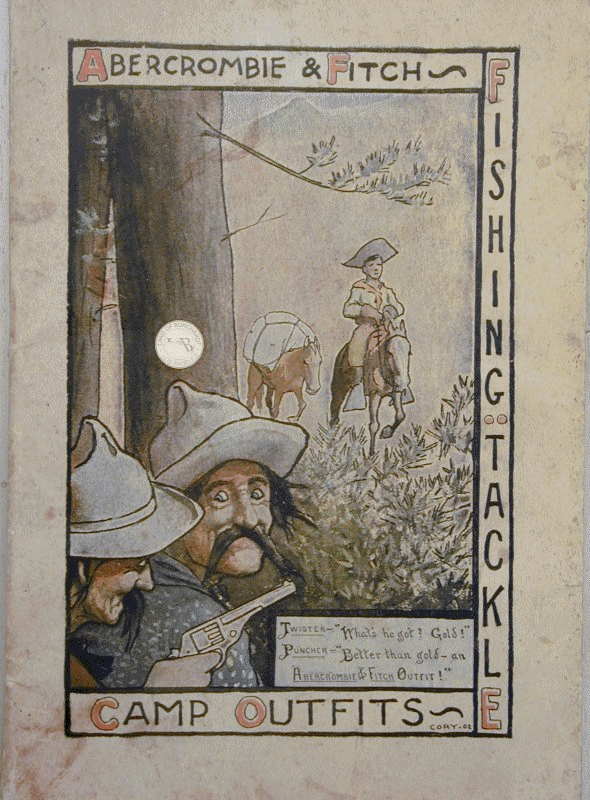 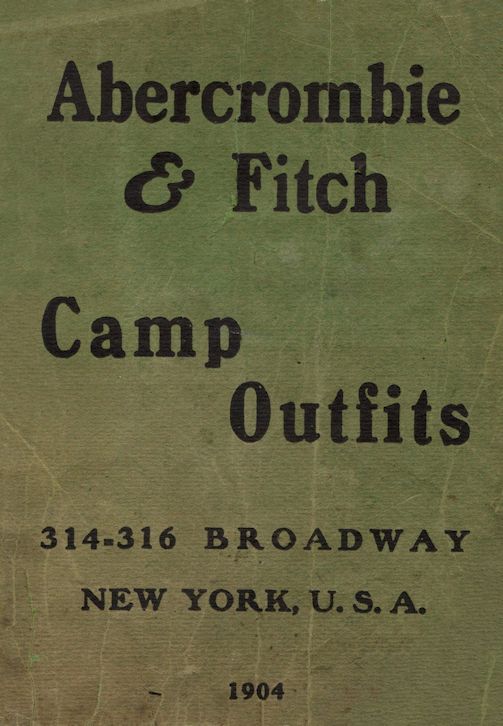 |
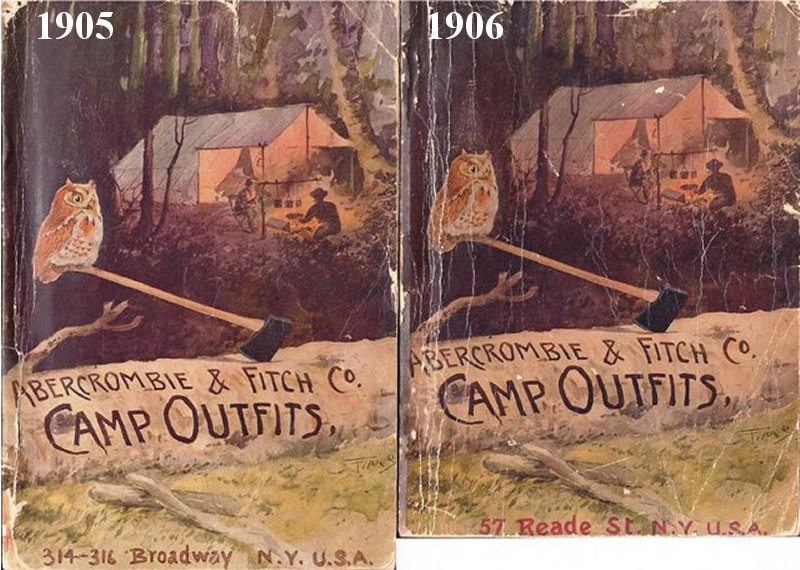 |
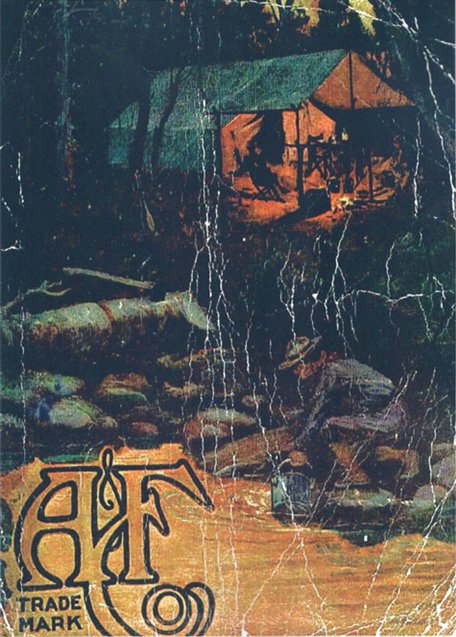 |
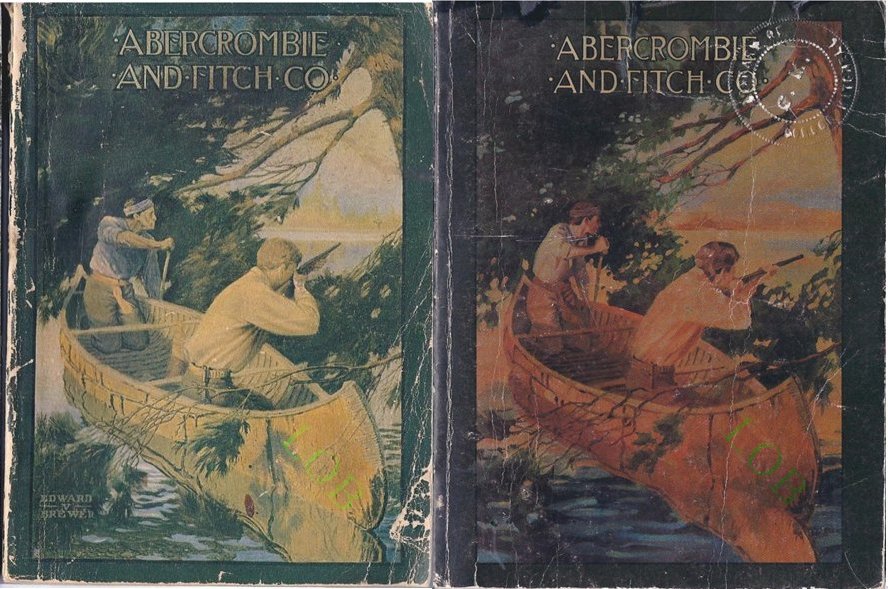 |
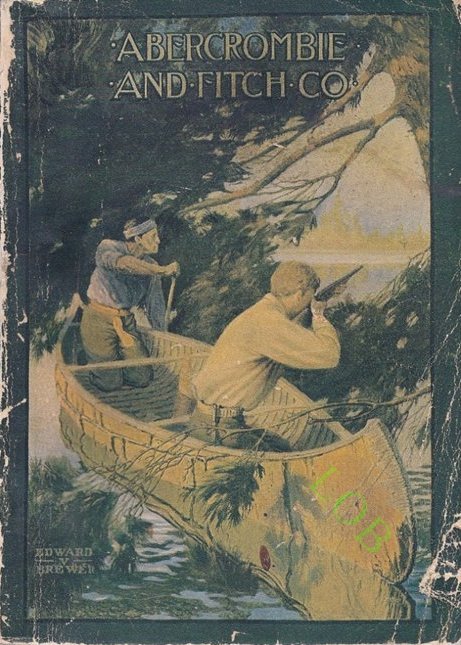 |
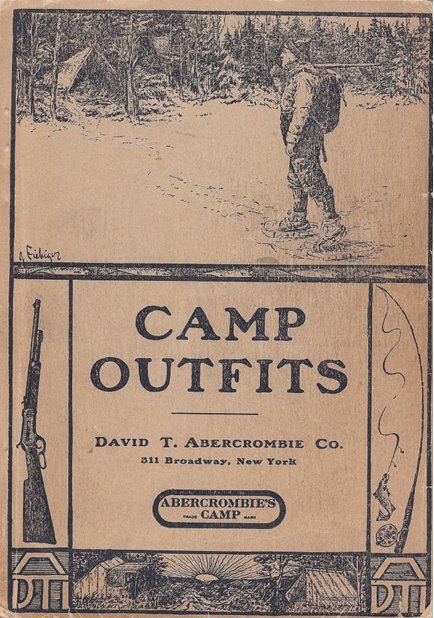 |
| 1903/04 |
1905/06 |
1907 |
1909/10 |
1911 |
1912 |
|
| Original |
Original |
Original |
Original |
Original |
Original |
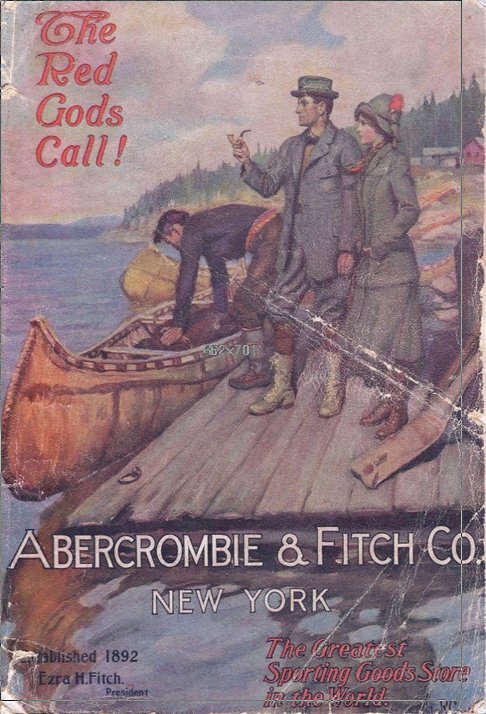 |
 |
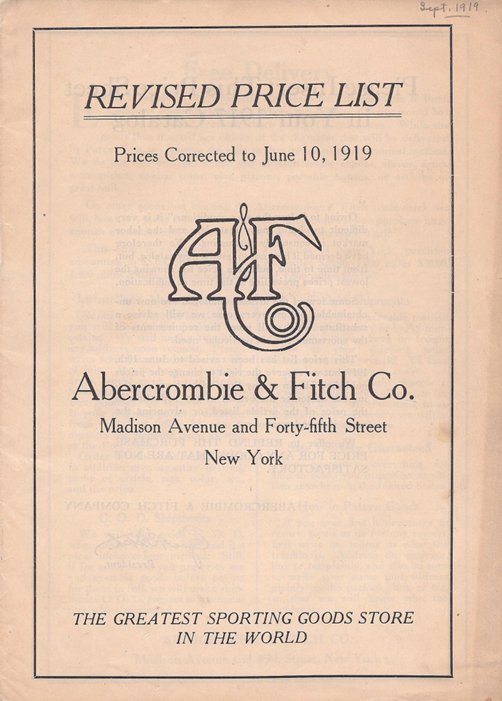 |
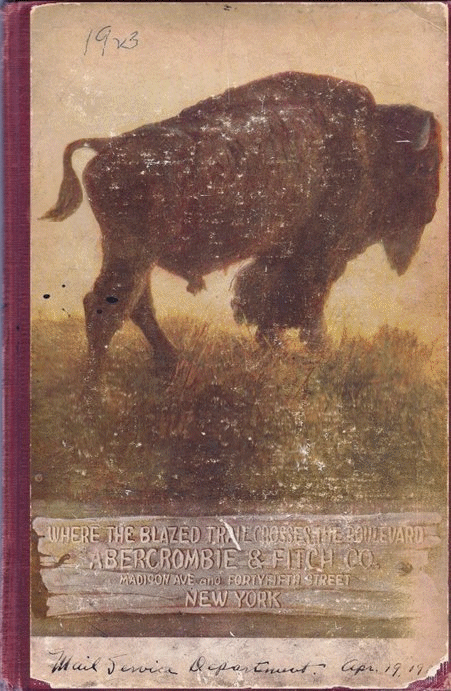 |
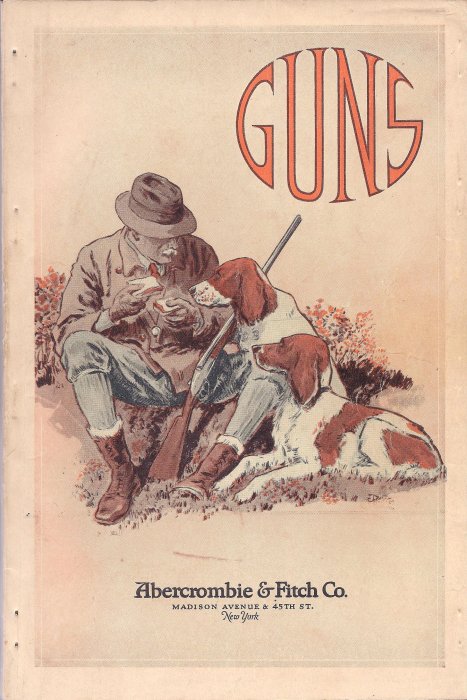 |
 |
| 1913 |
1915 |
1919 |
1923 |
1930 |
1941 |
| |
The 1903 and 1904 A&F catalogs
The January 1903 dated Abercrombie & Fitch original catalog is the earliest known catalog, even though Ezra H. Fitch joined the David T. Abercrombie Company in 1900 there are no earlier identified 1900-1902 A&F catalogs. Although there are probably earlier catalogs, as page 1 refers to the 1903 catalog as: Abercrombie & Fitch PRESENT THIS ENLARGED AND FULLY ILLUSTRATED catalogue. These earlier catalogs, if any, are not necessarily with the title of Abercrombie & Fitch, as prior to 1900 the catalog title could have been The David T. Abercrombie Company Catalogue with an address of 36 South Street, New York, which was his business address from 1892 to 19024. The 1903 A&F catalog measures; 5" x 7" and has 160 numbered pages. The front cover art work was done in 1902 as evidenced by the artists name and date in the lower right. Note the A&F logo posted on the tree.
This store was the greatest of all the early sporting good dealers. This 1903 A&F copyrighted issue was the eleventh year of this great American company and additionally is the first known Abercrombie & Fitch catalog to illustrate, feature, and describe the Model 1900 commercial Luger in the production configuration as shown on page 149. Other contemporary period publications that advertise the Old Model Luger used pre-production 1899 Borchardt-Luger line drawings or engravings. Examples being the May 1902 Shooting & Fishing Luger picture and a June 1902 Baker & Hamilton Luger envelope picture. Cartridges in the 1903 A&F catalog were advertised as rimless, Walsrode powder, $2.20 per 100 and either full metal jacket or soft point bullets of 50 round packaging at $1.10 as described on p.151.
Also shown on the same page, below the old model 1900 production Luger, is an advertisement for the Ideal Holster and carbine stock. Since the A&F catalog publication date is January 1903 it is safe to say that the Ideal holster for the Luger was available as early as 1902.
The following is a quote from an Amazon.com.uk advertisement for the sale of reprints of the 1903 A&F catalog: The 1903 catalog is special in many ways. It was one of the last before Abercrombie was bought out by Fitch, and is just before the company officially incorporated as Abercrombie and Fitch in 1904. Actually, there were four more issues of the catalog to sport the name Abercrombie & Fitch on the cover, being 1904, 1905, 1906, and 1907; before David T Abercrombie left the firm he created in 1892, to start his new company, Abercrombie’s Camp in 1908.
Since no A&F titled catalog, prior to 1903 has been published or identified, that part of the Amazon.com.uk advertisement quote regarding the 1903 catalog: it was one of the last (catalogs), cannot be substantiated. Regarding the 1904 incorporation statement, there is no evidence or statement of incorporation on the 1904 catalog cover or on page 1 in the catalog or the March 1, 1904 dated introduction page and a search the U.S. Patent Office archives can find no record of incorporation, however, since A&F is a New York company, the Certificate of Incorporation documents may still reside in the State of New York archives. There is, however, a 1904 catalog copyright statement on the inside front cover. Pertinent ordering and shipping information is described on page 2 of the catalog and the back cover of the catalog advertises fishing gear.

Back cover of 1903 catalog
Additionally the 1904 catalog, which is discussed in another section, does not contain any information or pictures of the 1903 A&F catalog “official” Trade-Mark logo, nor circular A&F logo, first pictured in the 1905 catalog. The 1904 catalog, however, does make use of its “unofficial” logo pictured on the cover page of the 1903 catalog, also being affixed on several items in the 1903 and 1904 catalogs.
Close section.
| |
| |
The 1907 A&F catalog
The 1907 catalog is the first catalog to feature the now registered Trade-Mark A&F circular logo, pictured on the cover and on the May 1, 1907 dated introduction page and on practically on every page in the catalog, which consists of 320 pages, identical to the 1906 A&F catalog. The U.S. Patent Office application was probably submitted sometime after May 1, 1906 and approved or registered sometime before the May 1, 1907 catalog printing. The introduction page is the first catalog since 1903 to have only the signature of David T. Abercrombie, President, with the signature of Ezra H. Fitch conspicuously absent. This is very unusual, as per the records, it was Abercrombie who left the Company in 1907, selling his share to Fitch, who continued the Company under his own management, subsequently the 1909 and 1910 catalogs have only the signature of Ezra H. Fitch, the new President.
Close section.
| |
| |
The 1909 and 1910 A&F catalogs
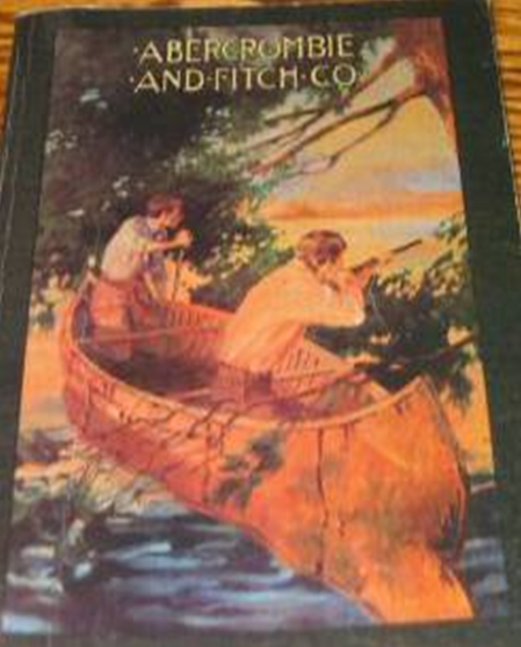
Reproductions of the 1910 A&F catalog were offered for sale at $25 each at the Los Angeles A&F store about the mid- eighties. For a number of years the market was flooded with these cover page altered reproductions. The original 1909, 1910, 1911 and 1912 A&F catalog cover pages have the artists’ name on the cover on the lower left; Edward V. Brewer which is missing in the 1910 copy. Also, the individual in the stern of the canoe is an Indian wearing a headband and a sash. This was probably changed to a Caucasian youth in the reproductions for political correctness. Curiously, except for the different dated copyright statements, both the 1909 and 1910 A&F catalogs are identical, both with 456 pages. It is not known if the 1912 catalog is identical except for sharing the identical cover. Page 211 of the 1909 and 1910 catalogs feature a very unusual A&F logo trademark for a new product named B-VER OIL. The date of the logo trademark registration is unknown, although it is not certain that the product B-VER OIL is the subject of a patent or the ad was simply using the already patented A&F circular logo, as there are no A&F B-VER OIL patent documents on file in the U.S. Patent Office archives.
Pictured is an excellent example of a copy/reprint of the 1910 A&F catalog compared against a 1909 original, which is the copy is exceptionally close to the original, with aged yellow paper, dimensionally similar, with the glaring exception of the cover subject, which is discussed above. Also, certain features of the original catalog are omitted and unless the collector has never examined an original, will not be aware of the differences. Measurements were taken of the copy and compared against the original and is presented in a spreadsheet format. The length and width are slightly different, but the most interesting differences were noted in the thickness of the 1909 original which is more than twice as thick as the 1910 copy and despite being slightly smaller in length and width is 63 percent heaver or 19 ounces vs. 12 ounces of the copy. Since both catalogs have the identical 456 numbered pages the difference is in the weight of paper being used of 0.05 m/m for the copy vs. 0.09 m/m for the original.
Missing in all the reproductions, examined to date, is information printed, interestingly in red ink, on the inside of the front and rear cover of the 1909 and 1910 originals and most importantly, which is very difficult, and costly for reproductions to replicate, is the 6 ¼ inch by 17 inch fold-out “Mail Order Form”, attached (glued) to page 456, the last numbered page of the catalog, perforated for easy removal. As of this writing three different copies of the 1910 A&F catalog have been identified, all three with different covers.
The pictured and discussed 1910 A&F catalog reprint is a very close and convincing copy of the original, even down to a post printing incurred crease in the cover page, combined with a collector added embossed private party “Library” seal and some tape repair, all natural wear, yet giving the catalog a certain aged appearance or “air of originality”. No doubt hundreds of these reprints were made in the 1980s and sold through A&F retail outlets as copies, being a promotional item, however, after the passage of time and natural ageing, already thirty years, these replicates will be mistaken by some collectors, in the absence of knowledge, to be original. Another subtle but significant difference in an original pre WWI A&F catalog or any period catalog vs. a copy is the original text is printed using the “letter-offset” process vs. the “photo offset” process of the modern copy.
Interestingly, although a smaller size, even when enlarged, the 1909 A&F catalog 1A cover pictured in the May 1909 Field and Stream magazine more reflects the original colors and other details rather than the original pictured 1909 A&F catalog cover, to some extent due to different printers, though most probably due to less exposure to the elements of the 1909 Field and Stream magazine example. Also, more details in the May 1909 Field and stream magazine picture are revealed.
A four page (1A through 4A) advertisement for the upcoming 1909 A&F catalog was featured in the May, 1909 Field and Stream magazine and page 1A is pictured herein as it appeared in the May, 1909 issue of Field and Stream Magazine. Pictured below is the four-page A&F spread in the 1909 Field & Stream magazine. The same cover was used for the 1910, 1911 and 1912 catalog as noted by the 1912 on the canoe. As of 2010, publishers are offering copies of the 1910 A&F catalog, apparently unwittingly, with the 1980s altered cover, as an original copy, possibly adding the 1910 date to the catalog cover and, interestingly, along the way, altered again by ageing the cover, giving the appearance of being copied from an old original. Pictured here is the actual cover of the original 1909 catalog as shown in the 1909 Field & Stream magazine and a picture of the front and rear cover of an original 1909 A&F catalog, including the binder.
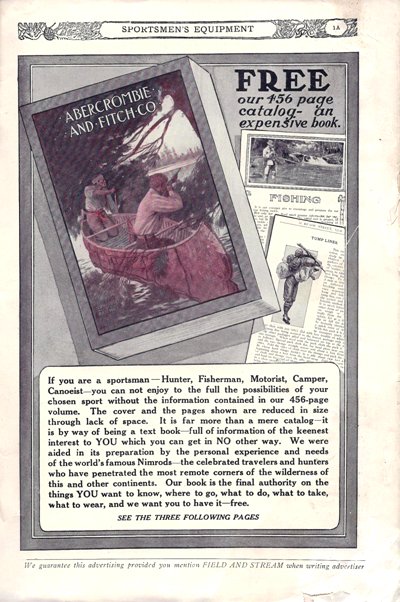
Previous page Next Page
Close section.
| |
| |
1911 Abercrombie & Fitch Catalog

The above ad is how the 1911 Abercrombie & Fitch Catalog was advertised and described and is correct regarding the missing pages, of which most were unceremoniously torn out, including pages 1 through 11. Nothing could be done to recover the missing pages in the middle of the catalog and pieces of the pages remain, however, the missing pages in the front of the catalog, although irreplaceable, the front cover was very professionally rebound to page 13 and tight to the binder edge to be practically unnoticed, even when viewed from the edge. The repair was done, fortunately, by a previous owner, obviously a collector, who realized the collectible value and importance of the catalog.
The advertising description, however, is incorrect in the most important aspect, specifically in the dating of the catalog. The most critical page, missing of the first 12 pages is the Copyright © 19xx statement, and without the copyright date the previous owner probably dated the catalog, based on the well-known cover page subject, being associated with the 1909 and 1910 catalog covers. There is another method to identify the publishing date of these early A&F catalogs which is found, fortuitously, on the inside cover page information of this series of A&F catalogs starting from 1909 and 1910 and this catalog is no exception. As an example the inside cover page of the 1909 catalog has the following statement in red ink: WE HAVE been in business 17 years and our success is due to the fact that we spare no expense to please our customers. Since Abercrombie & Fitch had been established since 1892, then 17 years later is 1909, which is corroborated by the copyright ©1909 statement on page 2 of the 1909 catalog. The same statement is found on the inside cover of the 1910 catalog and most significantly, in this case, on the inside cover page of the 1911 catalog with the following difference in black ink: WE HAVE been in business 19 years and our success is due to the fact that we spare no expense to please our customers. Therefore 1892 plus 19 years, is 1911, which is the actual publishing date of the catalog. The identification of the 1911 A&F catalog makes four consecutive years; 1909, 1910, 1911, 1912 that share the same front and rear cover page subject matter and it isn’t until the 1913 catalog that finally changes the cover, greatly increases the size of the catalog and introduces a new article identification format.
AUTHENTICATION
The establishment of the 1911 publishing date is only one of many differences observed. The 1909 and 1910 A&F catalogs are identical in size and pages, being 456 numbered pages for both catalogs. The 1911 A&F catalog is the same size, except not as thick, having only 293 numbered pages or 163 pages less than the 1909 and 1910 catalogs. Suffice to say the 1911 A&F catalog is much abbreviated , has dropped or eliminated many products or wares, apparently most of the entire section on auto accessories and fishing, found generally above page 300 in the 1909, 1910 catalogs. It should be noted that these 163 or so pages were not removed from the 1911 catalog as the INDEX, consisting of three pages covering articles A to Z, has no entries above page 293 and in addition the existing binder and text would have to be wider or the same size of the 456 page 1909 and 1910 A&F catalogs with the same height letter character font, of which the 1911 character font heights are smaller and the style, which is interesting, is slightly different from the 1909, 1910 catalog binder, being appropriately shorter and centered, top to bottom. In addition, both the 1909, 1910 and the 1911 catalog have the identical number of colored pages, as viewed in an edge cross section of the manuals.
Despite the above detailed information, it is not the goal of this discussion to identify all of the differences, only those that authenticate the catalog, which has been amply established. The main goal, as in all the A&F catalogs discussed herein, is to the evolution of the Luger holster and pistol advertisements, of which the Luger pistol ads have changed.
The 1911 A&F catalog Luger ad on page 262 has changed to include a 1906 long frame, 6 inch barrel 9mm old model Navy Luger rig with attaching stock and strap with twin magazine pouch, which actually is not a 1906 navy Luger rig but a Chilean Trials Prototype 1900 “Push Button” board stock with an old model 30 Cal 7 inch barrel Luger with a standard fixed rear sight. Pictured is a fake Chilean trials prototype “Push Button” stock Luger. If a customer ordered a navy Luger rig through the catalog, based on the ad, it is not certain what navy Luger rig configuration he would receive. The other Luger pictured in the ad is a standard old model 4¾ inch barrel 30 Cal Luger pistol. The Luger ad has definitely evolved from the 1909 and 1910 catalog ads, which picture and describe the old model Luger, also on page 262 and interestingly, describe but unfortunately, do not picture the “1902” Luger carbine, yet the 1911 A&F catalog ad is still dated, or not current, as by 1911 the old model had been eclipsed by the new model Luger, including the navy variation. The ad for the Luger holster still offer the same style holster, pictured on page 275 and described on page 277, as advertised in the 1909 and 1910 catalogs.
The 1911 A&F catalog in the weapons introduction section, page 228 titled FIRE ARMS, describes the Luger: In automatic pistols, the Luger and Colt stand easily first for long range, power and accuracy., whereas in the introduction FIRE ARMS page in the 1909, 1910 A&F catalogs on page 231 describes the Luger and Colt automatic pistols in different terms: In automatic pistols, the Luger stands easily for power and accuracy – the Colt for compactness and pocket use. By 1911 the Colt automatic has been “upgraded/elevated”, presumably by A&F, from compactness and pocket use to one of power and accuracy, including a separate and expanded advertising page for the Colt 45 automatic, elevating the Colt automatic, equal to the Luger, depending on one’s point of view. Although it is not certain if A&F is referring to the Colt 25 and 32 Cal. actual Pocket Pistols or the Colt 45 which is advertised in the 1909, 1910 catalogs on the same page as the Luger automatic.
Close section.
| |
| |
The 1912 ABERCROMBIE’S CAMP catalog and the Luger
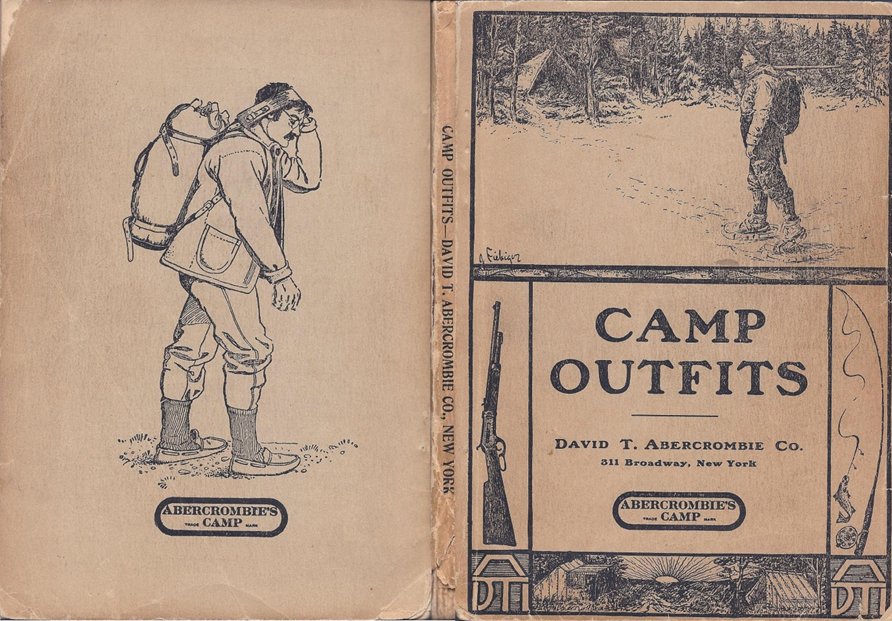
Shown above is a very rare 1912 David T. Abercrombie catalog titled CAMP OUTFITS - DAVID T. ABERCROMBIE CO.. The catalog is 5 inches x 7 inches with 168 numbered pages and possibly represents David T. Abercrombie’s first independent catalog since the rather contentious break-up of Abercrombie & Fitch in late 1907. There is at least one other observed prior publication by David T. Abercrombie between 1908 and 1912, but more in the form of a pamphlet. The newly established David T. Abercrombie Company was located at 311 Broadway, New York City and its’ first identified catalog featured: Complete Outfits for Campers, Hunters, Surveyors, Explorers, and Prospectors. It is not known how successful David T. Abercrombie’s new company was, although based on surviving catalogs, apparently successful enough to stay in business past his death in 1931. The company was taken over by his younger brother, Robert H. Abercrombie in 1927 when David T. Abercrombie retired, and the company continued on into the 1960s as evidenced by surviving catalogs and sales literature.
The next catalog in the collection, chronologically, is a 1927 Abercrombie’s Camp catalog. The 1927 Abercrombie’s Camp catalog cover is a bit colorful with one page advertising Pistol and Revolver holsters, which states the holsters can be ordered for any pistol or revolver, but the most interesting aspect of the 1927 catalog is the FOREWORD page, with very interesting information written by Abercrombie’s son, Robert F. Abercrombie Jr. and successor, which details the company, originally founded in 1892 by his father David T. Abercrombie with unpublished information about David T. Abercrombie’s beginnings and information about his personal life, through his in involvement and role in World War I and after, up to 1927, four years before his death in 1931.
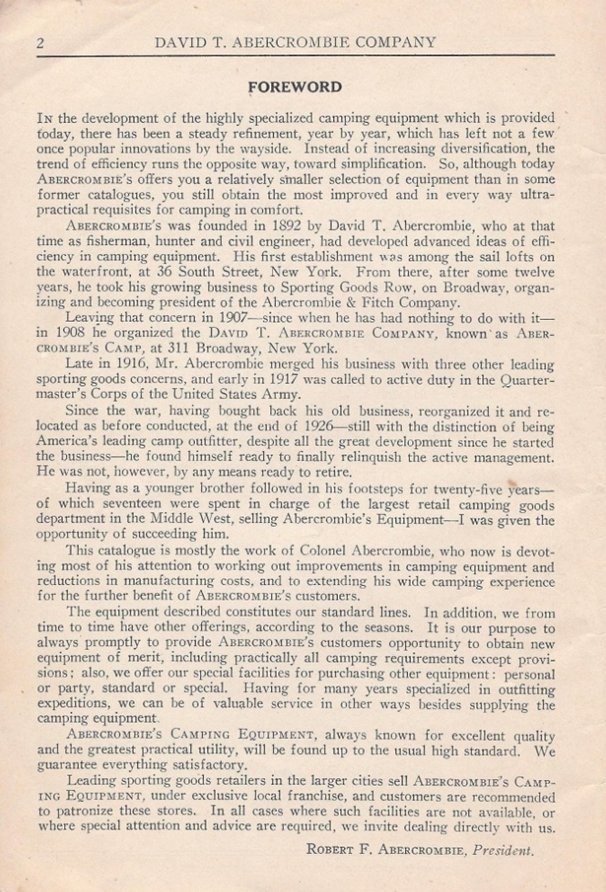
The company was taken over by his younger brother, Robert F. Abercrombie, Jr. in 1927 when David T. Abercrombie retired, and the company continued on into the 1960s, as evidenced by surviving catalogs and sales literature. David T. Abercrombie was quite successful in making his new company ABERCROMBIE’S CAMP more geared toward tents and camping equipment, continued by Robert F. Abercrombie Jr., as all later catalogs contain very little in hunting equipment, guns, or accessories.
From the 1930s and into the 1960s and especially though the war years there are not, as yet, identified Abercrombie’s Camp catalogs, nor Abercrombie and Fitch catalogs for that matter, as after the war the first identified Abercrombie & Fitch catalog is a 1950 A&F used gun catalog, interestingly, advertising three used Lugers, but stating on the introduction page that: Our first gun catalog since the war will be published this September. A copy of this comprehensive book will be mailed to you at that time. Note most A&F used gun catalogs show few pictures, with mostly text descriptions of offerings.

Pictured are some original Abercrombie’s Camp catalogs from the 1940s era, starting with a 1940 David T. Abercrombie Co. Camp Outfitters catalog, stating in the introduction page as being 48 years in business. The 1941 catalog is equally uneventful, stating in the introduction page as being 49 years in business. The 1942 David T. Abercrombie Co. Camp Outfitters catalog is a bit interesting as it is the 50th year anniversary issue stating: FIFTY GOLDEN YEARS IN EQUIPPING AMERICA FOR THE OUTDOORS!
In the collection is a 1955 David T. Abercrombie Co. catalog spring and summer supplement with an interesting cover subject, titled: FORTY 40 Yrs. AGO THIS WAS IT.
The penultimate document in the collection is a 1960s Abercrombie’s Camp autumn, 12 page supplemental flyer with a 2-sided, 1 page insert advertising knives, and other camping paraphernalia, with page 11 of the flyer advertising rifles. The flyer has a new and final 97 Chambers Street, New York 7, N.Y. address location. All previous Abercrombie’s Camp catalogs featured in this article, starting from the 1912 catalog, were located at 311 Broadway, New York.
The final document in the collection is a 1965 Abercrombie & Fitch, 43 page used gun catalog, advertising new and used rifles, revolvers, and into the modern age, a transistor radio and Citizens Band Transistor transceivers, a.k.a. Walkie-Talkies.
The 1912 catalog is of a lesser quality than the earlier, sturdier, color, heavier paper stock front and rear cover A&F catalogs. The 1912 Abercrombie’s Camp catalog had a thin, brown paper background and black text front and rear covers with no color inserts. On the cover is a new Trade Mark logo in the form of a cartouche and possibly another using David T. Abercrombie’s initials: DTA. These early David T. Abercrombie catalogs rarely survive, partly due to their lesser quality, but mostly due to their being a footnote in the history of Abercrombie & Fitch. There is only one article or product featured in the catalog with the Abercrombie’s Camp trade mark logo called Fly Dope and made by Abercrombie.
The catalog rear cover features a man wearing a back pack and had been used in an earlier 1905 A&F catalog on page 302, except without the new Abercrombie’s Camp logo in cartouche.
When David T. Abercrombie sold his share of the Abercrombie & Fitch Co. to Ezra H. Fitch, it is curious that David T. Abercrombie continued to allow the use of his name as the part of the title of the company. It is especially unusual that in 1912, when Abercrombie is trying reestablish himself and his new company, that he now tries to disconnect his name, and himself from his now competitor's firm, A&F. as described on the inside cover of the 1912 catalog. Additionally, in the last paragraph on page 2 entitled THE CATALOGUE, David T. Abercrombie tries to woo former loyal customers away from A&F, referring to them as “old customers” to his new Trade-Mark registered, incorporated company, ABERCROMBIE’S CAMP.
The catalog does not contribute much to the A&F advertising evolution of the Luger. It offered Luger ammunition for the 30 Cal and 9mm Luger on page 132, however the catalog had no advertisements for the Luger pistol. It does, however, picture and offer a Luger holster, but the Luger holster pictured on page 136 as No. 913 for a 30 Cal Luger is a discontinued model as far as A&F is concerned. It was last offered in the 1904 A&F catalog on page 179 listed as No.3 and in the 1905, 1906 A&F catalogs on page 215 also listed as No.3. The holster was apparently replaced by a new style Luger holster with a snap fastener cover flap closure, first pictured in the 1909 and 1910 A&F catalogs on page 278 and identified as No.7. It was again shown on page 275 of the 1911 A&F catalog, also as No.7 and in the 1913 A&F catalog as 2F2302. The 1912 Abercrombie’s Camp catalog, page 136 holster line-up is basically identical, except for the different inventory numbers, to the 1905, 1906 A&F catalog, page 215 holster line-up, down to the identical prices although offered six years later. There are two possibilities that come to mind.
- Abercrombie simply used a 1906 file ad for the holsters and the Luger holster in particular, as he would not have access to any A&F holster file ads after 1906.
- Abercrombie used the same circa 1905, 1906 holster sub-contractor, and if so, the same holster maker made all the holsters pictured on page 136.
Interestingly, the Luger holster offered in the 1904, 1905, and 1906 A&F catalogs and in the 1912 Abercrombie’s Camp catalog has never been identified, which is unusual in itself. Every article or product advertised in an A&F catalog was real. If one of these holsters is ever identified it will be interesting to see what logo it sports, the A&F circular logo or the Abercrombie’s Camp oval logo in cartouche.
Close section.
| |
| |
The 1913 A&F catalog
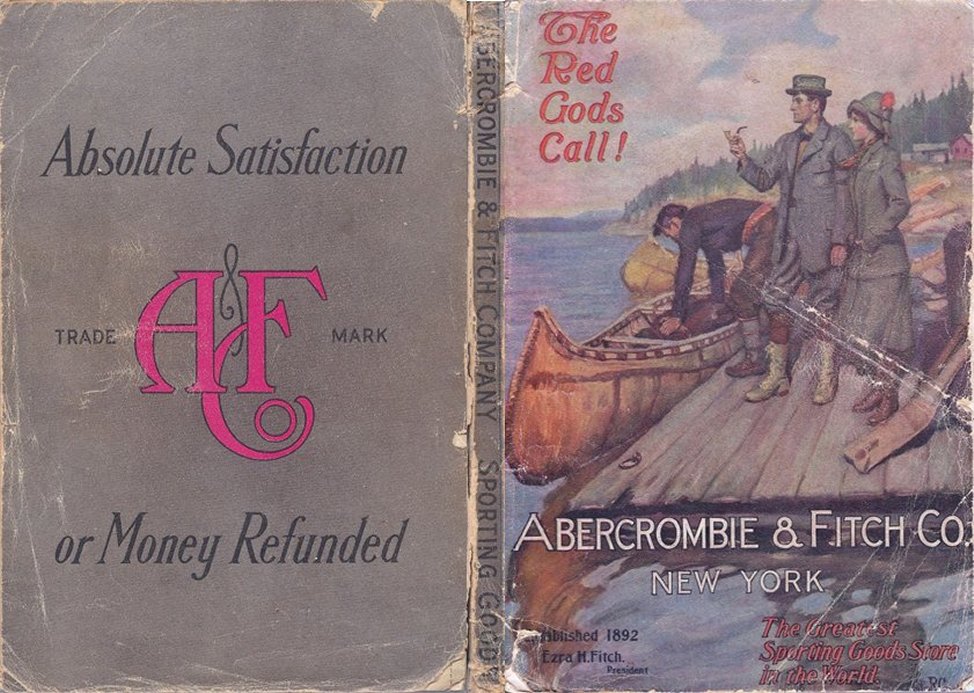
The Red Gods Call! This is the title printed on the cover of the 1913 A&F catalog. “Red Gods - Call to Nature” is thought to be based on a period novel of the same title by Beatrice Grimshaw, published in June, 1911 with a rather nature oriented Kipling forward poem in the front of the book.
The 1913 A&F catalog is the largest format yet published, much larger and more pages than the 1909, 1910 and the 1911 catalog, being 10 inches x 6¾ inches x 5/8 inch thick with 547 numbered pages. Pictured for the first time in an A&F catalog is their “New A&F Building and View of Factories” referred to in their 1906 catalog introductory page, and view of their “Retail Sales Departments” which includes a picture of their gun display counter, enlarged for detail. The catalog still has the two original 2-sided, single page order forms, perforated for easy removal, which has been simplified from the 1909 and 1910 accordion type fold-out order form.
On to the most import aspects of this catalog is the changes to the Luger ads on page 223 and the Luger holster ads on pages on 236 and 237, along with the Luger ammunition descriptions for the 30 Cal and 9mm Luger on page 242. The 1913 A&F Luger ad no longer pictures or describes the Old Model long frame grip safety Luger and now features the New Model short frame grip safety Luger, describing the 30 Cal with a 4 5/8 inch barrel and a 4 inch barrel 9mm Luger, pictured, and interestingly a complete new model long frame, Imperial navy military P.04 configuration as a “commercial” navy Luger rig with a caliber 9mm 6 inch barrel. This is a significant change as the 1911 catalog advertises a commercial navy Luger rig, but pictures a 1900 Chilian Trials Prototype “Push Button” board stock with an old model 30 Cal 7 inch barrel Luger grip safety with six-position rear sight on page 262. Apparently, A&F in their Luger ads were still not current with all the Luger commercial models, as late as 1913 with the evolution of the Luger design, still advertising (1900 and 1906) grip safety Lugers, although still very popular, with no mention of the no grip safety P.08 commercial, which had been in production since 1911 and much available in the United States by 1913.
The 1911 and 1913 A&F catalog ads for new model pre-WWI commercial navy Luger rigs are shown for the first time in these catalogs. They are apparently offered and sold by A&F and give credence to the possibility of the existence of a genuine A&F barrel or otherwise marked pre-WWI plain chambered, or not, commercial navy Luger which is not of the 1920s Swiss crested navy variation.
Also there is a sloppy technical advertising error is the text description and title for the two pictured Lugers. The ad picturing the new model grip safety navy Luger rig entitled THE LUGER AUTOMATIC PISTOL describes the pistol and shows the rig. Whereas the text caption for the navy Luger pistol rig and the pictured Luger pistol entitled THE LUGER AUTOMATIC NAVY PISTOL has the text description of the regular Luger pistol. If a catalog customer ordered a Luger based solely on the catalog number of 2F2107 or 2F2109 it is not certain what Luger model he would get in the mail.
2F2302 Flap holster for Luger automatic pis-
tols. Strap and snap-button fastener,
hand made, fine russet leather……$1.50
2F2303 Same as 2F2302 except made of heavy
reinback leather…………………….……$2.00
The holster ad for the Luger still shows the same style holster, as advertised in the 1909 and 1910 catalogs, now identified as 2F2302 and 2F2303 described on page 236 and pictured on page 337, but eliminates any reference to the holster style pictured in all the earlier catalogs, identified as No.1 in the 1903 catalog, apparently discontinued, being the specific design of holster used as a model for the recently identified 1903 A&F Holster for the Old Model Luger with the first A&F logo. The holster page also pictures an Audley Safety Holster No. 2F2296, but for a Colt and not the Luger. Perhaps because the Audley patent for the Luger holster wasn’t registered until 1914.
Page 242 of the 1913 A&F catalog titled SMOKELESS PISTOL AND RIFLE CARTRIDGES list both the Luger .30 and Luger 9mm rounds identified as Center Fire, packed in 50 round boxes. A&F may have had two suppliers for Luger ammunition, UMC - Remington and Winchester. It has been established that UMC had been making Luger .30 Cal pistol cartridges using Walsrode Smokeless Powder as early as 1901 and by 1913 at least two United States ammunition manufactures had been making Luger .30 Cal and 9mm Luger pistol cartridges, being UMC – Remington, and Winchester. Winchester introduced the 9mm cartridge in 1908 as identified in an original 1908 Winchester ammunition catalog as a new product under the category of NEW GOODS on the inside cover. The Winchester listing for the Luger .30 and 9mm cartridge are on pages 121 and 125 of the 1908 catalog. The 1913 A&F catalog lists the 2F2488 and 2F489 9mm cartridge at 124 grains whereas Winchester lists the cartridge at 125 grains. The 1910 Remington - UMC ammunition catalog lists the 9mm cartridge at 124 grains. Although unusual, one has to assume both loadings are correct, as a 1920s Peters ammunition catalog also lists the 9mm cartridge at 125 grains. Based solely on the loading, Remington - UMC would be the 9mm ammunition listed in the 1913 A&F catalog. The United States Cartridge Company also made 9mm cartridges but their loading is not known and their 1914 ammunition catalog lists the 7.65mm Luger round but not the 9mm.
Close section.
| |
| |
The 1915 A&F catalog
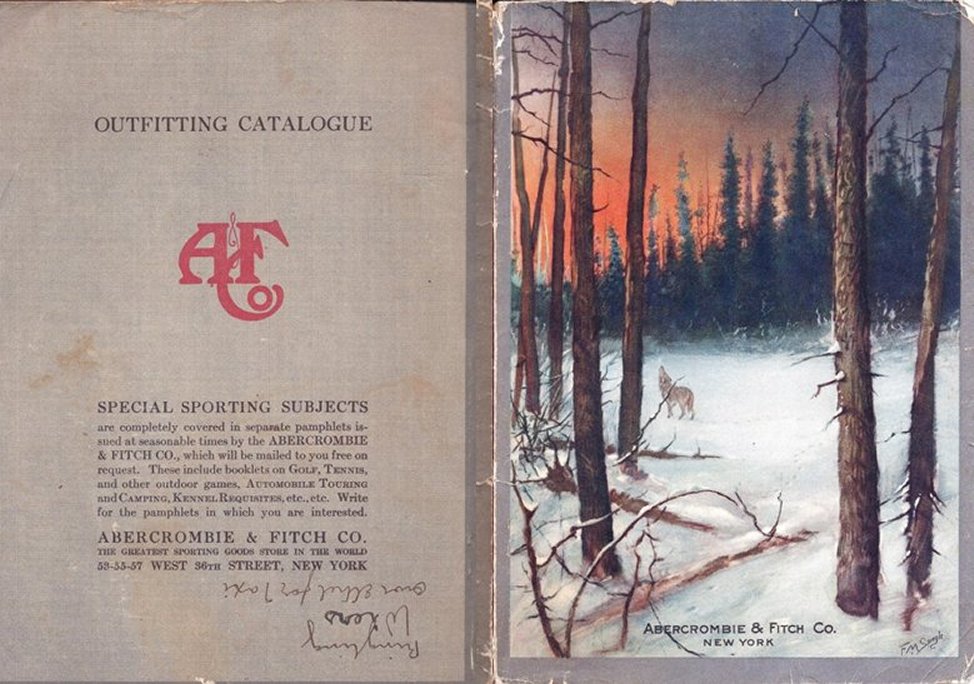
One of the more picturesque A&F catalog covers published is the 1915 catalog and is extolled by Ezra H. Fitch with the following comments:

The catalog is a large 7-inch x 9¾ inch format with 162 pages. The catalog date is verified by the copyright statement on the inside cover. The firearms section is extensive with 29 pages, 54 to 83, covering every conceivable weapon of American manufacture from shotguns, rifles, to automatic pistols, and revolvers. Conspicuously absent, however, are any foreign weapons and especially significant, no Lugers. It seems that Europe, and especially Germany, in the heat of WW1, had no interest or inclination to export commercial weapons as they needed all they had in stock. Put another way, the conclusion being that Europe was heavily involved in war production in 1915 and could care less about gun exports.
The catalog does, however, in the firearm section on the holster page 69 has a holster listing entry for the Luger, which, apparently, despite the war there was some domestic demand, additionally being a domestic product, justifying the ad, identified as item 3F2302 and 2303, unfortunately without any pictures, however, the text description leaves little doubt as to what holster it is describing: Flap holster for Luger automatic pistols. Strap and snap-button fasteners, hand-made, fine russet leather 1.50. This new A&F style No. identification, items 3F2302 and 3F2303 did appear, for the first time, in the 1913 A&F catalog, with the identical text description and with a picture.

Close section.
| |
| |
The 1919 A&F catalog insert
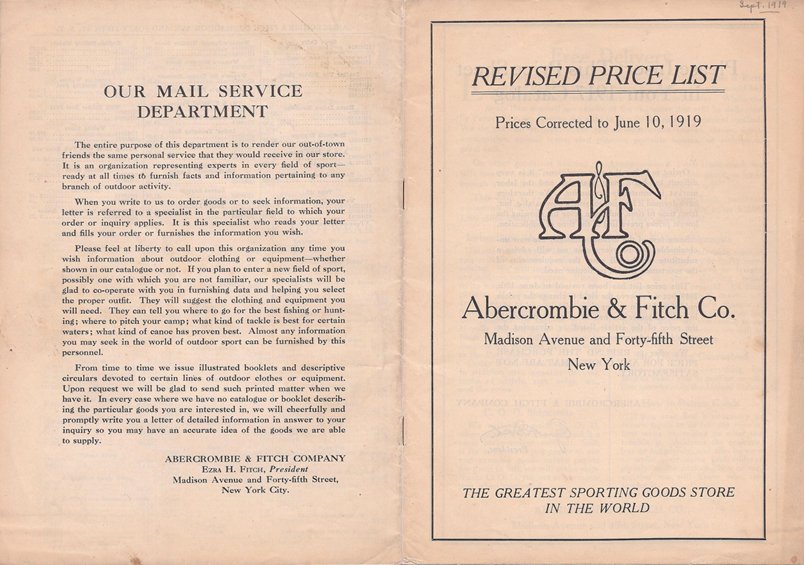
Featured is a 1919 Abercrombie & Fitch, REVISED PRICE LIST with 27 numbered pages and with prices corrected to June 10, 1919. Although not a catalog, the document is important, as it is the next best thing, in as much as it reveals on page 2 that; Owing to “after the war conditions,” in so many words, that there are no published 1918 and 1919 Abercrombie & Fitch catalogs, with the last catalog being 1917 and the next published catalog being 1920. Customers are therefore directed to; Please Insert This Price Sheet in Your 1917 Catalog. A 27 page comprehensive revised price list, in this case represents, in the absence of a 1918 and 1919 fully illustrated catalog, a de facto, un-illustrated substitute.
The subject of the 1917 catalog cover is a Moose with an A&F added sticker in the upper left corner stating that…due to the war, prices may vary and based on the highest page number in the revised price list, the 1917 catalog contained at least 162 pages and based on the categories, the 1917 A&F catalog was complete, containing hunting, fishing, and camping items.
Obviously, due to “the war” there are no advertised Lugers, but page 13 does list .30 Luger pistol and 9mm Luger ammunition for sale. There are holsters advertised, however, no Luger holsters, identified in the 1915 catalog as items 3F2302 and 2303, and with, interestingly, all holsters advertised in the revised price list are listed with a 5F prefix. It can be concluded that the 3F2302 “Strap and snap-button fastener style”, fine russet leather Luger holsters, last advertised in the 1915 catalog and prior to that in the 1909 – 1910 A&F catalogs, identified as item No. 7. They were discontinued by A&F around 1916 – 1917.
Close section.
| |
| |
The 1923 A&F catalog
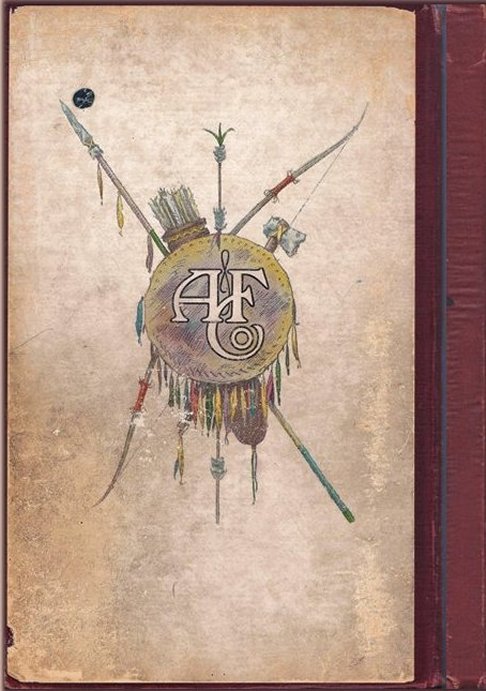 
Pictured above is a very unusual 1923 Abercrombie & Fitch catalog, unusual in that it was originally printed for A&F as a special hardbound version. The catalog has but 123 numbered pages and yet is a large 11¾ inch x 7 inch x ¾ inch thick catalog, with almost every page separated by a semi-transparent, tissue type page. There were probably only a few of these hardbound versions printed, to be used by A&F personnel/employees in various departments to mark up any merchandise item price changes or identify discontinued products. This hardbound type of catalog would be available at the counter of various departments for the customer. This particular catalog was used by the A&F mail service department as indicated by an added hand written in black ink statement on the front cover titled April 19, 192x. Page 5 in the bottom margin, hand written in black ink, specifically states: Revised prices corrected to Apr. 10, 1924.
The cover page is titled WHERE THE BLAZED TRAIL CROSSES THE BOULEVARD, picturing a Buffalo in profile, described by A&F on page 1 as: The Buffalo which adorns the front cover of this catalog is a particularly appropriate emblem of the Abercrombie & Fitch Co. establishment – “Greatest Sporting Goods Store in the World.” The Buffalo scene was used on the cover of several future A&F catalogs. The phrase “Greatest Sporting Goods Store in the World” interestingly, was finally registered in the United States Patent office by A&F in 1928, used with a new logo to be affixed on apparel. The rear cover of the catalog pictures a special Indian scene which reflects the research by A&F that went into for the selection of the catalog cover designs, front, and rear.
Unfortunately, the catalog contains no advertisements for the Luger or holsters, pistols or revolvers of any kind except for one page on SHOOTING ACCESSORIES. Perhaps, in the case of the Luger, the 1923 commercial P.08 30 Cal models were not yet available in early 1923. However, the catalog does have a Gun Index on page 136 and states on page 128 that any questions regarding guns be directed to the Gun Department.
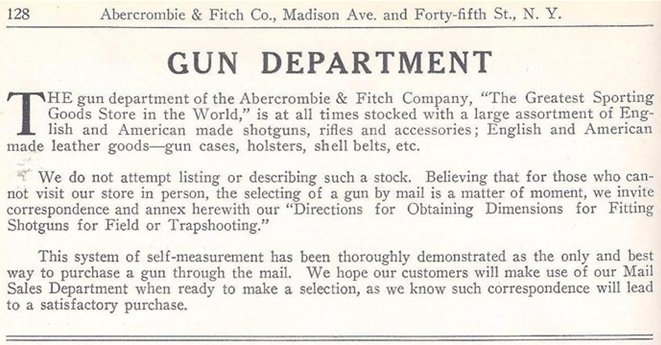
There is another reason for the lack of any weapon advertisements in the 1923 catalog. It is because in the 1920's, A&F occasionally issued two or more catalogs per year, one for the summer season, which featured camping and fishing equipment, and one for the winter season which featured hunting and shooting merchandise. The catalog shown above is apparently a summer season catalog. It is difficult to identify the catalog's season because externally the covers are identical. It is necessary to see the contents to positively identify the correct season; summer or winter. In any event, the only Luger mentioned would be for a single model, the post war DWM manufactured 30 Cal 98 mm commercial Luger. The heyday for A&F catalog advertisements for Lugers and holsters was over by 1913 – 1914, with the advent of WWI.
The last foray for A&F and Lugers was the special order and sale of approximately 100 Swiss crested long frame 4¾ inch Abercrombie & Fitch - New York – Made in Switzerland Hammerli barrel roll die inscribed, imported commercial Lugers, 51 in 30 Cal and 49 in 9mm in about 1921-22 per C. Kenyon in Luger: The Multi-National Pistol, page 134.7 These early 1920's post war commercial Lugers, specifically ordered and assembled by Hammerli in Switzerland for A&F were numbered in the 2000-3000 i suffix range. The 1921 – 1922 manufacturing time frame is generally accepted by most Luger authors and collectors. With that said, it is unusual that the 1923 catalog does not advertise these special A&F marked, imported Lugers as these special marked Lugers would not sell out in one season. They could be advertised in the 1922 catalog, or later in the 1924 catalog, but unfortunately, these catalogs are not available or as yet identified. Please go to the 1930 catalog for more information on the 1921/22 A&F Swiss crested lugers special order.
Close section.
| |
| |
The 1930 A&F catalog
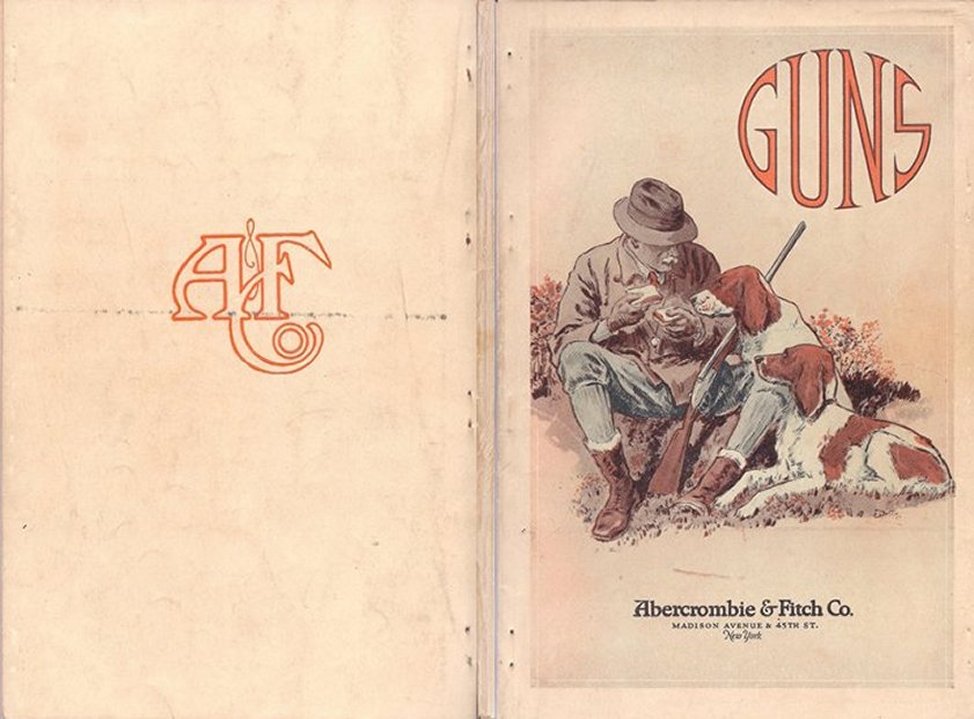
Pictured above is an original 1930 Abercrombie & Fitch catalog. The catalog contains 184 numbered pages, including an original, intact perforated, single page, 1-sided orange color order form. The publishing date is verified by the copyright statement on page 1. This is the second catalog published since Abercrombie & Fitch and Von Lengerke & Detmold, Inc. merged as described in the INTRODUCTION page, and as indicated by the cover page title, is completely dedicated to GUNS. Every even numbered page has the A&F logo and every odd numbered page has the VL&D logo.
The 1930 Abercrombie & Fitch cover page artwork is one of their less inspiring endeavors, featuring a hunter and his hounds, taking a lunch break, set in a pale yellow background. However, the catalog information pertaining to the Luger is most interesting, featuring ads for Luger ammunition, 30 Cal on page 127 and 9 m/m on page 128, Luger holster ads and a most controversial, debatable description of Lugers and Luger holsters for sale, postulated by E. Bender in his 1991 book Luger Holsters and Their Accessories.
Bender in Luger Holsters and Their Accessories on page 534 pictures an A&F full cover flap holster with an A&F logo snap fastener with a caption stating that the specific pictured holster was advertised for $2.50, along with the special 1921 - 1922 special A&F imported and marked Lugers in the 1930 A&F catalog for $40.00. The 1930 A&F catalog has a copyright statement on page 1 and states on the introduction page that Von Lengerke & Deltmond, Inc. are now housed in the same building at Madison Avenue & 45th Street. The 1930 catalog reflects that with the A&F and VL&D triangular logo on alternating pages. Pictured below is a very early, circa 1902 VL&D holster made for a revolver, prior to the merger with A&F, with an earlier VL&D logo.
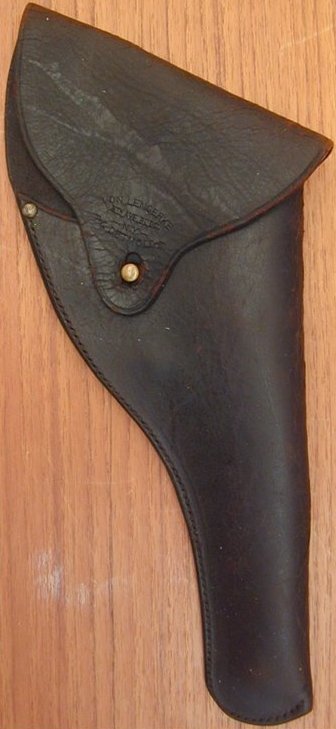
Mouse over the picture to see the back of the holster.
Bender claims that on page 107 of the 1930 A&F catalog in the text description there is an advertisement for a 4¾ inch 30 Cal grip safety Luger for $40, identified as A&F stock No. F410 with a “Plain flat walnut stock” or board-stock accessory for $5.00. The $40 price is the only convincing aspect to the ad that errs toward the 1921-1922 special order A&F Luger, where the standard period price for commercial Luger was $25. Yet, an equally interesting aspect of the ad is what’s missing, and that is there is no mention of the 4¾ inch barrel A&F barrel marked 9mm Luger. However, illustrated on page 109, also identified as A&F stock No. F410 is a standard P.08 style, no grip safety 3 7/8 inch 30 Cal barrel commercial Luger, without a stock lug. This full page advertisement on page 109 in the 1930 A&F catalog with a Luger at the top, new A&F stock No. F410 and other pistols and revolvers, is a direct copy from an earlier 1927-28 VL&D catalog, page 106. The only difference is the original VL&D Luger stock No. G410 which represented the VL&D available stock when they were located at 314 Madison Avenue, New York. and as such, has no connection whatsoever with the preceding page 107 Luger advertising text description.
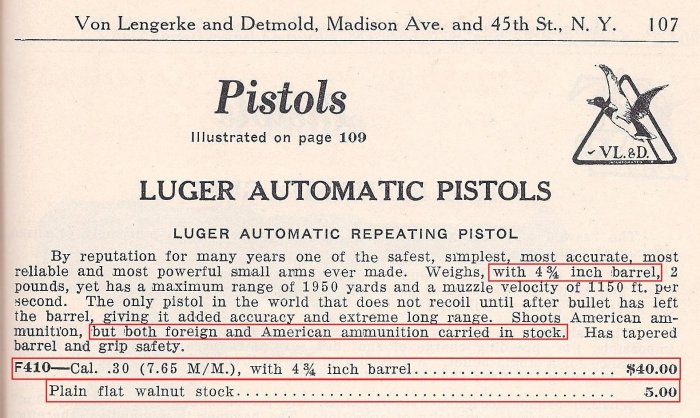
Since the small batch of 100 4¾ inch roll die stamped barrel Lugers, fifty-one in 30 Cal and forty-nine in 9mm, did not have stock lugs, it is curious that A&F would advertise a “Plain flat walnut stock” for $5.00 as an accessory in the 1930 catalog. Therefore, these Lugers described in text cannot be advertising the early 1920's special imported A&F roll die stamped 4¾ inch Swiss Hammerli installed barrel Lugers. This is not the first time A&F has had misleading Luger descriptions in their catalogs, yet without further information one cannot be certain the advertising description is for an A&F Luger. Also, by 1930 the only available new Lugers on the market, not absorbed by A.F. Stoeger, would be standard DWM/BKIW P.08 style 98-100 mm short barrel 30 Cal commercial lugers. It is possible that these 100 special imported and marked A&F Swiss chamber crested Lugers, fifty-one in 7.65mm and forty-nine in 9mm caliber, were never advertised in an A&F catalog, in text or pictures, as Kenyon states at the front end of his excellent and thorough description of the special A&F Lugers in Luger: The Multi-National Pistol on page 1347 that: In approximately 1921-1922, Abercrombie & Fitch offered Lugers to the public through its retail stores. – specifically, with no mention of any A&F catalog advertisements.
Additional discrepancies with Bender’s claim is the matter of the page 534 pictured holster, being advertised in the 1930 A&F catalog for $2.50. Heiser holsters are advertised on pages 166 and 168 with corresponding opposite page illustrations on pages 167 and 169. The holster for a Luger listed for $2.50 is on page 168 titled: HEISER LOOP STYLE BELT HOLSTERS, described as:
HEISER PLAIN FLAP BELT HOLSTER
These holsters are made of heavy oak tanned oiled California skirting leather, waxed, threaded sewed, reinforced at ends, durable snap button on flap, and closed end. Belt loop sewed on back. For revolvers and automatics.
No F2310. For……automatics……7.65 Luger, 9mm Luger.

Unfortunately, the No. F2310 holster illustrated on page 169 is for a revolver with a completely different style cover flap and holster body style. Although these advertised holsters are Heiser made it is not certain that they correspond to the page 534 Bender A&F holster since there is not a picture of the Luger holster in the 1930 A&F catalog. Also, it is difficult to determine if the pictured A&F holster on page 534 of Bender's book is even of Heiser manufacture.
Close section.
| |
| |
The 1941 A&F catalog
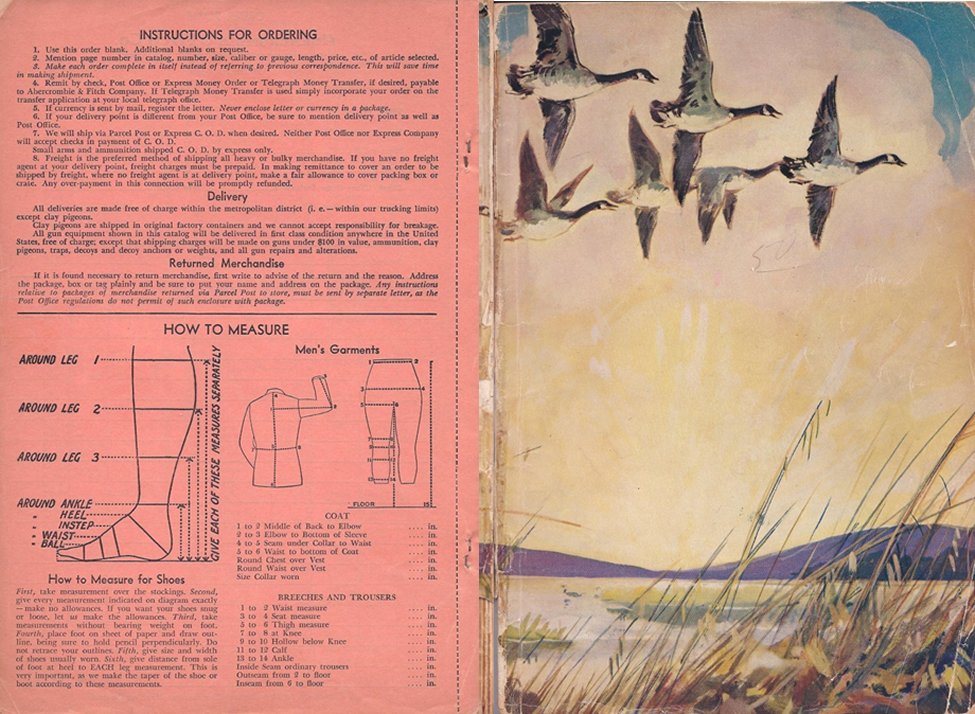
Pictured above is a rather large 6½ inch x 9¾ inch format 1941 Abercrombie & Fitch catalog, consisting of 136 numbered pages. The catalog is intact, except for missing the rear cover. Side two of the detachable pink color order form now serves as the rear cover. Although this catalog was advertised as a 1941 catalog, a company named Cornell Publications offers a copy of a 1941 A&F catalog for sale except with the year 1941 and the stylized A&F logo printed in red on the cover. Both catalogs have the same subject of migrating geese on the cover except with a slightly different formation and background.
Page one of the subject “1941” catalog is entitled: Sporting Guns, and written in pencil in the upper right hand corner is the year 1941, probably put there by a previous owner/collector. Also, side 1 of the catalog order form has an order date line entry entitled: Date…………………………………194. This is a typical order form date entry, leaving the last digit of the date to be filled in by the ordering customer. Although the date of the catalog is firmly corroborated by the 1941G order form identification date, located in the lower left corner of the side 1 order form. This dates the catalog to exactly 1941.

The page one statement of “Conditions abroad have not materially curtailed our supply of foreign-made guns. We still offer an unusually wide selection of fine imports” suggests war in Europe, but not yet the United States entry into World War II, which also tightly dates the catalog to early or mid-1941. Since there are no published A&F catalogs identified beyond 1941 – 1950, one of the two 1941 catalogs pictured is suspect. The copied catalog was possibly not published in the 1940's and without a dated copyright statement or an intact, dated order form, which is invariably missing in the copied catalogs and rarely found in the original catalogs, it will be difficult to date. This is especially true as many United States catalog publications ceased in the war years. Additionally, in support of the lack of A&F catalog printings in the war years, a 1950 A&F used guns catalog states that:

All of the original A&F catalogs featured in the catalog section of this article lack a date on the catalog cover, with exception of the 1904 and 1907 catalogs. Coincidently, these are Cornell Publication copies. However, most of the catalogs featured in this article, original and copies, have an inside copyright statement identifying the printing date. The exception is the no cover date, 1941 catalog, which does not have a dated copyright statement at the beginning of the catalog. The only printing information is on the index page with the generic statement; Printed in the U.S.A.
The 1941 A&F catalog and the Luger
On to the more important aspects of the 1941 A&F catalog, which is to the advertising status of the Luger pistol and accessories. There are no Luger pistol ads, as by 1941 A&F had finally sold off their slow moving 1921, 22 import of 100 Swiss crested, 4¾ inch barrel A&F roll die stamped inventory of 30 Cal and 9mm Lugers. Also, all exports of commercial Lugers from Germany had essentially ceased mainly because of limited German Luger commercial production due to the demands of German war production. The exception is for a few Mauser commercial Lugers made mostly for German domestic consumption. There is also the exception of A.F. Stoeger, Inc., which still had Luger inventory from the 1930s as they advertised Lugers into the early 1940s.
The subject, no cover date or A&F logo 1941 catalog does, however, contain ads for domestic Luger ammunition in 30 Cal and 9mm, made by Remington and Winchester on page 101, and ads for imported Luger ammunition on page 104. Pages 112 and 113 consist of full page ads for Heiser holsters, pictured and described for revolvers and automatics, including the Luger. Interestingly, an Audley Safety holster, A&F No. F2484 is pictured on page 114 with an unidentified logo.
The most interesting ad for Luger accessories is on page 98 for aftermarket A&F No. F1373 Automatic Pistol grips: Pearl $18.00, Ivory $18.00, or Stag $12.00.
Close section.
| |
Holster summary
Of the several Abercrombie and Fitch holster variations discussed and pictured herein, only one, variation 3, can be attributed to a specific leather maker, namely H.H. Heiser. The variation 1 holster is certainly a holster ordered through one of several Abercrombie & Fitch retail outlets, based on its general style and pictured in the 1910 A&F catalog. Variation 2 is no doubt a special A&F order, however the specific style is not pictured in any known A&F catalog. Although, both variations 1 and 2 share certain pattern similarities. The variation 4 holster is the most obscure style, although it has a common P.08 full bucket style cover flap. It has not been previously associated with A&F, yet is undeniably an A&F ordered holster based on the A&F trademark logo, which is identical to the variation 1 circular logo. There is the possibility that the logo is a fake. However, since it is located on such an obscure style holster that possibility does not seem probable. Although it was stated earlier to be imported, the variation 4 A&F holster could be just as plausible of domestic US manufacture, possibly K-Leather Products, Inc. of New York. Coincidentally, no A&F marked K-Leather Products, Inc. New York holsters have ever been identified, or at a minimum, published.
As mentioned in the background information at the beginning of this article, there were two known A&F leather holster suppliers, H.H. Heiser of Denver, Colorado and K-Leather Products, Inc., New York. This information was published in a Guns and Ammo mini manual in 1973. In 1992 (19 years later), Eugene Bender identified the same two holster manufacturers or suppliers in his book Luger Holsters and Their Accessories.2 Therefore, the two holster manufacturer proposition as the sole source or suppliers of A&F marked holsters was basically accepted unquestioning. It is interesting that no Luger author or collector has challenged the two A&F holster supplier proposition, presented in 1973 to the current day, 37 years later, especially interesting since no A&F logo marked “K-Leather Products Inc., New York” holster has ever been identified.
As it turns out, there were actually several American holster leather makers that sport the A&F Co trademark logo. Ironically, with the most recognized A&F holsters discussed and pictured herein, only two holster makers, possibly three, are identified; With the death of Frank Audley in 1916, the company was sold to Folsom with a subsequent change to the Audley safety holster trademark logo with Audley, Heiser and Lawrence. The identity of the other holster makers or suppliers to A&F remains a mystery.
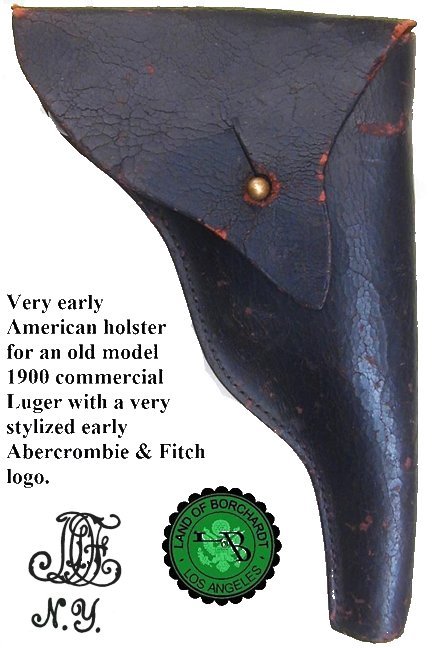
Click on holster to view other images.
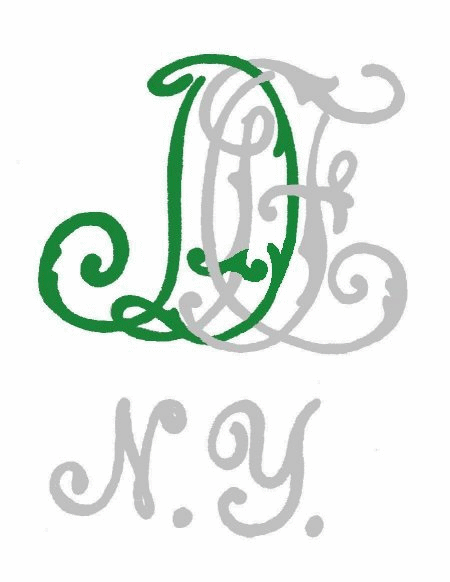
Early 1900 A&F logo
Hide holster.
Pictured is one of the very first known and identified holsters offered for sale by Abercrombie & Fitch, identified as variation 7, specifically for the newly introduced DWM Model 1900 commercial 30 Cal Luger or THE LUGER AUTOMATIC PISTOL. A similar holster style is listed and pictured on page 125 of the 1903 Abercrombie & Fitch sales catalog, the company then being located at 314-316 Broadway, N.Y., having the destinction of being the first known A&F catalog to offer the new model 1900 Luger. A very distinct holster, and certainly very early, as well as obviously owing a lot to early DWM holsters in its styling and other properties. The styling and other properties are discussed in great detail in a recent 2010 three-volume publication titled Pistole Parabellum by Görtz/Sturgess in Volume III, page 1241, Chapter Forty-One titled: Prototype and Early Old Model holsters. Rather than break down and discuss the properties presented by Sturgess, which is quite lengthy, in relation to the variation 1 holster, the information is best presented in its original format.
The holster is of light weight construction, weighing in at a mere 122 grams or 4.3 ounces, using very thin 1.75 mm thick leather, which is in good condition, considering its age of at least 108 years, with all the stitching intact and with no separation or tears to the leather. The holster body silhouette is very slender, similar the very early Swiss Ordnance holsters for the 1900 Luger, except it has a plug at the holster body toe. As in the early Swiss ordnance holsters, a 1900 commercial Luger fits snugly in this holster with the cover flap closed. The very stylized cover flap plain edge nor the straight line, down angled holster body plain entrance have border piping. The belt loop is narrow, yet rather long, being 1 inch x 3¾ inch and is attached to the backside of the holster at an angle by single line of stitching at the top, then folded over and terminating at the lower end in a triangular shape, secured, also by using a three-sided triangular stitching pattern.
There can be no doubt as the authenticity of this holster as the overwhelming evidence presented in pictures and text description in the 1903 Abercrombie & Fitch catalog and the holster itself, although, it is a special order holster as the 1903 catalog does not specifically list, describe or picture a Luger holster. The similar style holster pictured in the 1903 catalog on page 125 is described in the text as for .38 and .44 caliber pistols, but there can be no mistake in the commonality of style and shape of the pictured catalog holster, as compared against the variation 1 holster, especially the very distinctive cover flap design, right down to the exaggerated or elongated length of the cover flap slit for the holster body brass stud. The holster has the added distinction of having the very first Abercrombie & Fitch, very uniquely stylized, two inch high logo on the rear of the holster, which supercedes, by several years, the well recognized, relatively speaking, Abercrombie & Fitch circular logo. The logo has to be a stamping as the right side is deeply stamped whereas the left side is faint, the outline being barely discernable, requiring reconstructing the logo. The reconstructed logo is presented as a “mouse over” overlay.
On page 149 of the January 1903 dated A&F catalog is also the first published Abercrombie & Fitch ad for the model 1900 commercial Luger entitled: THE LUGER AUTOMATIC PISTOL with the following text description:

And it gets better, as the identical description found in the catalog, is located, in the form of a label, in the identical font size and style and character placement as the catalog, being affixed to the inside surface of the cover flap, being placed there either by an Abercrombie & Fitch store employee or the consigned holster maker, leaving no doubt as to what pistol belongs to the holster, namely the Old Model 1900 commercial Luger. In the March 1, 1904 dated A&F catalog the Luger is again advertised on page 149, however, the descriptive text has changed slightly, not mentioning, for example, Walsrode powder nor the weight of charge. This pretty much localizes or associates the variation 1 A&F holster with its inside cover flap descriptive label as being ordered directly from the 1903 A&F catalog.
Abercrombie & Fitch was founded in 1892 in New York by David T. Abercrombie who owned a small shop and factory3 producing camping equipment in lower Manhattan, joined by Ezra H. Fitch in 1900 becoming the co-founder and by 1903 was a well established firm, however, at the time sold much of its wares by mail order catalog. Therefore, one possible, reasonalble scenario would be, that the variation 1 Luger holster was a special order, placed through the catalog by a customer, which was subsequently made a by a domestic leather maker to A&F specifications, including the very unique A&F logo, shipped by A&F directly to the customer with the descriptive label affixed to the inside cover flap surface, identical to the 1903 A&F catalog Old Model 1900 commercial Luger ad descriptive text shown above.
It is ironic, that on the same page advertising the M1900 Luger, is an ad for the Ideal Holster, when the real prize for collectors, is that the first A&F holster for the M1900 Luger has always been, but not recognized, on page 125 of the January 1903 dated Abercrombie & Fitch catalog, waiting to be discovered. Interestingly the Ideal Holster is not mentioned or advertised in the 1905 and later A&F catalog ads for the Luger Automatic Pistol.
Even though A&F holsters were special ordered, there may not be many examples in existence of the variation 1 holster because the 1903 Abercrombie & Fitch customers that owned or wanted to buy a Luger or Luger holster, who looked in the catalog, on the page with the Old Model 1900 Luger ad, were possibly misled by the same page ad for the Ideal Holster and Stock, at the time a very popular accessory for the new Luger. The customer, possibly not familiar with the special order process, believing the Ideal holster as the only holster offered by A&F for the Luger, combined with fact that the actual page with the holster ads, despite picturing a facsimili of the variation 1 holster, did not list the Luger as being available in that style, could have contributed, at the time, to a perceived unavailabiliy of a regular belt loop A&F Luger holster. However, with the identification of the variation 1 A&F holster, it appears, apparently, there were some special orders placed, and there is the additional possibly of the existence of a more gramorous “twin sister” lurking in a closet or gun shop somewhere, as pictured next to the variation 1 holster in the 1903 A&F catalog is the same style holster, but with a “Mexican pattern”.
Another factor contributing to the extreme rarity of the variation 1 holster, which, as mentioned above, was never acutally offered in the 1903 catalog, as a Luger holster is that the 1905 and 1906 dated issue of the A&F catalog, the company, now at 57 Reade Street, N.Y., pictures a completely different style holster, for the first time, specifically made for A&F, now probably for the old and new model Luger, identified as No.3. Heavy black harness leather, for Luger Pistol. Curiously, the same style of holster pictured in the 1903 catalog, is also pictured in the 1905 and 1906 catalog ad, on the same page as the Luger holster No.3, yet, specfically described as: No. 1 Plain Russet leather, with flap for small pocket revolvers. Probably, one could still special order the No.1 holster style for a Luger, but the style of the Luger holster was changing, as evidenced by the 1905 and 1906 catalog pictured Luger holster No.3, which looks more like the 1909 and 1910 A&F catalog, final full cover flap, button snap fastener holster offering.
It has been suggested that the variation 7 A&F holster was the same holster offered by Hans Tauscher, who was the turn-of-the-century DWM 1900-1916 representative in the United States, however, the holster offered by Tauscher in his early circa 1911 - 1914 catalogs, is, overall, of a slightly different shape and design especially the back side and with a snap fastener design vs. the slit and stud closure of the A&F holster. The variation 7 A&F holster being offered as early as 1903 vs. the Hans Tauscher holster offering, first seen in the Tauscher sales about 1911. However, with both holsters sharing similar characteristics, it is possible that the Hans Tauscher holster was being offered and sold much earlier, yet it shares the basically identical snap fastener closure method of the A&F Luger and other holsters pictured in the 1909 and 1910 A&F catalogs. Click here to read more about the Hans Tauscher catalog holster offering.
To be expected, Tauscher offers a neary identical period text description of the model 1900 commercial Luger in one of his early circa 1907 three page brochures, with the following exception, the rimless cartridges offered uses DWM exported rimless Rottwiel smokeless powder cartridges vs. the rimless Walsrode smokeless powder cartridges listed in the 1903 Abercrombie & Fitch catalog description, which is interesting, since both Walsrode and Rottwiel appear to be of German origins, both being original DWM offered ammunition.
A major European collector initially thought that the 1903 A&F catalog ad citing of Walsrode Smokeless Power cartridge loading for the Old Model Luger was a mistake or printer’s error as the only Luger ammunition available was period DWM export 30 Cal Rottweil. However, if that is the case, if a mistake or printers error, then several period American advertisers of the C93 Borchardt pistol and the Luger Automatic Pistol are guilty, because as early as a February 1899 Shooting and Fishing magazine ad for the C93 Borchardt pistol and a 1900 Schoverling, Daly & Gales magazine ad, also for the C93 Borchardt pistol, list Walsrode Smokeless Powder, including a 1902 William Reed and Sons ad for the C93 Borchardt pistol that specifically states : Adapted to Walsrode powder, as do several period ads for the Luger Automatic Pistol, being a 1902 Schoverling, Daly & Gales ad, the 1903 A&F catalog ad and a circa 1903 A.H. Funke catalog ad. The circa 1902 – 1904 English language, RED cover “PARABELLUM” owners’ manual lists Rottweil pistol powder, in leaves, however, is understandable, being a DWM manual and DWM ammunition.
Walsrode and Rottweil powders coexisted from the late 1890s, and it has been verified that the 30 Cal Walsrode ammunition was offered, first with the C93 Borchardt pistol and with the early American Old model Lugers by the Union Metallic Cartridge Company or UMC, as the American ads specifically or unequivocally state: Cartridges loaded with Walsrode (smokeless) powder. Per enquiries through the IAA or International ammunition Association, evidence in the form of UMC load records exist as early as 1901 showing Walsrode .30 Cal loading. Since all the later pre WWI Luger commercial ads, American or European, including the DWM issued new model instruction manuals for the commercial Luger, drop any reference to Rottweil or Walsrode Luger cartridge loadings, as the novelty or newness of Smokeless Powder fades, the question becomes mute.

These are comments extracted from the responses given in the IAA forum concerning Walsrode vs. Rottwiel powders.
UMC began making 30 Luger ammunition in 1901 and UMC was using Walsrode powder at this time. The A&F ad was probably referring to UMC ammunition instead of DWM ammunition, which was using Rottwiel powder. The thread also includes another ad for the Luger picture that offers ammunition loaded with Walsrode powder so clearly the A&F reference to Walsrode powder is not a mistake. Lewis Curtis.
While I have no information on DWM production of the 765 mm Parabellum cartridge in its earliest years, a dealer like Tauscher would almost undoubtedly have been right, and as mentioned, they showed the powder in the ammunition they sold in this caliber as being
Rottweil. Their ammunition was very likely, in 1906, of DWM manufacture.
UMC began making the cartridge the first of October 1901. By November 1901 they were making it on the same line as they were using for the 7.65 Borchardt and 7.63 Mauser ammunition. The first .30 Luger rounds were FMJ (full patch) with a jacket of 1-20 tin, and were not crimped at the mouth. The mouth was "burred" on the outside but not the inside.
In December of 1901 they were making both FMJ and Soft-point bullets for this ammunition.
In April 1903, "demanded by the Pacific Coast Trade," they began making a FMJ hollow-point bullet, with the HP cavity wax-filled. This sounds very much like a copy of the DWM early HP bullets.
There is no mention in the notes I have of the powder used. However, UMC had commenced making the 7.63 mm Mauser round and the 7.65 mm Borchardt round in April 1899 (possibly earlier, based on a February 1899 C93 ad), changing the name of both to simply ".30 Cal.," and there is a note from April 1901 indicating that they had changed to Walsrode Shot Gun Powder. No mention was made of the powder it replaced. The
Walsrode powder continued to be used until May 1911, when they changed again to Bullseye powder.
This suggests that the brand of ammunition being advertised by Abercrombie & Fitch was that of the Union Metallic Cartridge Company, but of course, it does not prove that. I do not have that advertisement but assume from the Curtis posting that the (A&F) ad did not specify the powder (it did specify Walsrode powder). John Moss
John Moss and I both have access to a copy of the original UMC load records, so there is no question on the dating that John Moss provided. There appear to be less than a dozen copies floating around.
UMC didn’t only load for the US market. They initially made the 7.65mm Browning in 1899 which is the same year FN introduced the Browning pistol and 32 ammunition. This production was for the South American market. The UMC production records indicate they “Commenced Making” both the (Luger) pistol and (carbine round?) on 1 Oct 1901. No question about it. Lewis Curtis.
Hide insert.
A thorough search of the United States Trademark Patent Office archives reveals scant information as to when Abercrombie & Fitch first applied for and registered their well known and recognized circular style Trade-Mark logo. Four documents were found that renewed the “original” logo Trade-Mark registration: in accordance with the (Library of Congress) act of February 20, 1905. Trade-Mark 239,578 was registered Mar. 6, 1928. In the body of the application text states that: The trade-mark has been continuously used in the business since about January 1904. This is a very interesting statement as the phrasing “has been continously used” does not necessarily mean the logo was registered throughout that time period and that the U.S. Patent Office records show the earliest A&F trademark logo registration date of 1927. Since all the patent related documents pictured in this article were obtained from the U.S. Patent Office records, through a multitude of different search routines, they had to have been eloctronically scanned in recent times, therefore, there is the possibility that some documents were missed or omitted. The statement of: since about January 1904 also indicates that the Abercrombie & Fitch Company, as of 1928, was not sure, themselves, when they started using the circular logo. Though the absence in the records of an earlier registration date does not mean it doesn’t exist, as the 1905 publication A&F catalog on the inside cover page states: Entered according to act of congress, in the year 1905, by Abercrombie & Fitch Co., New York, in the office of the Librarian of Congress, at Washington, although, seeming more like a “Patent Pending” or copyright statement, rather than a “faite accomplie”.
As mentioned above, despite the date noted in the 1905 catalog, It is not clear if the statement refers to the trademark, or a simple patent or a catalog copyright statement. Even with the lack of a publication date, the date of the 1905 catalog is established by the pre-1906 57 Reade St. N.Y. U.S.A. catalog cover addresss and the May 1st, 1905 dated page 3 introduction statement. The 1906 A&F catalog, though, does specifically state on the inside cover page a copyright date of 1906 and their new catalog cover address of 314-316 Broadway N.Y. U.S.A. with a full introduction May 1, 1906 dated page explaining their move. As a matter of note a trademark logo is a patent office registration process, not a copyright.
The January 1903 dated A&F catalog has a general copyrighted statement but it is page 2 of the 1909 A&F catalog is the first catalog that does have a very exact and succinct copyright statement: Illustrations and Text Copyright 1909, by Abercrombie & Fitch Co., N.Y. along with the second A&F logo associated with the words Trade – Mark on each side of the logo with the below caption: REG. IN U.S. PATENT OFFICE and despite no surviving U.S. Patent Office original A&F Trade-Mark application and registration documents, there is no doubt that the A&F Trade-Mark logo was registered in the 1906 – 1907 time frame. The 1907 catalog is the first to have an A&F logo on the cover, very significantly, with the words Trade-Mark placed in the lower left corner of the logo, under the A.
Per the 1937 U.S. Patent Office registration dates of both the (25 May) A&F Trade-Mark 346,370 and the (15 June) A&F Trade-Mark 346,982, interestingly with slighly different logos, the statement says: The trade-mark has been continuously used and applied to said goods in applicant’s business since January, 1900…. Why the A&F revision to exactly “January, 1900” in the 1937 resistration statements from “about 1904” in the 1928 239,578 Trade-Mark registration may never be known, but is contradictory and certainly diminishes the accuracy of the patent records and of the Abercrombie & Fitch company records, to establish the introduction date of the A&F trademark logo. This is confounded by the two different style 1937 346,370 and 346,982 A&F Trade-Mark logos, of which both are slightly different from the “original” A&F logo.
Based solely on the early surviving A&F sales catalogs the introduction of the “unregistered” logo is 1905, as pictured in the 1905 and 1906 catalogs, whereas the 1904 A&F catalog, other than the March 1, 1904 dated introduction page with no copyright statement, and the catalog makes no reference to, or pictures any A&F logo, be it the 1903 catalog apparenly registered “Hitch Rope” Trade-Mark logo nor the new 1905 A&F catalog circular logo and it isn’t until the 1907 catalog on the cover that the logo is accompanied with the words “Trade-Mark”.
The introduction of the A&F circular logo cannot have been in use since January, 1900 because as of the January 1903 dated A&F copyrighted catalog, appearing only one time on page 159 is a curious, obscure design A&F registered Trade-Mark logo, mentioned above, consisting of an entwined rope or twine and hook, with very small text in three lines: TRADE – ABEFIH - MARK in the center of the logo. The 1903 A&F catalog logo design was, apparently, based on a “Hitch Rope”, a.k.a. “cincha” advertisement pictured in the 1903 A&F catalog on page 70. This early A&F logo design was superseded, as stated above, in 1905 by the final, well recognized circular design A&F company logo which first appeared, as mentioned earlier, on page 301 and the rear cover of the 1905 and 1906 A&F sales catalog and on with a full introduction of the new company, now registered, official Trade-Mark logo, prominently featured on the cover page of the 1907 catalog. Pictured below are the original U.S. Patent Office manila folders with chronological date entry histories of the various surviving A&F submitted patent registration document contents.
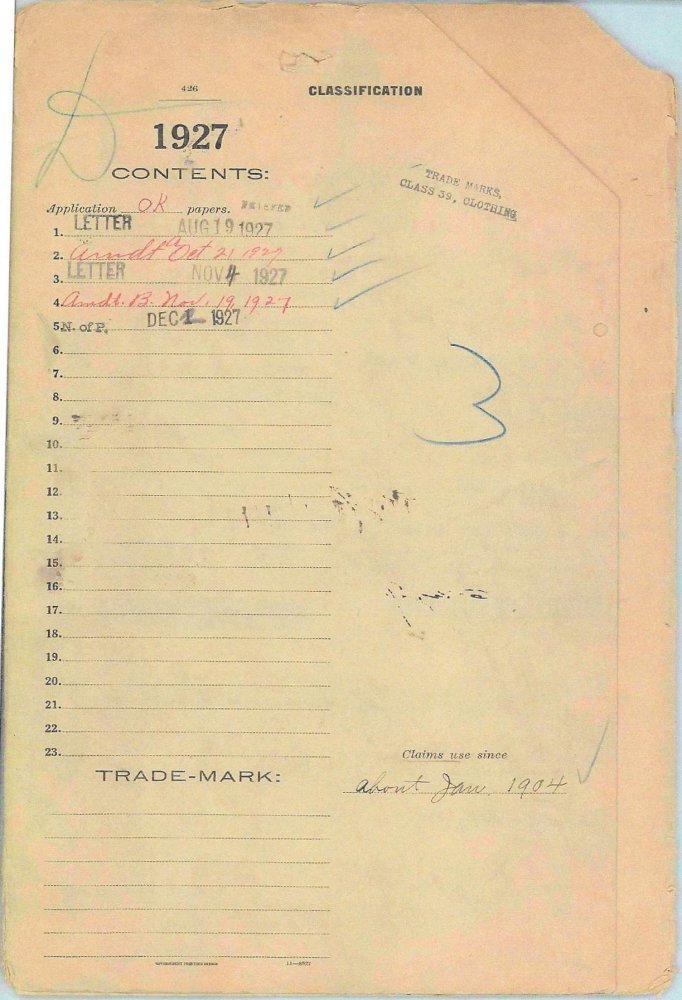
Previous Folder Next Folder
Another interesting A&F logo sample or specimen, one of five specimens submitted, was found in the archives entitled: “Sportsmark of the Nation”, with the A&F Trade-Mark logo, to be affixed to clothing apparel, with the then current company address of Madison Avenue & 45th St., New York, submitted July 15, 1927 as attested by the 1927 patent date stamp on the back side of the sample and registered March 6, 1928 as Trade-Mark 239,578. Both the certificate of registration and specimen were filed in a manila folder with an affixed, modern bar coded label and Filing Date of 07/15/1927, Registration # 239578 of which still resides in the U.S. Patent Office archives.
David T. Abercrombie apparently did register a trade mark sometime between 1892 and 1900 as part of the “Abercrombie Company” he originally founded in 1892, in his name only, well before Ezra H. Fitch joined the company, as one such logo survives on a holster modified for a Smith & Wesson Schofield revolver.
Conclusions
Regarding the A&F variation 7 holster, it will never be known why or who chose the unique, very stylized one-on-one A&F logo, Abercrombie & Fitch or the holster maker, but probably Abercrombie & Fitch as it is somewhat similar to the new 1905 company logo with the same, however much simplfied, yet still entwined A&F letter character design, but in a circular pattern, very convenient for a circular snap fastener, although the A&F embossed snap fastener didn’t appear, at least until 1909, based on the catalogs, as the 1905 and 1906 A&F catalog Luger holster ads still used/pictured the brass stud and leather slit method. Nevertheless, the variation 1 holster is the first and only published instance of this style of A&F logo being used on a Luger holster, made for A&F or any other A&F product.
In summary, the variation 7 Abercrombie & Fitch holster represents the first in a series of special order, full cover flap holsters, made for Abercrombie & Fitch catalog customers for the 1900 and possibly the 1906 30 Cal, 4¾ inch barrel commercial Luger with a unique, very stylized A&F logo, which never made it to trademark status, seen only, to date, on one very early A&F logo stamped holster, made for an early manufacture 1900 old model Luger.
| |








